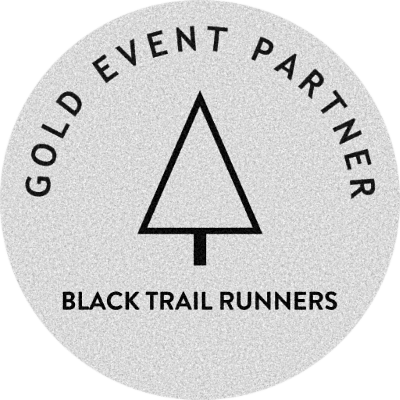3 Jun 25 by James Elson
South Downs Way 50km 2025 Mens Preview
The 2025 South Downs Way 100 and 50km are right around the corner and the inaugural edition of the 50km has attracted a stellar field for this first outing. As part of the World Trail Majors - Short Series, we've got both international and domestic atheltes vying to take home maximum points and be in the running for the overall standings.
In the build up race Weekend we will be previewing the leading contenders for the top spots in four separate posts. We have already previewed the womens and mens SDW100 fields, below is our SDW50km Mens Preview.
You can see full details of the Elite SDW50km Womens Field here.
You can see full details of the Elite SDW100 Womens Field here.
You can see full details of the Elite SDW100 Mens Field here.
Stay tuned to the website and our YouTube channel in the lead up for race day for links to the live broadcast, tracking and results:
Robbie Simpson (ITRA Rank: 899): Robbie is an extraordinary athlete both in terms of his ability and achievements but perhaps more so, his versatility. His road marathon background is extensive, with a Commonwealth Games Bronze medal to his name from Australia 2018 and a PB of 2:14 set at London in 2019. He's also run in a string of Commonwealth, European and World Mountain Running Championships with a best of second in the European Seniors and Bronze at the Worlds in 2015. His streak of results at Sierre Zinal is absolutely incredible with over a dozen finishes, coming away with second, three times. He turned to ultras in 2019. Since then he has twice finished on the podium at OCC, won Ultra Trail Cape Town 55km twice (one of our other World Trail Majors Series events) and set lots of course records back in Scotland where he originates from. In February he was second at the Tarawera 50km by UTMB.
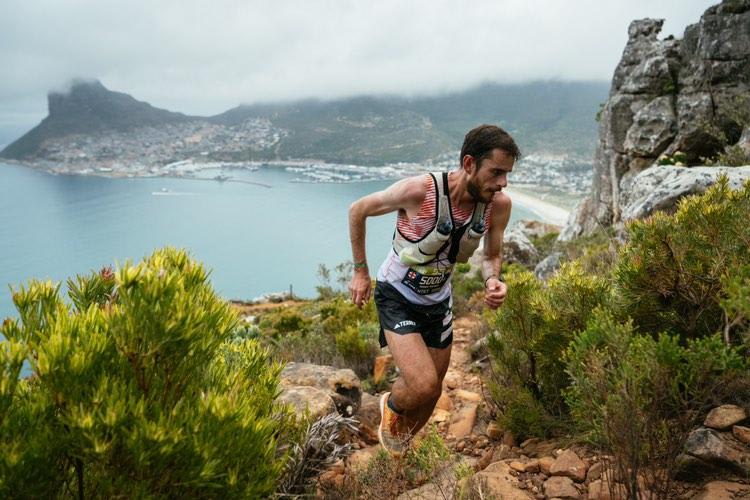
Robbie Simpson
Tiago Vieira (ITRA Rank: 881): Portuguese athlete who is off to quite the sensational start to 2025 already. He was third at the Transgrancanaria Marathon in February and second at the MIUT 60km in May - both World Trail Majors events which puts him top of the Short Series rankings so far this year by some margin. He's also finished 7th at Tenerife Blue Trail Half Marathon and won two other separate 50km races. A specialist over distances ranging from 20km to 60km, Tiago has also won scores of other events within that range - but notably the Grand Raid Pyrenees Marathon twice.
Eduard Hernandez (ITRA Rank: 857): Currently in third place on the World Trail Majors - Short Series Rankings for 2025. Eduard's two counting races so far in 2025 were Hong Kong 100 - 57km where he was eighth and the TransGranCanaria Marathon where he was eleventh. Has lots of high level finishes at shorter trail races to his name including wins at Tenerife BlueTrail 23km and MIUT 16km, but has done particularly well in the mountains.
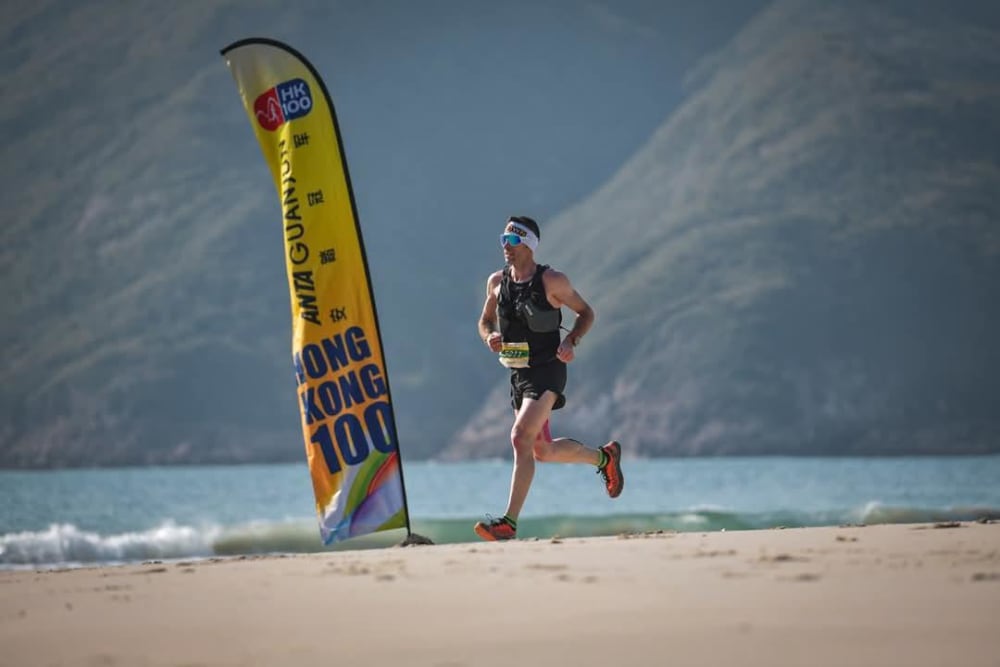
Eduard Hernandez (Photo c/o HK100km)
Peter Le Grice: Road runner with an incredible pedigree. Winner of the 2019 Brighton Marathon, his PB over the distance is 2:14 set at Malaga last year. In 2024 he also ran 30:05 for fifth at the London Vitality 10,000. This winter, he ran home 35th at English Nationals XC at Parliament Hil. Other PBs include 64 minutes for the half, and 29:32 for 10km.
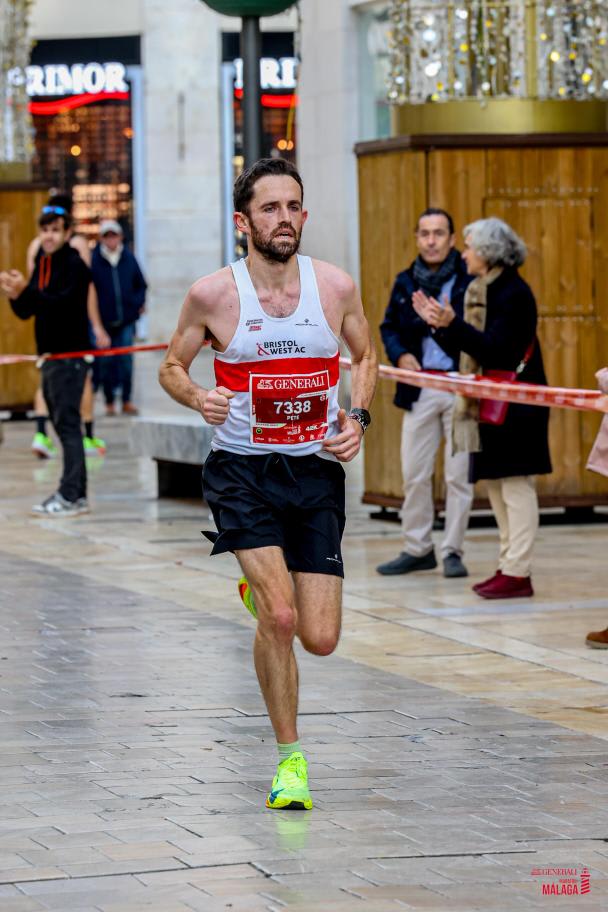
Peter Le Grice (Photo c/o Malaga Marathon)
Ry Webb (ITRA Rank: 794): Centurion Coach, Ultra Team runner and La Sportiva athlete Ry, has had some fantastic results over the years both on home soil and overseas. In the UK - Ry is a past winner of the North Downs Way 50 where he held the course record for a time. He is the Winter Downs 200 Course Record Holder and past winner of Lakes in a Day. He finished on the podium of all four Centurion 50 mile events in 2017 on his way to second place in the Grand Slam. On the track he set a 100 mile PB of 13:24 at our Track 100. Internationally some of his best results include fourth at Leadville 100, eighth at Lavaredo 80km in 2024, third at the Mourne Sky Ultra 50km and ninth at Kullamannen 100 mile.
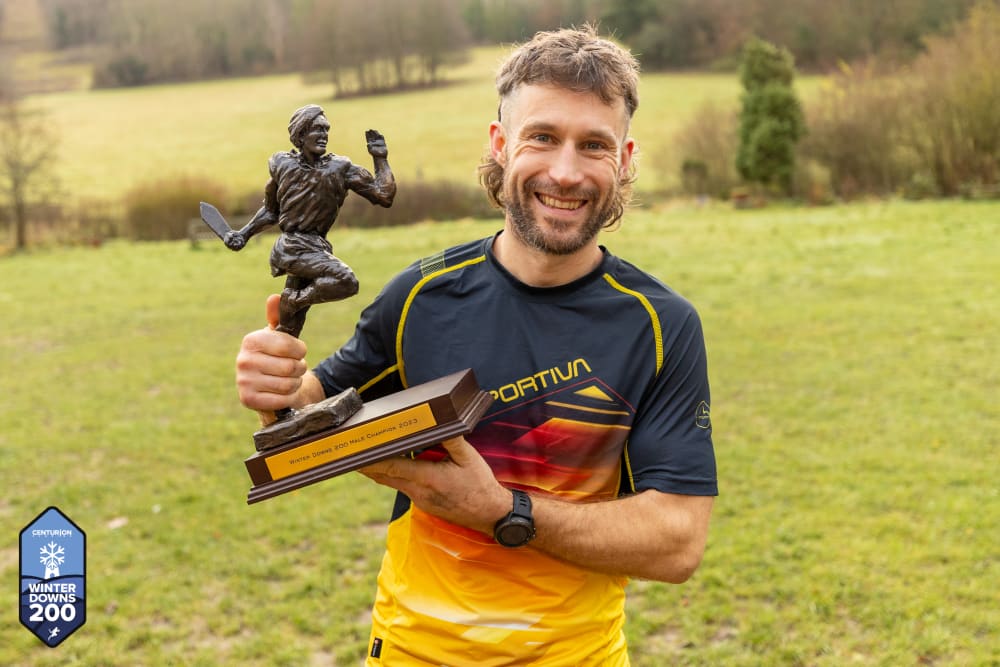
Ry Webb
Jack Oates (ITRA Rank: 749): Ben Nevis Sky Ultra Champion in 2022, a year in which he also finished fourteenth at Transvulcania. In 2023, Jack was ninth at Tarawera 50km and thirteenth at UTS 50km. This year he has already scored a top ten finish at Istria 100 by UTMB - 69km and was fifth at the Arc 25 in January.
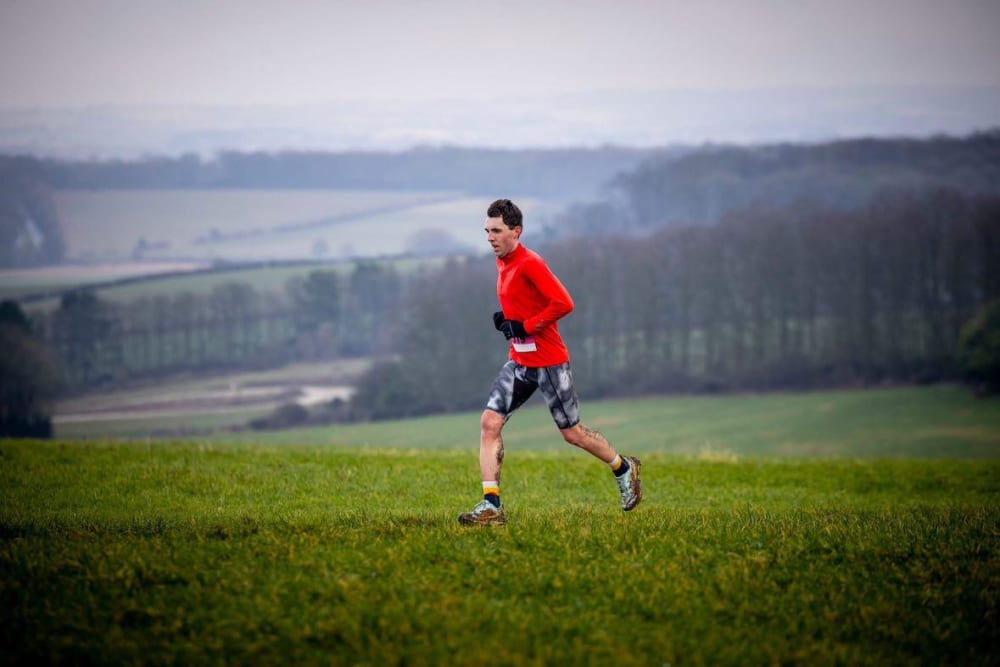
Jack Oates (Photo c/o carelduplessis photography /xterra uk)
Charlie Harpur: Centurion Ultra Team Runner - Charlie has had a break from racing over the last few years as he started a wonderful family. Prior to that his highest ITRA ranked race was 859 from his third place finish at UltraVasan in 2019. He was previously South Downs Way 100 Champion in a time of 15:01. Winner of the 2021 Wendover Woods 50 and past winner of the Beacons Ultra. It is great to see him back in 2025 running as well as ever, having already taken the win at the Steyning Stinger Half Marathon in March on similar ground.
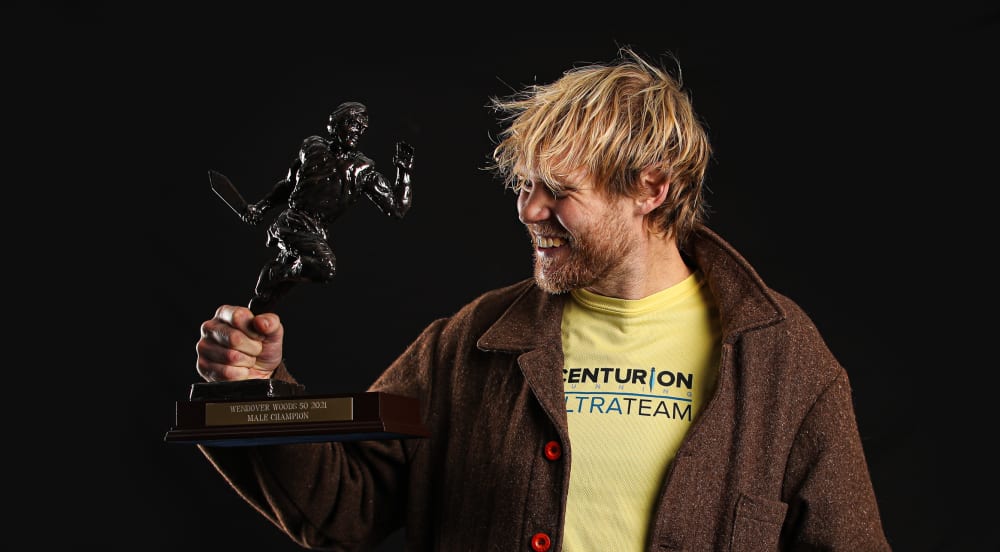
Charlie Harpur
3 Jun 25 by James Elson
South Down Way 50km 2025 Womens Preview
The 2025 South Downs Way 100 and 50km are right around the corner and the inaugural edition of the 50km has attracted a stellar field for this first outing. As part of the World Trail Majors - Short Series, we've got both international and domestic atheltes vying to take home maximum points and be in the running for the overall standings.
In the build up race Weekend we will be previewing the leading contenders for the top spots in four separate posts. We have already previewed the womens and mens SDW100 fields, below is our SDW50km Womens Preview.
You can see full details of the Elite SDW50km Mens Field here.
You can see full details of the Elite SDW100 Womens Field here.
You can see full details of the Elite SDW100 Mens Field here.
Stay tuned to the website and our YouTube channel in the lead up for race day for links to the live broadcast, tracking and results:
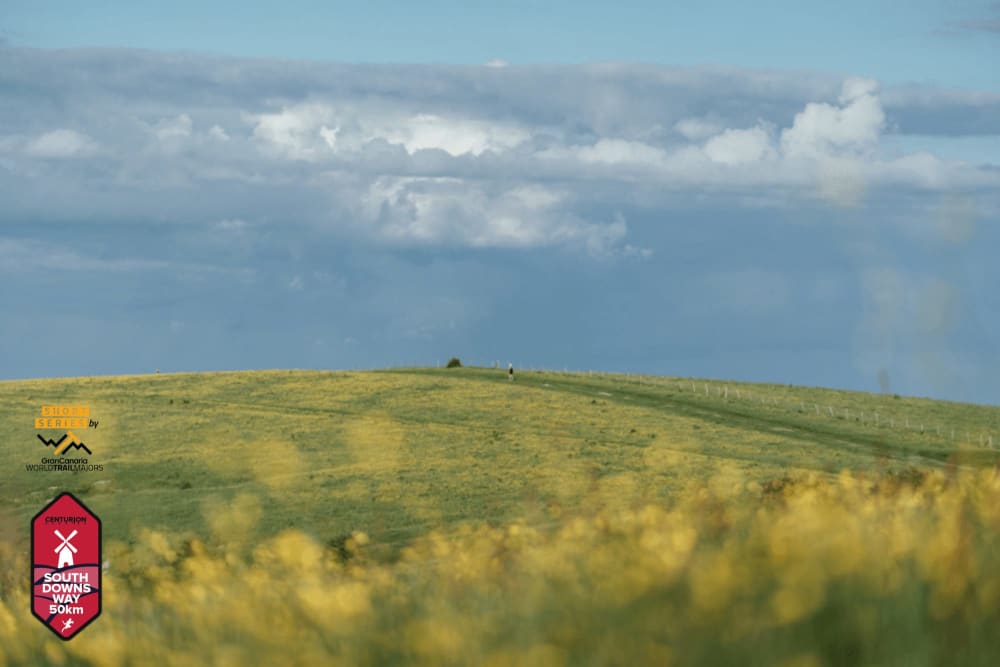
Imogen Ainsworth (ITRA Rank: 707): US based British athlete with a fine pedigree of results at extremely competitive races in the recent past. She finished fourth at the Black Canyon 60km in February before going on to seventh at Lake Sonoma 50 in April. In 2024 she finished second at the Leadville Silver Rush 50. She is no stranger to the South Downs either having won a Maverick event held a little further east - back in 2021. She's also won other events including Jemez Mountain 50km and Monument Valley 50km.
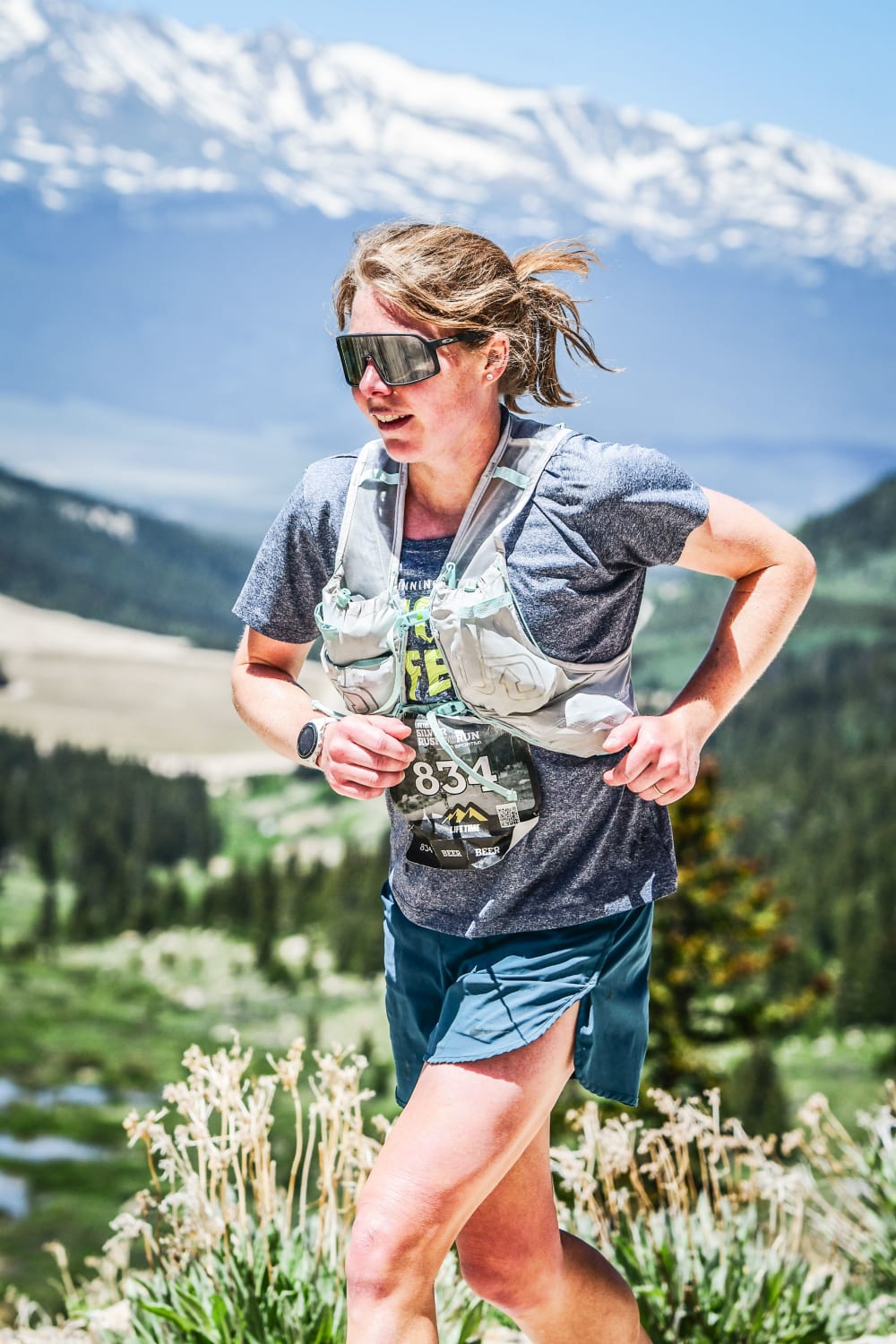
Imogen Ainsworth (Photo: @somerrunner - Somer Kresiman)
Georgie Bruinvels: Georgie is a former winner of the Manchester Marathon in 2:37, which remains her PB. In 2024 she ran bests of 2:44 for the marathon in Pisa (third), 76:08 at Fleet Half Marathon for the win, 35:48 at the Richmond 10km for the win and 58 minutes for 10 miles at the Dorking 10 where she also took top spot. She's not just a road runner however, having finished 23rd at Parliament Hill in the British Athletics Cross Country Champs. This past winter she won the Surrey Cross Country County Championships.
Sophie Biggs (ITRA Rank: 620): In 2022 Sophie won the Chiltern Wonderland 50 and finished third at the North Downs Way 50. In 2023 she won several events ranging between 50km and 50 mile on trail. She also placed sixth at the inaugural Hundred Hills 50km which she then improved upon to finish in second at the 2024 edition. This year she finished fifth at the Arc 50 in January and second at the North Downs Ridge 50km in February.
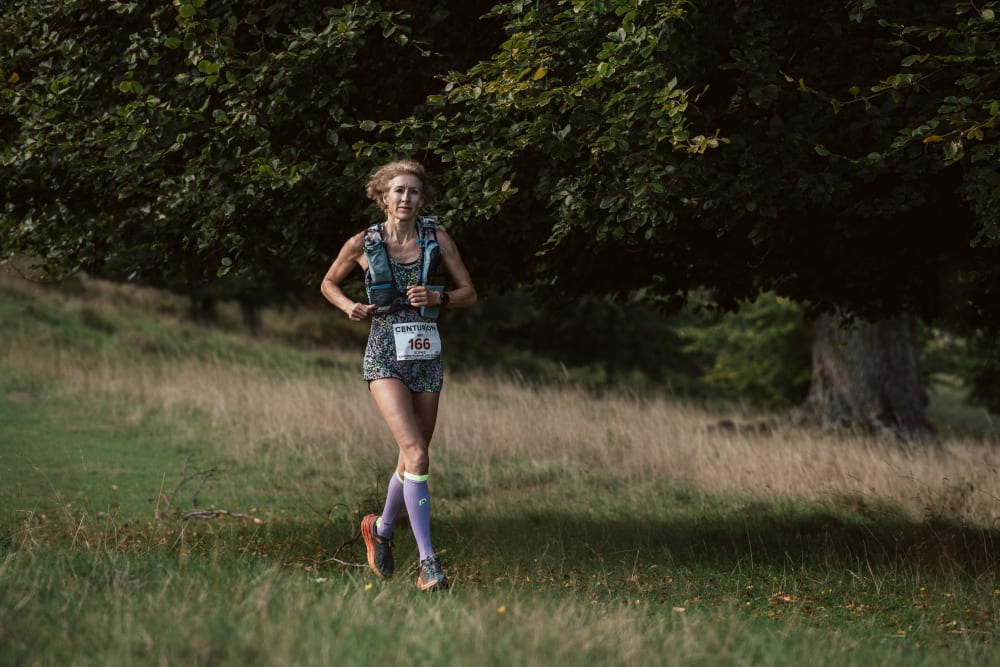
Sophie Biggs
Holly Stables (ITRA Rank: 615): Previous GB international over the marathon distance, Holly turned her hand to the longer stuff around ten years ago and has had quite the career since. She has won a raft of races including the 2021 Autumn 100 in 16:51, UltraVasan 90km, North Downs Way 50 where she held the course record for almost ten years and the Cotswold Way Century . Internationally she has finished seventh at Comrades and at CCC proving she can do it on the trails, on the road and in the mountains. In 2024 she finished second at the Arc 50 before winning Wendover Woods 50 last November. Holly is recently off of the back of a successful finish at The Speed Project, where she ran from LA to Las Vegas Solo - a distance of 300 miles.
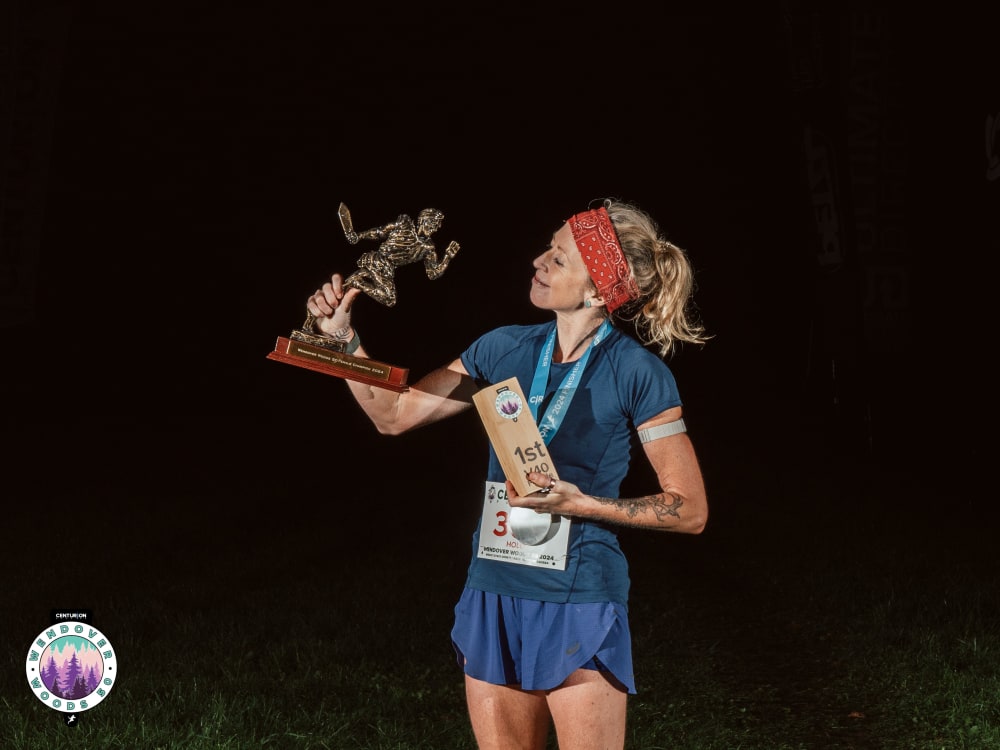
Holly Stables
Anna Buckingham (ITRA Rank: 605): Anna comes in with great form having finished second at the South Downs Way 50 in April. The Centurion Coach and former Spine winner has a really broad range of strings to her bow, having done well at mountain races like MIUT where she finished eighth and UTS50km where she won her age category in 2023, as well as at flatter races and on the road.

Anna Buckingham
Imo Boddy (ITRA Rank: 543): Imo Boddy comes into the 50k with possibly the greatest range, with a 2nd at the British 50k Champs this May, as well as the record for the super long distance National Three Peaks, climbing Ben Nevis, Scafell Pike and Snowdon whilst running the distances between.
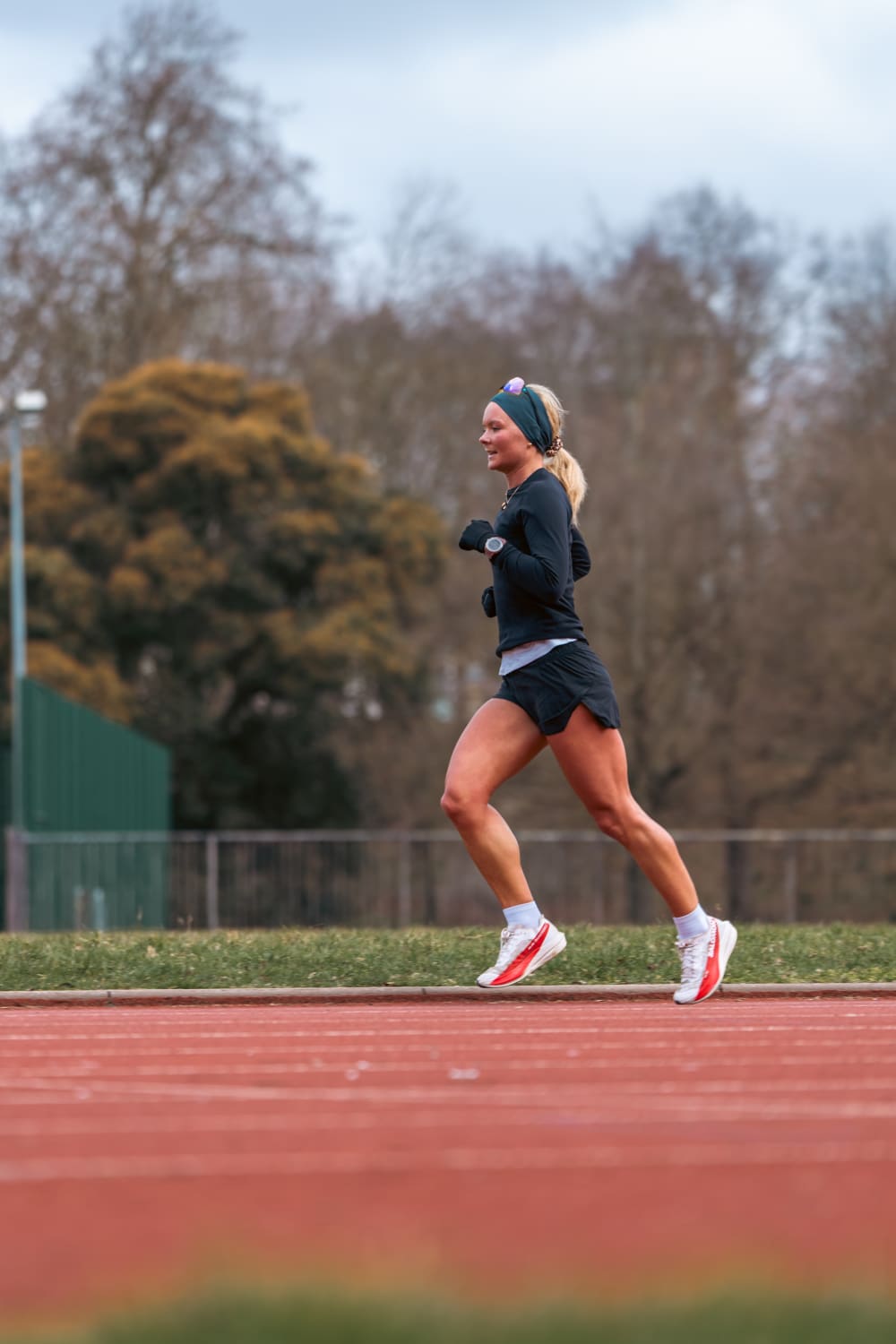
Imo Boddy (Photo: @Tommy_leeming_)
1 Jun 25 by James Elson
South Downs Way 100 2025 Mens Preview
The 2025 South Downs Way 100 is upon us and we are delighted to welcome what is one of if not the largest 100 mile field in a UK event together with the deepest competition. As part of the World Trail Majors Series, the event has attracted some of the best in domestic as well as international competition and will make for some great spectating for all.
In the build up to South Downs Way 100 & 50km Race Weekend we will be previewing the leading contenders for the top spots in four separate posts. Our second post here focuses on the Elite Mens field for the SDW100. The full entrants list can be found here.
You can see full details of the Elite Womens Field here.
Stay tuned to the website and our YouTube channel in the lead up for race day for links to the live broadcast, tracking and results:
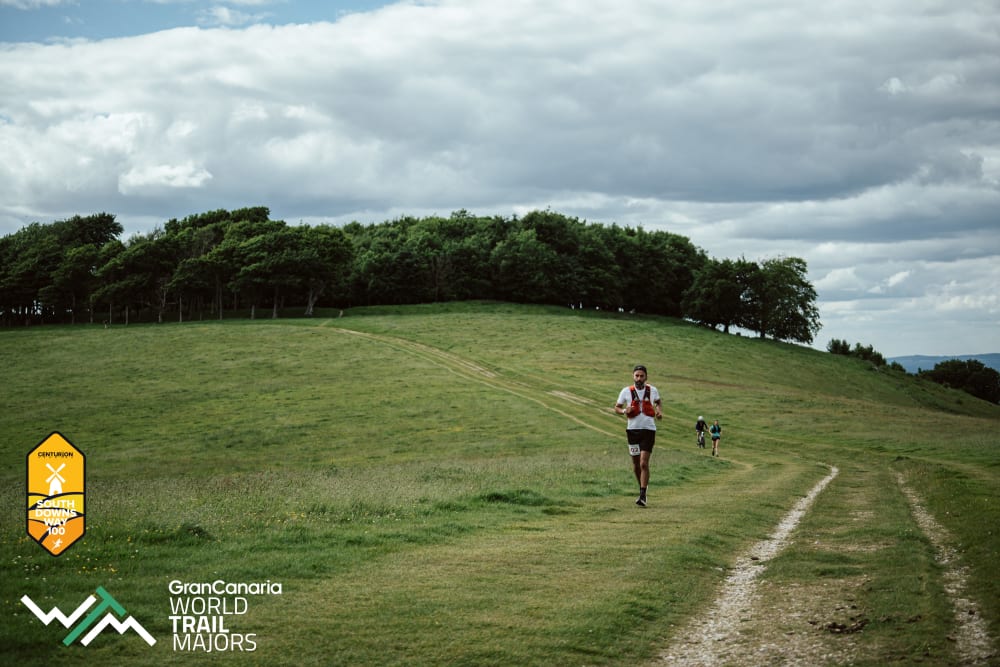
Mark Darbyshire (ITRA Rank: 875): Centurion Ultra Team runner. After a rough first half of TransGranCanaria (part of our World Trail Majors Series) in February, Mark then turned on the jets to pass over 50 runners and finish in 12th. He then ran home for a strong win at the South Downs Way 50 in April, over the second half of this SDW100 course. Mark is the course record holder at too many races to list, including but not limited to: NDW100, Lakeland 100, Arc of Attrition, UTS 100 mile, 13Valleys, Lakes Traverse etc. He is simply the best in the business here in the UK when it comes to the 100 mile distance.
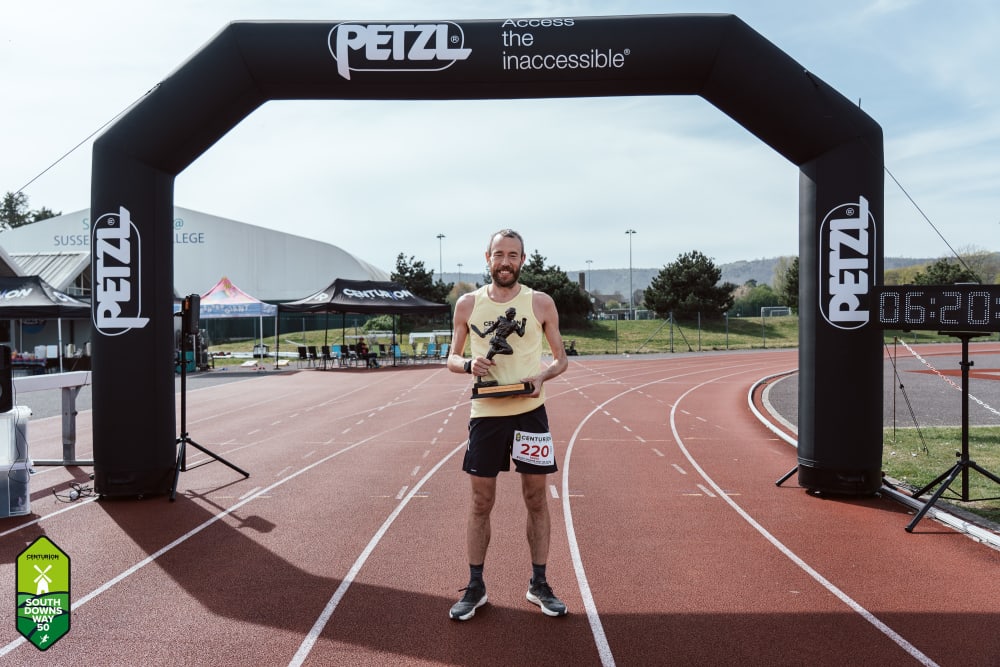
Mark Darbyshire
Geoff Cheshire (ITRA Rank: 789): Geoff's back catalogue at Centurion events is really impressive, albeit at this race he has come up short a few times now. His best here is 7th in 2021 in 17:46 and he has dropped here twice including after leading last year. However his 100 mile credentials are otherwise exemplary and it is surely time he got this one right too. Last year he won the inaugural Winter Downs 100 which shares much of this course (in reverse). He has won the Thames Path 100, Autumn 100 (13:58 course record) - both in 2023 - and the Chiltern Wonderland 50. Finished on the podium in addition at the NDW100 twice. Top ten at Lakeland in 2023, he has won lots of other shorter but competitive ultras too including Race to the stones.
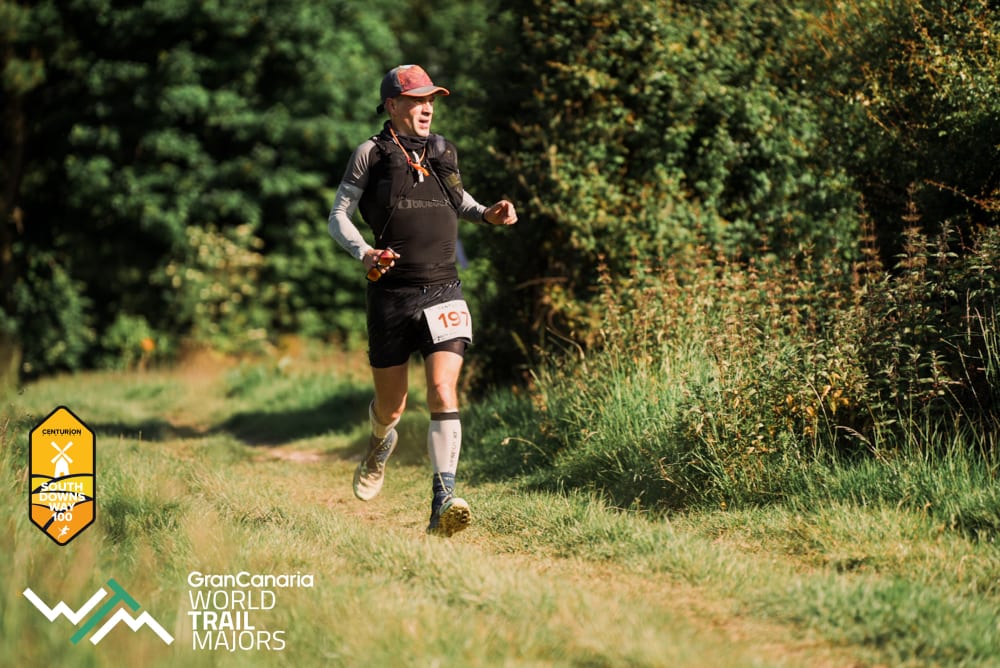
Geoff Cheshire
Adrien Combe (ITRA Rank: 770): French athlete with an incredible pedigree, mostly in French races, winning many by big margins over big fields. Towards the end of 2024 he won the Grands Trails d'Auvergne - X Ultra-Trail. He raced six times last year and placed a worst of sixth in any of those. Other wins in his recent past include Impérial Trail Fontainebleau and Trails du Tour du Canton 75 km. In his only previous 100 miler, he also placed sixth at Grand Raid Des Cathares.
Hugh Tibbs (ITRA Rank: 763): Comes in with fine form having won the North Downs Way 50 just two weeks ago in a new course record - in what was the fourteenth edition of our spring classic. Ran a superb SDW100 last summer in the deepest field we've ever had at that event, coming home second in 14:46. He opened up 2025 with a third place at the Arc of Attrition in January.
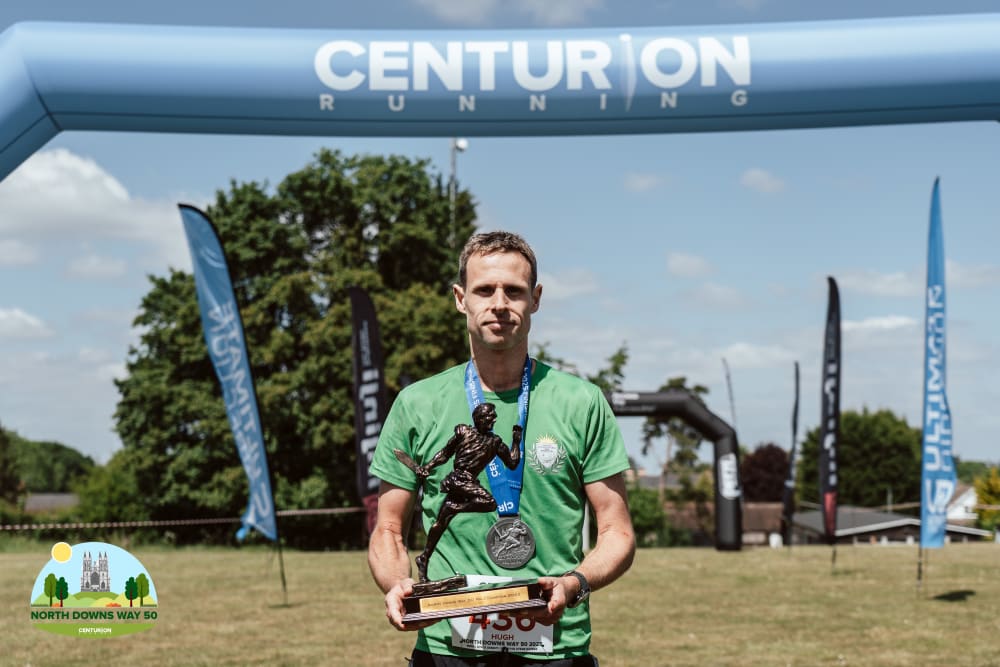
Hugh Tibbs
Jonathan Young (ITRA Rank: 762): Winner of several North Yorkshire ultras in recent years, most recently two in 2024 including the. Nidderdale Ultra which is 111 miles with over 14,500ft of elevation.
Peter Windross (ITRA Rank: 761): Champion here in 2021, he was third in 2024 in 14:48. Peter has also won the Autumn 100 (sub 14 hours) and the Thames Path 100. Four time Grand Slam finisher, he is one of our most decorated runners both in terms of finishes but more so top tens, podiums and wins.
Gavin Byrne (ITRA Rank: 760): Irish international trail and mountain runner, Gavin is the Wicklow Round record holder but has had some fine results in races too. Notable performances include third at UTS100km in 2022. Finished in the top 50 at UTMB in 2023 in 26:08. Winner and podium finisher at dozens of Irish ultra and mountain races.
Joseph Turner (ITRA Rank: 755): Joe won at the Hundred Hills 50km back in March over a solid field and has since gone on to pick up a few further wins over that distance in what looks to have been an excellent training block. He is a Team GB 100km runner with a PB of 6:35 over the distance, he represtented Team GB in India in December. He has a 12:52 100 mile best from Barcelona 24hr (split) in 2023. But he's handy on the trail too with wins in the past at Wendover Woods Night 50km, Maverick's Jurassic Ultra 50km and Ultra X's summer trail series 50km scattered in amongst some international level road and track running.
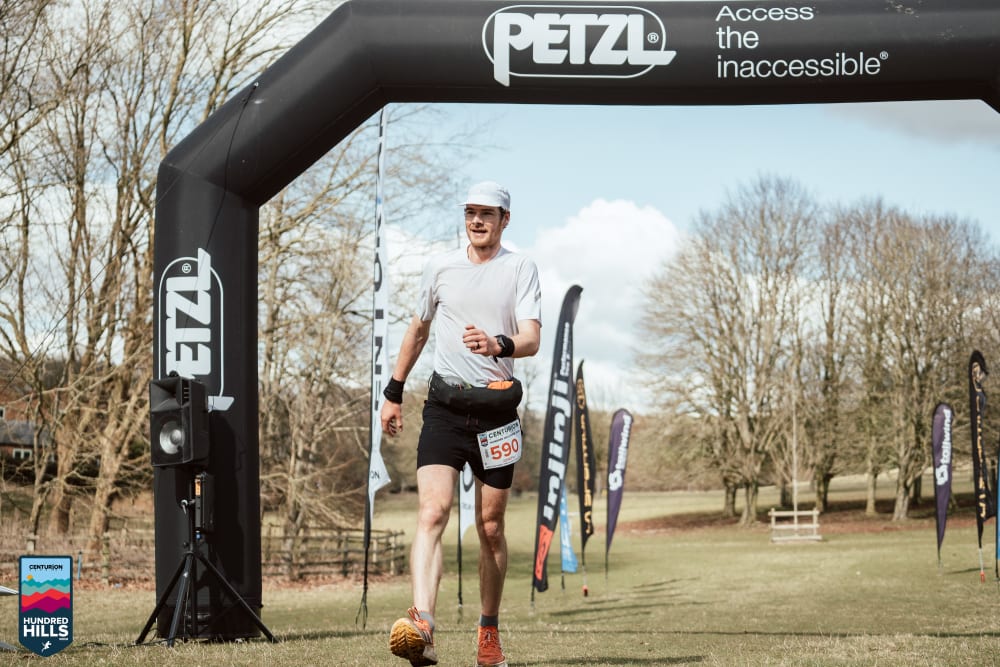
Joseph Turner
Alistair Courtney (ITRA Rank: 747): In 2024 Alistair came out of nowhere to finish third at the Hundred Hills 50km against a classy field, before completely dominating the 50 mile Grand Slam. He won three of the four events last year, losing out only at the NDW50 to a course record from Patrick Wightman. He capped the year off with the Wendover Woods 50 in a time which not only won him the race but saw him take the seemingly untouchable Grand Slam record of our very own Jon Ellis by 11 minutes. He is recently off the back of a painful DNF late into the Thames Path 100 which will no doubt make him hungrier than ever.
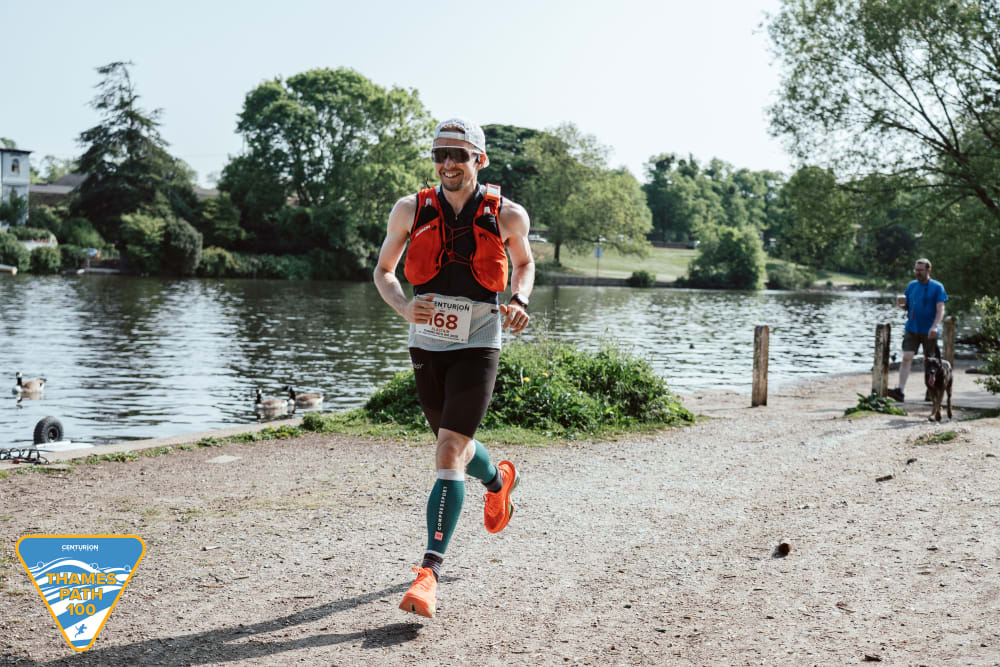
Alistair Courtney
Henrik Westerlin (ITRA Rank: 740): Danish International who has represented his country over 24 hours, 100km and on the trails. The Swiss resident won the Autumn 100 back in 2019 in a then course record time of 14:02. Won the Lake Zuri 100km in 2023. Finished 21st at Western States in 2024 in 18:37.
Jez Bragg (ITRA Rank: 723): Fifth here last year in 15:35. A past winner of UTMB and a best of third at Western States, Jez was at the pinnacle of the sport globally for many years and has one of the deepest running CV's today. He raced for GB on both the road and the trails and really excelled across a variety of distances and terrain types. In the last few years work and family have taken priority but it truly is an honour to have him back again here.

Jez Bragg
Simon Withers (ITRA Rank: 717): Fourteenth here in 2024 in 17:18 but will be looking for better this time. Finished joint third at this years Arc of Attrition alongside Hugh Tibbs - featured above. Previous winner of the North Coast 110 mile. Also won the 2025 North Downs Ridge 50km in February.
Rob Payne (ITRA Rank: 716): Rob Payne has represented both Great Britain and England over ultra-distance, with the most recent appearance being as part of medal winning England team at the Anglo-Celtic Plate 100k at the start of May. Also of note are his improvements over shorter distances in the last 12 months, with a 2:23 at Chester Marathon, 67:42 at Brass Monkey Half Marathon and 30:32 at the North Lincolnshire 10K.With a range of experience on road and trail, including an eighth position at the 2024 SDW100 that included some time off the front of the race before a tough finish, Payne will be one to watch in the first 50 miles and, hopefully, the second 50 as well.
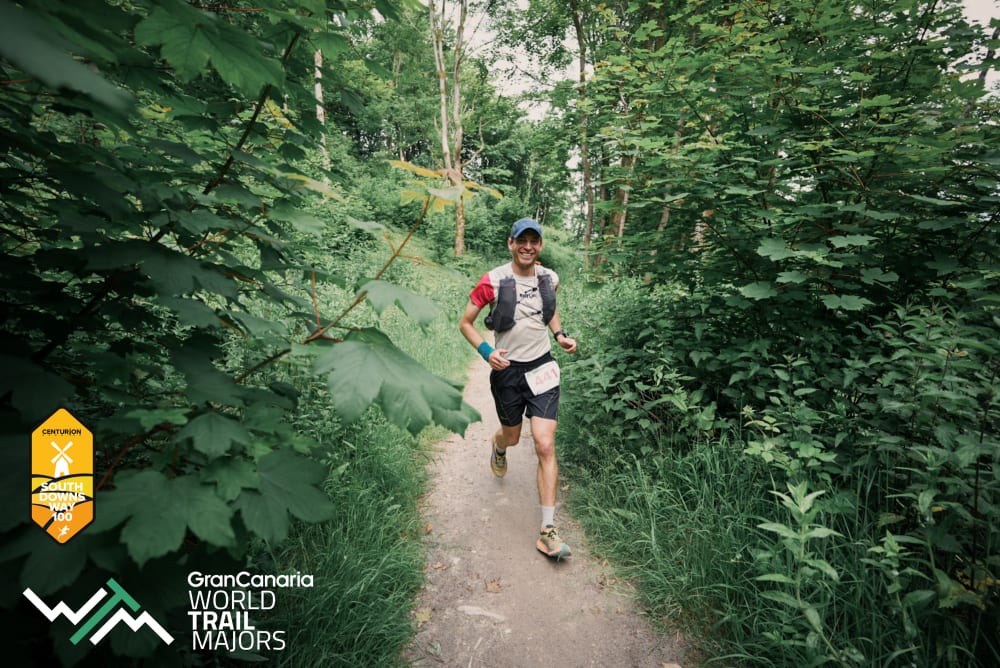
Rob Payne
David Green (ITRA Rank: 708): Fifth place at the Arc 50 in January. Winner of the 2021 SVP100km and 11th at Trail d'Alsace Grand Est by UTMB over the 115km distance last year.
In the Hunt for Top Ten: Iain Ward (ITRA Rank: 697), Chris Kelly (ITRA Rank: 675), James Fulcher (ITRA Rank: 612).
29 May 25 by James Elson
South Downs Way 100 2025 Womens Race Preview
The 2025 South Downs Way 100 is upon us and we are delighted to welcome what is one of if not the largest 100 mile field in a UK event together with the deepest competition. As part of the World Trail Majors Series, the event has attracted some of the best in domestic as well as international competition and will make for some great spectating for all.
In the build up to South Downs Way 100 & 50km Race Weekend we will be previewing the leading contenders for the top spots in four separate posts. Our first focuses on the Elite Womens field for the SDW100. The full entrants list can be found here.
Stay tuned to the website and our YouTube channel in the lead up for race day for links to the live broadcast, tracking and results:
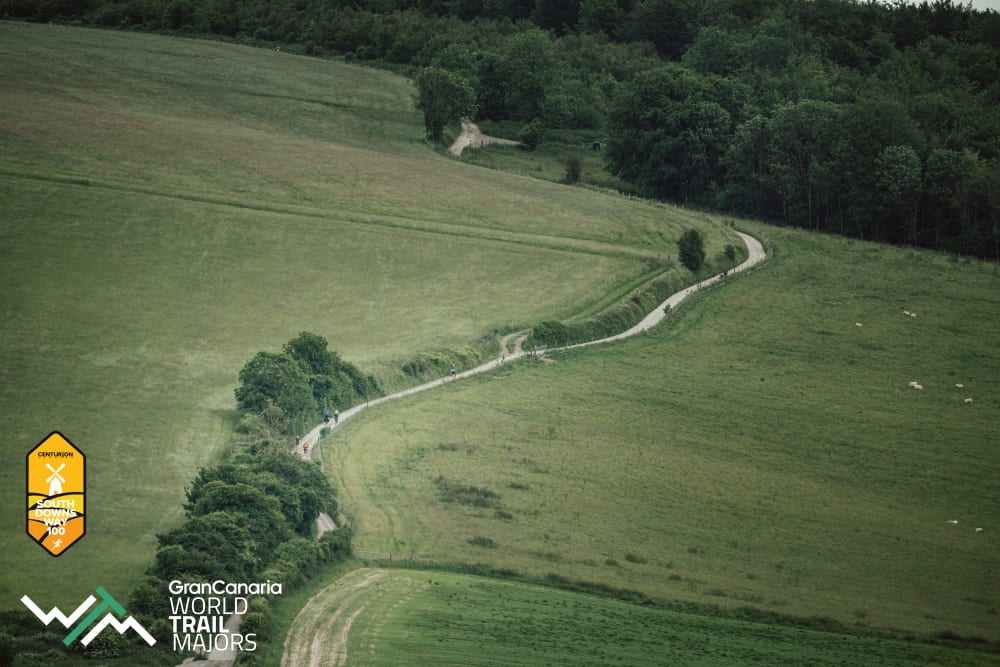
Claire Bannwarth (ITRA Rank: 719): One of the most prolific racers over the last several years in terms of sheer quantity. But is seemingly able to recover fast to record incredible results time after time and most often in the realm of the super long. It is honestly simply impossible to list her achievements even going back 24 months but some of her main highlights of recent years have been a third at Tor Des Geants, two wins at the Spine Race, a win at TransGranCanaria 360, a win at Tahoe 200 just a week after finishing fifth at Hardrock and a Backyard PB of 82 hours or over 400km. These barely scratch the surface of this incredibly French athlete.
Julia Davis (ITRA Rank: 672): Julia is one of our Centurion Coaches and we are incredibly blessed to have her on the team. As an athlete she is a Team GB 100km and Trail Team runner from as recently as December 2024 where she finished fourteenth at the 100km World Championships in India. The South Downs are not her regular training ground but she will have fond memories of the trail, having run and set the existing course record of 6:54 at the South Downs Way 50 back in 2019. She has had many other top results on the trail over the last six years at all distances. With a marathon PB of 2:39, a time she ran in both 2016 and 2017, her speed on what is truly a runners course will stand her in great stead.
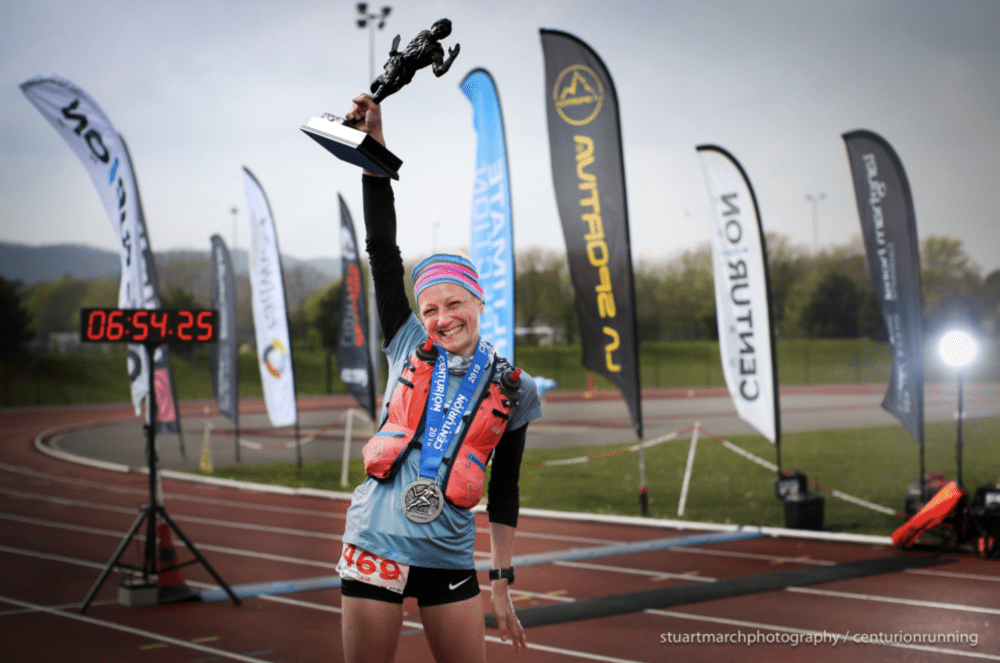
Julia Davis winning the 2019 South Downs Way 50
Lucy Gossage (ITRA Rank: 669): Lucy is one of the UKs greatest ever Triathletes, with 14 wins over the Ironman distance amongst many other successes over other distances. Since she turned her hand to ultras she has unsuprisingly also found massive success, bettering her 2024 Spine Race third place with a win at the iconic event this past January. She has also just set a new course record at the Lap. In 2024 she also took home second at the Lakeland 100, coming home under the magic 24 hour mark.
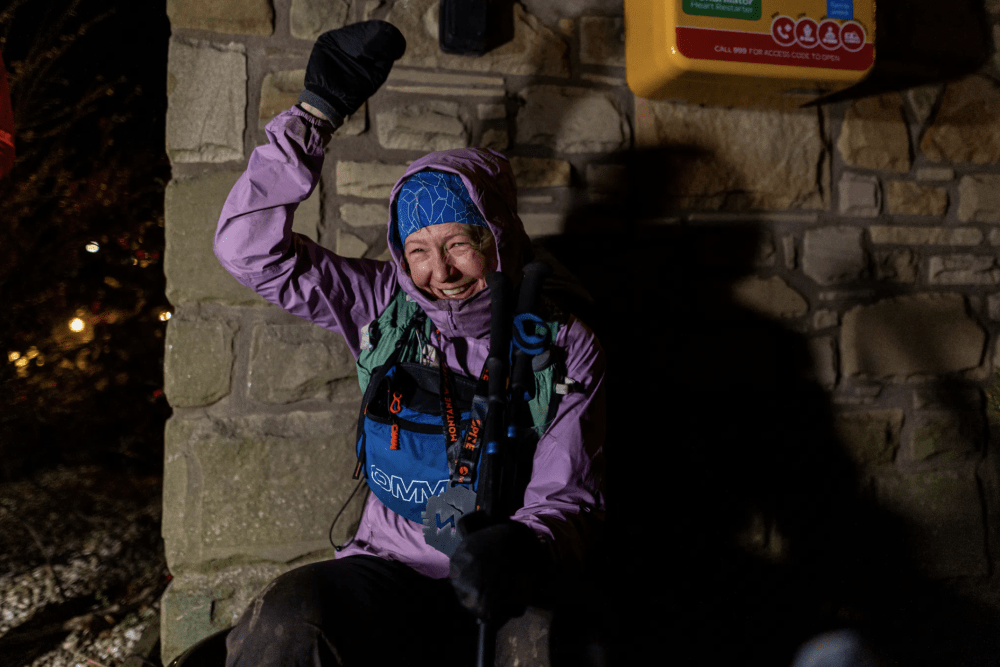
Lucy Gossage winning this years Spine Race (Credit: Adam Wild Aperture/ The Spine Race)
Nicole Frisby (ITRA Rank: 621): Nicole has had a tremendous spring, coming home second at our Hundred Hills 50km, before running a 2:56 at the London Marathon. Prior to 2025, some of her best results include a seventh at Lakeland 50, eighth at UTS50km and a win at the 2024 Serpent Trail 50km.
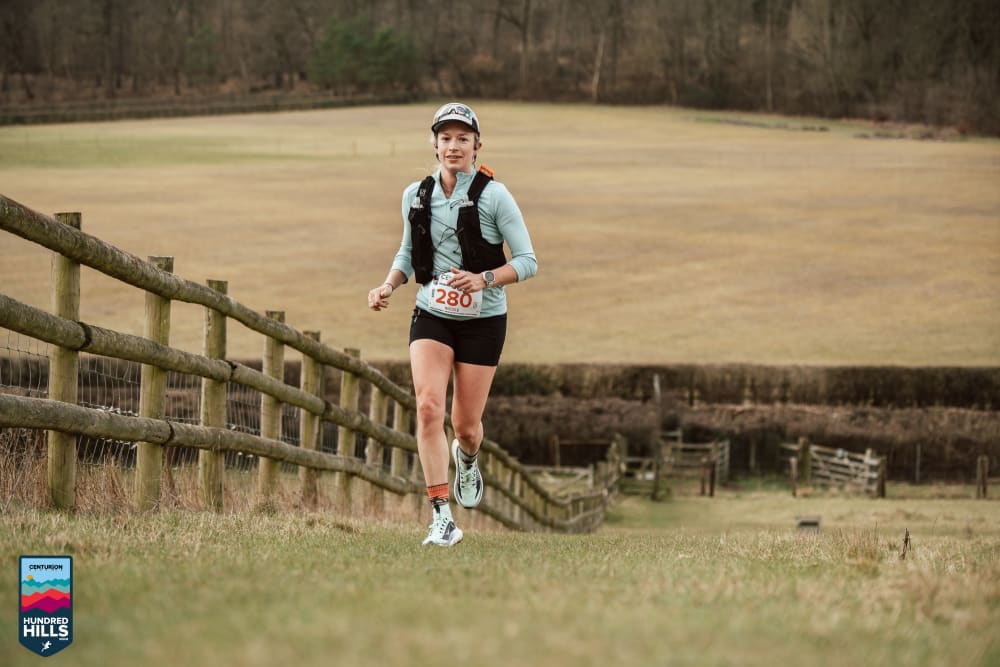
Nicole Frisby
Georgia Campbell (ITRA Rank: 615): Georgia's background is much more in the realm of shorter, faster racing but since she's turned to ultras she has gone from strength to strength. Two solid finishes at the Highland Fling helped her develop and take home third at the Lakes Traverse in awful conditions last year. That followed a win at the Harrogate Hustle Ultra a couple of months prior.
Karla Borland (ITRA Rank: 604): Karla ran home the winner in a competitive field at the Hundred Hills 50km earlier this year. The sub 3 hour marathoner is also at home over longer distances on the road - she landed on the podium at the 2023 ACP 100km running for Northern Ireland. This will be her first 100 miler.
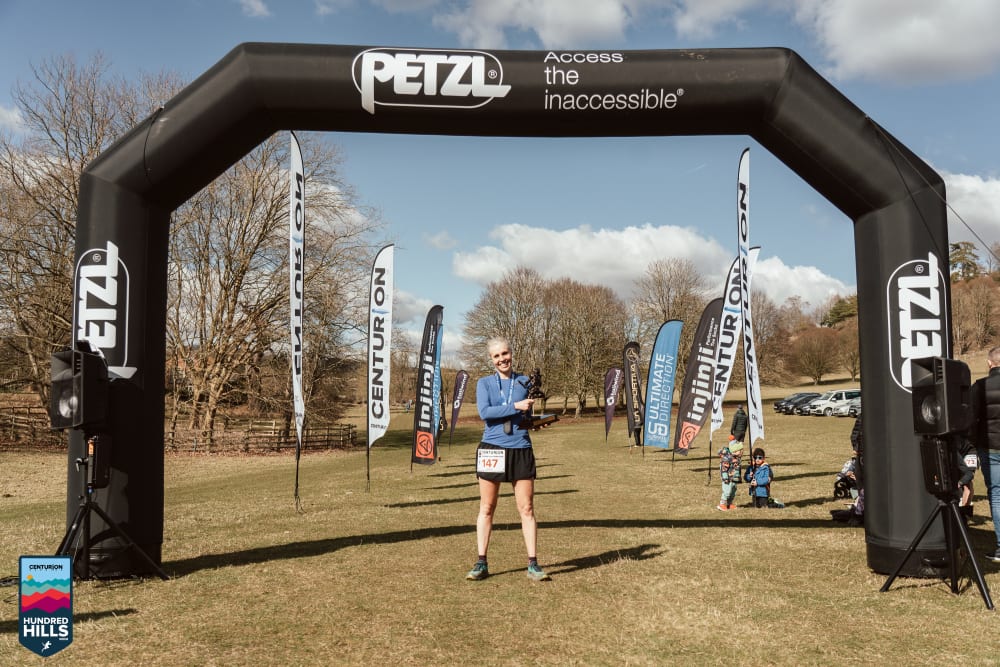
Karla Borland winner of this years' Hundred Hills 50km
Anastasia Hounslow (ITRA Rank: 600): The Liss runner has four ultras under her belt with four top tens to show for it. Two of those were wins at the Serpent Trail 100km which covers similar ground to this course.
Anna Brown (ITRA Rank: 551): Thames Path 100 champion last year, Anna previously had a number of top results at this distance. In 2022 she had to miss out on the Thames Path as part of our Grand Slam quest but went on to finish this event in eleventh place, before running home second at the NDW100 and fourth at the Autumn 100. This year she is already off to a flier taking home the win at the inaugurual London 100km by Camino last month.
Jennie Dunkley (ITRA Rank: 529): Jennie takes this event on as race two in her Grand Slam of 100s quest for this year. She is off to quite the start, with a win at the Thames Path last month. She is no stranger to the distance or this trail. She ran the race back in 2022 finishing fourteenth, but has since kicked on, running home fifth at the 2023 Autumn 100 before her move up to the top step of the podium at the TP100. On the road her best marathon is a 3:06 at London.
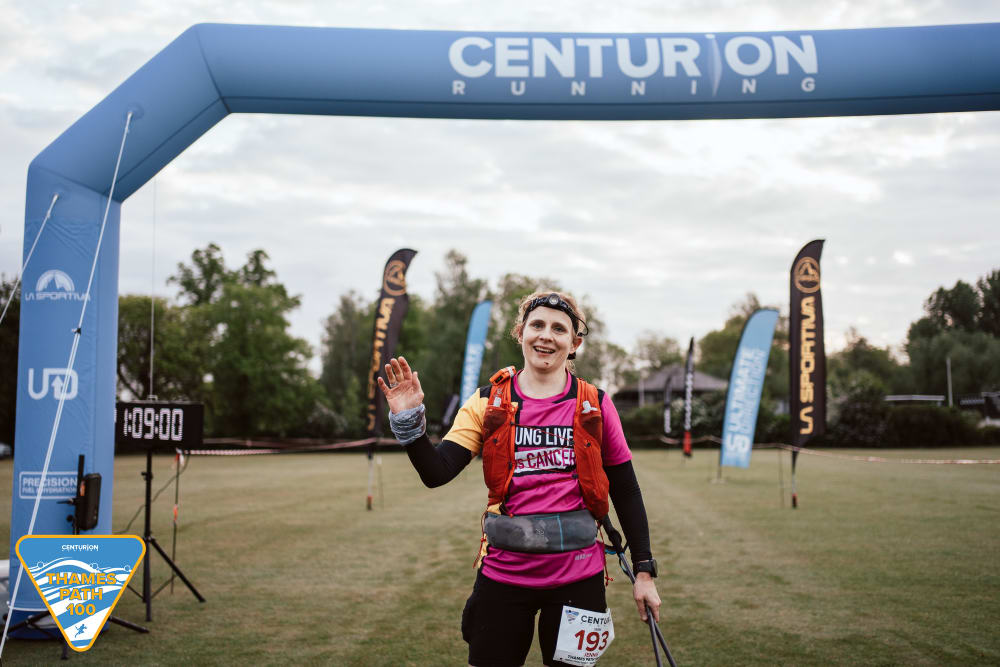
Jennie Dunkley winner of the 2025 Thames Path 100
12 May 25 by James Elson
North Downs Way 50 2025 Preview
More warm dry weather of late and a week out, a great looking forecast awaits those taking on the fourteenth North Downs Way 50.
The mens course record was lowered by Patrick Wightman to 6:31:48 and after a DNF at SDW50 last month he is back and raring to go after it again.
The womens course record has stood for almost a decade, with Holly Stables' 7:11 mark from 2016 still the one to beat. That may be under threat this time. We have 350 runners joining us in Farnham to run the first 50 miles of the North Downs Way, as far as Knockholt Pound, a little village right on the edge of London which has always hosted our finish. The course roughly breaks down into two halves. A screaming fast mostly flat and runnable section over to Box Hill check point in the Stepping Stones Car Park. Before an ascent up the steps and the tougher second half over to the Finish. Let's have a look at who might be contending for top spots this time around.
You can follow the race live here from 0700 on Saturday 17th May.
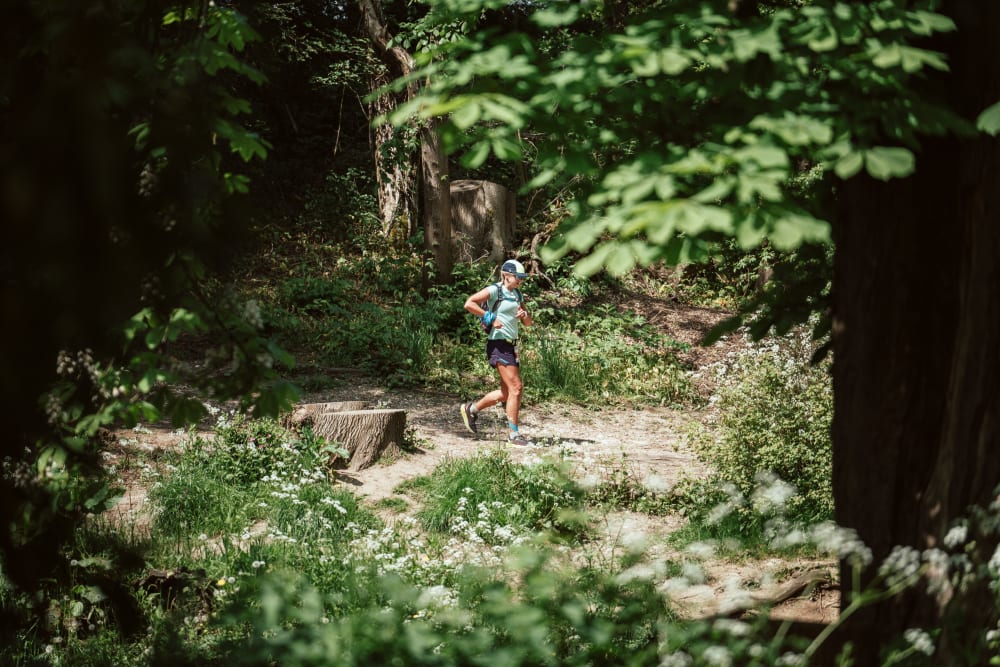
WOMEN
Fiona Pascall: Fi was our 2022 Wendover Woods champion but has since frankly exploded onto the international scene winning and competing in some of the marquee events. Whilst this is very much a preparation event towards Western States for which she won a Golden Ticket through winning the Chianti Ultra Trail 120km back in March, she will naturally be the one to watch. Other recent wins for Fi include Mozart 100km, Julian Alps 170km, Wildstrubel 100km as well as more recently that Chianti performance - all UTMB events where she beat world class competition.
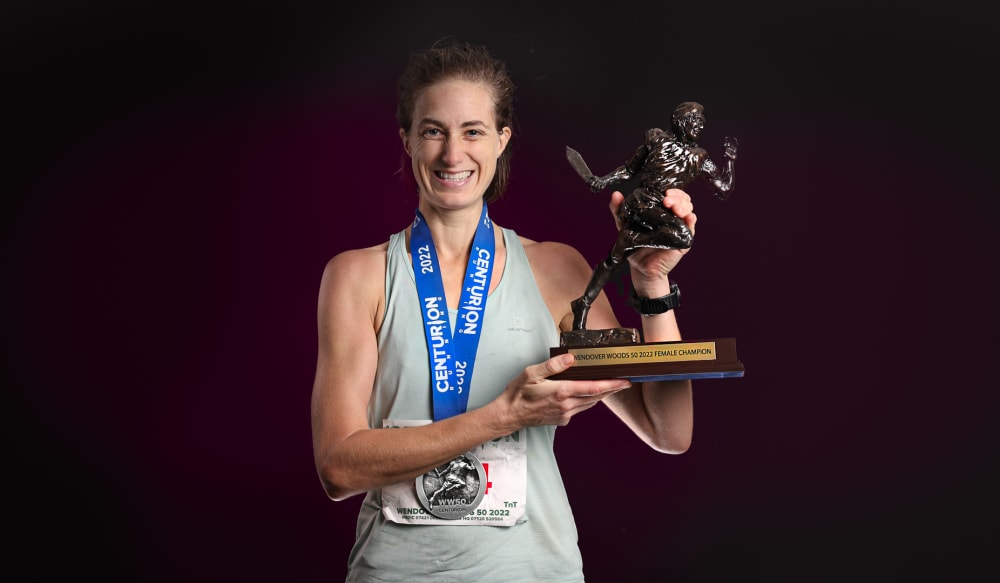
Fi Pascall
Jess Gray: A previous winner of this race exactly 10 years ago, Jess has gone on to have a long and successful career in the sport. Stand out results across the years inlude a 16:42 100 mile at the Autumn 100, a win at the South Downs Way 50, two podiums at Lakeland 50 and many others to boot. Her most recent win came at the Grand Tour of Skiddaw in 2023. It is great to see her back here.
Dani Battersby: Third at the South Downs Way 50 in 2022 in 8 hours flat before running home for fourth at the 100 later that year in 18:43.
Claire Kanja: Lots of great performances at our events over the years including second place at the Autumn 100, Wendover Woods 50 and Wendover Woods Night 50km.
In the hunt for top ten: Amelie Karlsson, Kathrin Hartmann, Veronika Gill, Georgia Campbell, Flic Archer, Veronika Gill, Jo Wilson.
MEN
Patrick Wightman: Course record holder going for his fourth finish here. In 2023 he was second to a course record, he then lowered that to 6:31 in 2024.
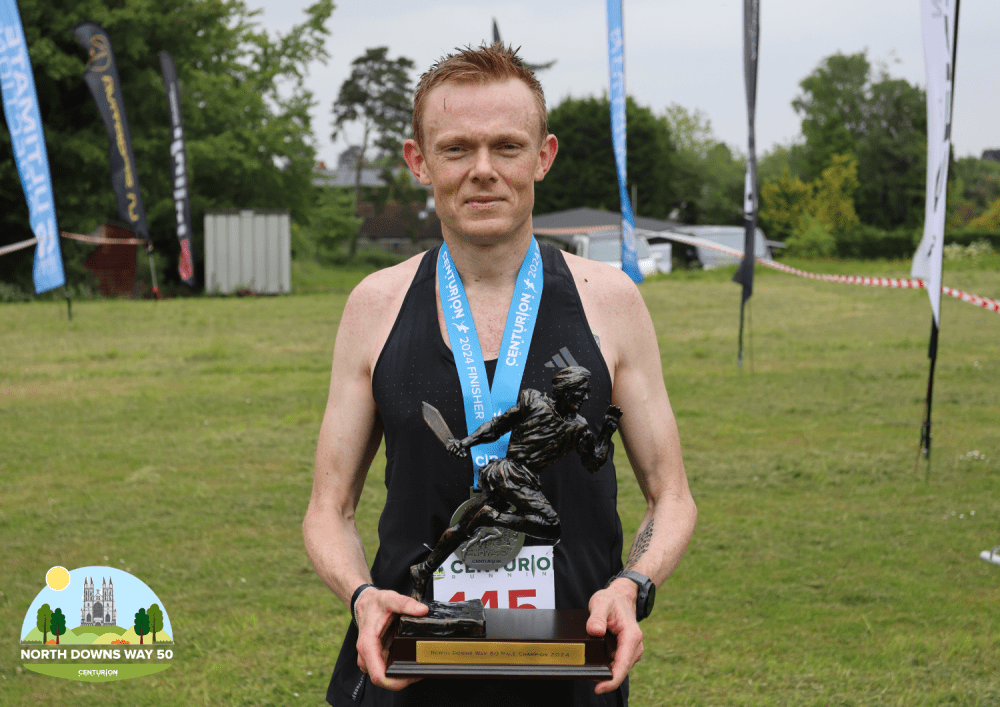
Hugh Tibbs: Ran a superb SDW100 last summer in the deepest field we've ever had at that event, coming home second in 14:46. He opened up 2025 with a third place at the Arc of Attrition in January.
James Local: New to ultra running, but a blazing fast marathoner with a 2:29 at London in 2024. Won another North Downs trail event with Maverick in 2024 also.
Benjamin Hall: Last year he finished third here behind Patrick and Alistair Courtney who went on to win the other three 50 mile events in 2024. Not a shabby result! He then ran home second at Chiltern Wonderland 50 and third at Winter Downs 100.
Alex Hammond: Won Hurtwood 50km last December before a 5:16 at country to capital so he comes in with good form.
In the hunt for top ten: James Whetman, Harvey Waller, Mark Potts, Jamie Pond, Sam Larcombe.
-------------------------------------------------------
We look forward to welcoming everyone on Saturday and a huge thanks in advance to our volunteers without whom none of this would be possible.
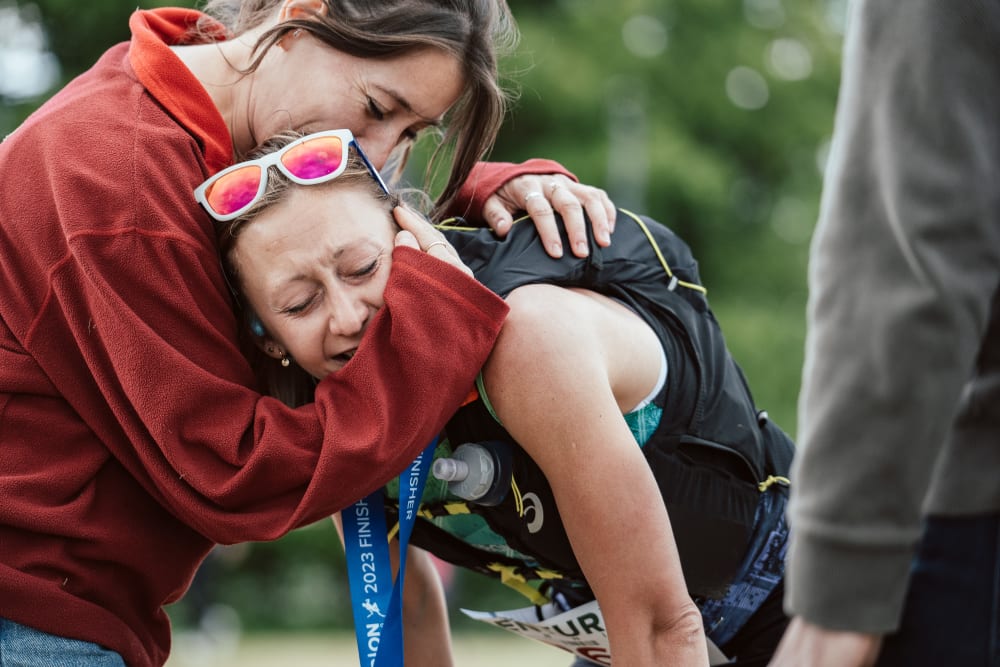
23 Apr 25 by James Elson
Thames Path 100 2025 Preview
Our 100 mile season opener since 2012, back for the fourteenth edition this year - the Thames Path 100 is right around the corner. Flat, fast, often attracting those hopeful of a first 100 mile finish as well as those shooting for major PBs at the distance - this year looks to be no different.
Follow all of the action live via the website homepage from 0900 on Saturday 3rd May.
The conditions have been incredible on the trails over the past month. A couple of weeks out from race day as we write this, things look set to stay the same, but any late downpour especially on race weekend itself can as we have seen in the past, lead to tough going in the final third in particular. That aside, there is so much fast all weather trail surface including paved sections early on, that the going for most at least as far as Henley is often extremely swift.
The starting field at this event is always set at 300 and this year is no different. So let's have a look at the likely leading contenders in both the womens and mens events.
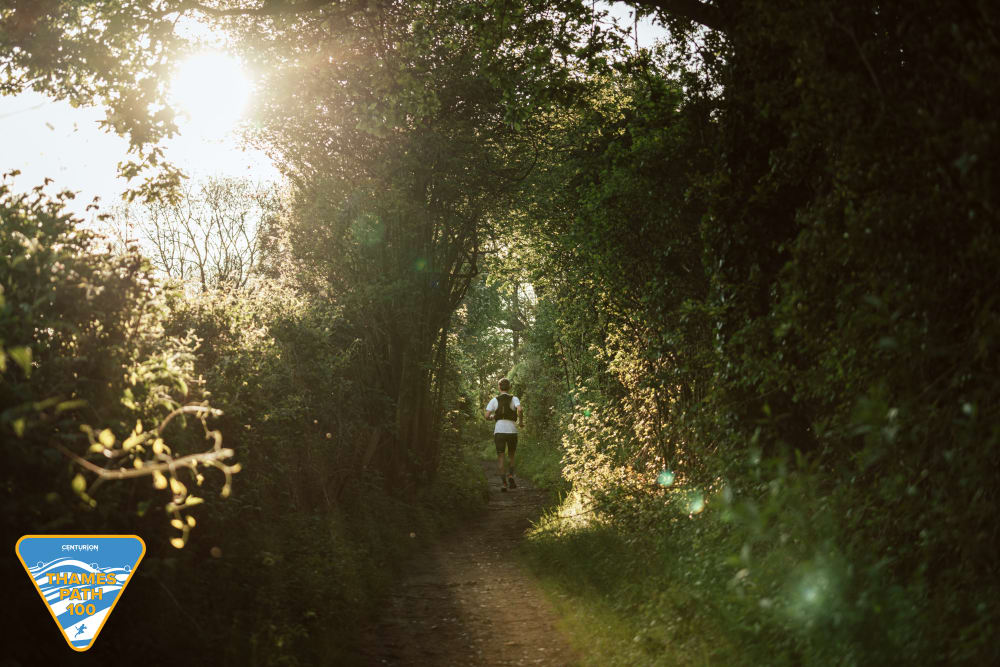
MEN
Alastair Courtney: Still relatively new to the ultra game but what an opening account he has put together so far. In 2024 he came out of nowhere to finish third at the Hundred Hills 50km against a classy field, before completely dominating the 50 mile Grand Slam. He won three of the four events last year, losing out only at the NDW50 to a course record from Patrick Wightman. He capped the year off with the Wendover Woods 50 in a time which not only won him the race but saw him take the seemingly untouchable Grand Slam record of our very own Jon Ellis by 11 minutes. This however, is his first 100. This year he kicked off with a third place at Country to Capital but in a sub 5 hour time.
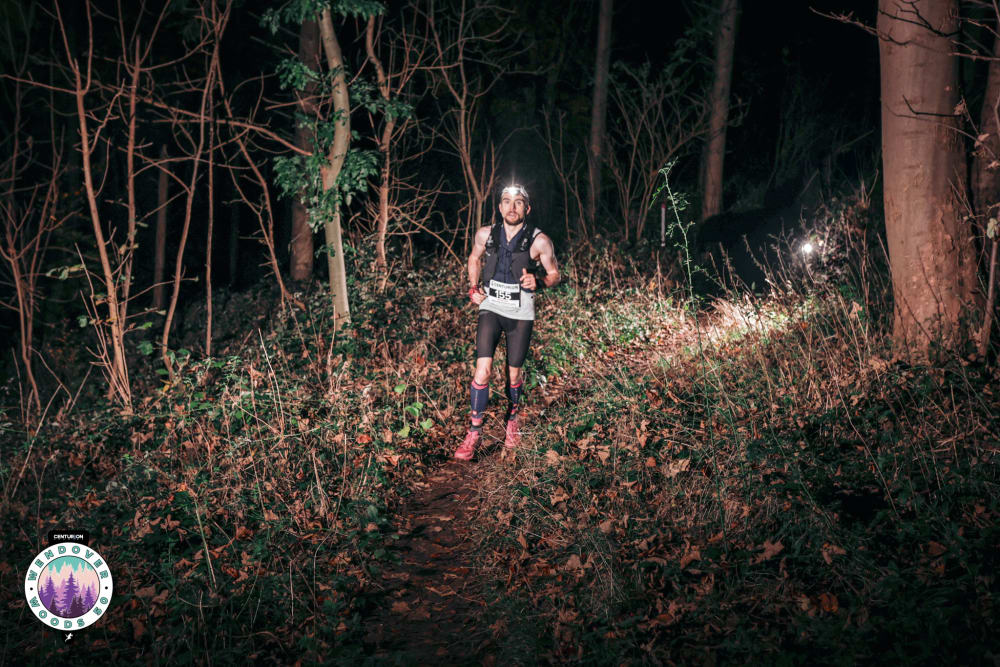
Alastair Courtney
Josh Barrow: The 2020 South Downs Way 50 champion (6:15) took victory at Race to the Stones last year and this year has so far recorded wins at both the Chester 50 and the Manchester to Liverpool 50. This does look to be his first 100 mile attempt.
Sergey Ionov: A long race specialist Sergey has had some outstanding results mainly over the flatter profile course over the years. Winner of the Grand Union Canal Race along with two runner up finishes. Third place at Badwater. Winner of Leeds Liverpool Canal Race and a 13th at Spartathlon. He has run this race once before finishing inside the top ten all the way back in 2017.
Thomas Lepers: The 2022 French National 24 hour champion, Thomas another specialist in the long, flat and faster courses. Last year he set a 24hr PB on route to fourth place in Albi with 257km. He has also has a 100km PB of 7:24 and a 12 hour best of 142km which he ran at our Track 100 in 2022.
Dave Phillips: Dave would feature much higher up the list of potential winners if he wasn't attempting something a little further than the race distance. Dave has shown fantastic form in recent years particularly over the super long ultras. Winner of the 2024 North Traverse, the 2023 Summer Spine Race and with a raft of other wins, podiums and top tens behind him. It has long been Dave's ambition to run all of our National Trails. The South West Coast Path record holder has ticked off a fair few but over race weekend he will be starting off at the Barrier, running to register for the event, running the TP100 before carrying on through to the source of the Thames - a journey of 184 miles.
Matt Gallagher: Super consistent over our TP100 and Autumn 100 courses in years gone by. He has finished five 100 milers with us, top ten positions in all but with a best of 15:34 here in 2023.
Ben Carrol: Seventh at the inaugural Winter Downs 100 back in December, he ran 248km over 24hrs for second place at Crawley 24 back in 2023.
Martin Reed: 2:37 marathoner with three race wins over shorter lower key ultras over the past 18 months.
Alex Sawbridge: Two top ten finishes at the South Downs Way 50, finishing fourth in 6:53 in 2023, he then went on to finish the SDW100 that same year in sixth.
WOMEN
Jennie Dunkley: Fifth at the Autumn 100 in 2023, Jennie also finished fourteenth at the SDW100 in 2023 and seventh at the NDW50 back in 2021.
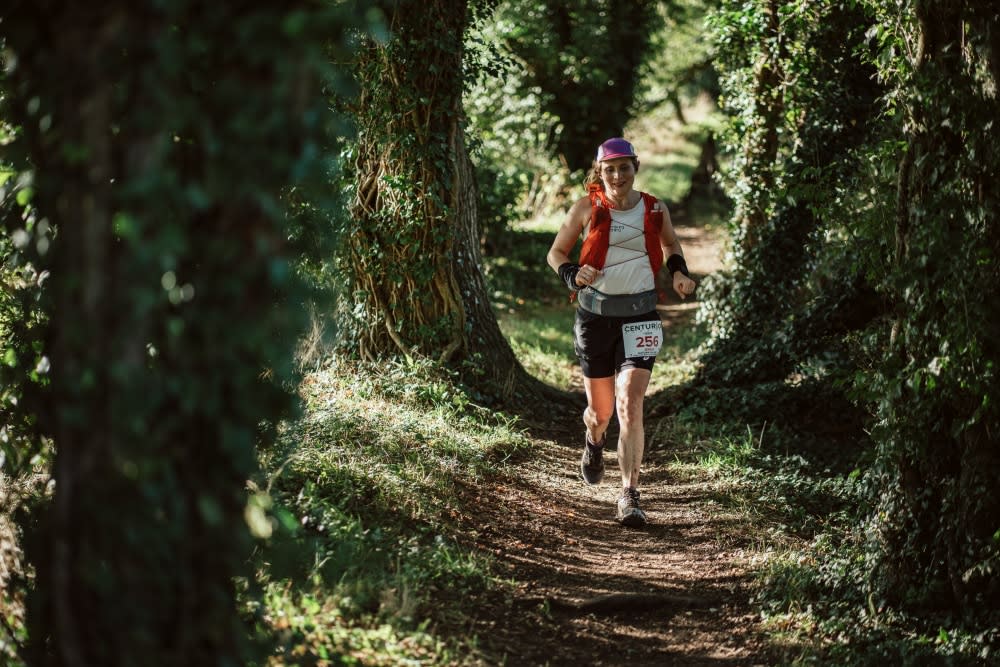
Jennie Dunkley
Lucile Resplandy: French runner with an incredible CV of mountain races. Has literally dozens of ultra finishes in her past with lots of top tens, podiums and a few wins over the years and most at very long distance events such as Grand Raid Pyrenees, PicAreige, Tuscany Crossing and many many more. It will be fascinating to see what she can do on the flat.
Camilla Mitchell: Picked up five top five finishes at ultras in 2023 including a second at Race to the Stones. In 2024, she won the Ultra X Spring Series 50km and this year finished fifth at Hundred Hills 50km to kick start the season in fine fashion.
Mel Horley: Somewhat of a legend in our community for becoming the first and until this year, only unsupported female runner to finish the Winter Downs 200 - when she took home ninth place in 2023. Previously both a 50 mile and 100 mile Grand Slam finisher, her 100 mile PB of 22:59 was set on this course.
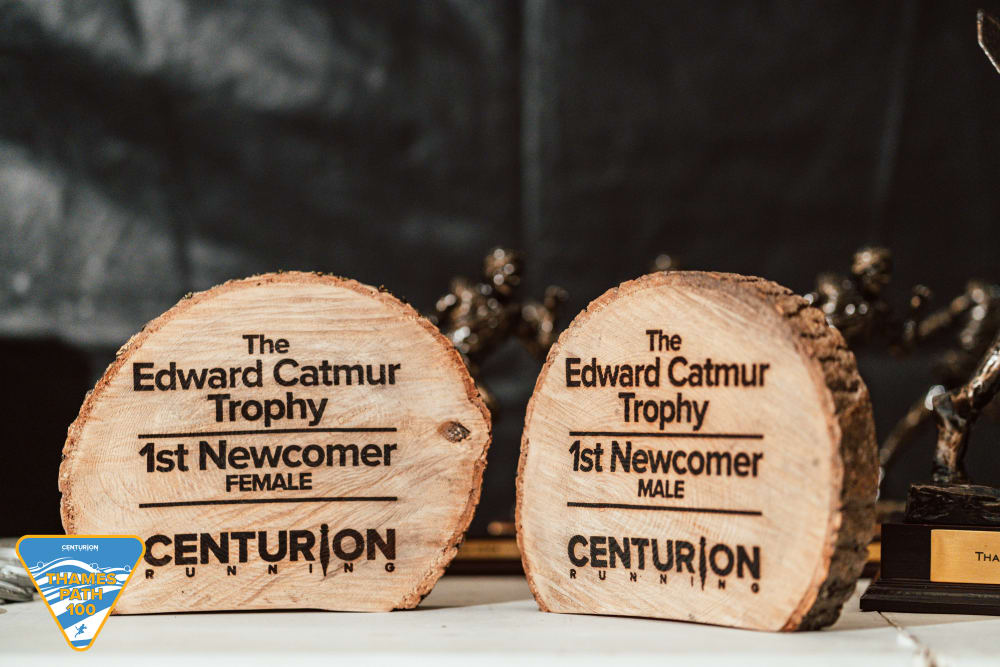
Beyond the usual Centurion Trophies and Age Group Awards, the Ed Catmur Trophies for fastest first-time 100 milers will once again be awarded at the finish, the most fitting way to remember our past champion and 30 time 100-mile finisher with us alone.
A huge thanks to the 100+ volunteers that will make this event possible again in 2025.
8 Apr 25 by James Elson
South Downs Way 50 2025 Preview
The thirteenth annual running of what is and always has been our 50 mile season opener - the South Downs Way 50 - kicks off Saturday 12th April.
Live tracking for the race is available here from 0830 on race day.
Once again the race sold out all the way back in the autumn of last year, its popularity undiminished. This years field of close to 500 runners includes some phenomenal athletes at the sharp end all the way through to those whose ambition is much simpler - to make it to the finish line of their first 50 mile race.
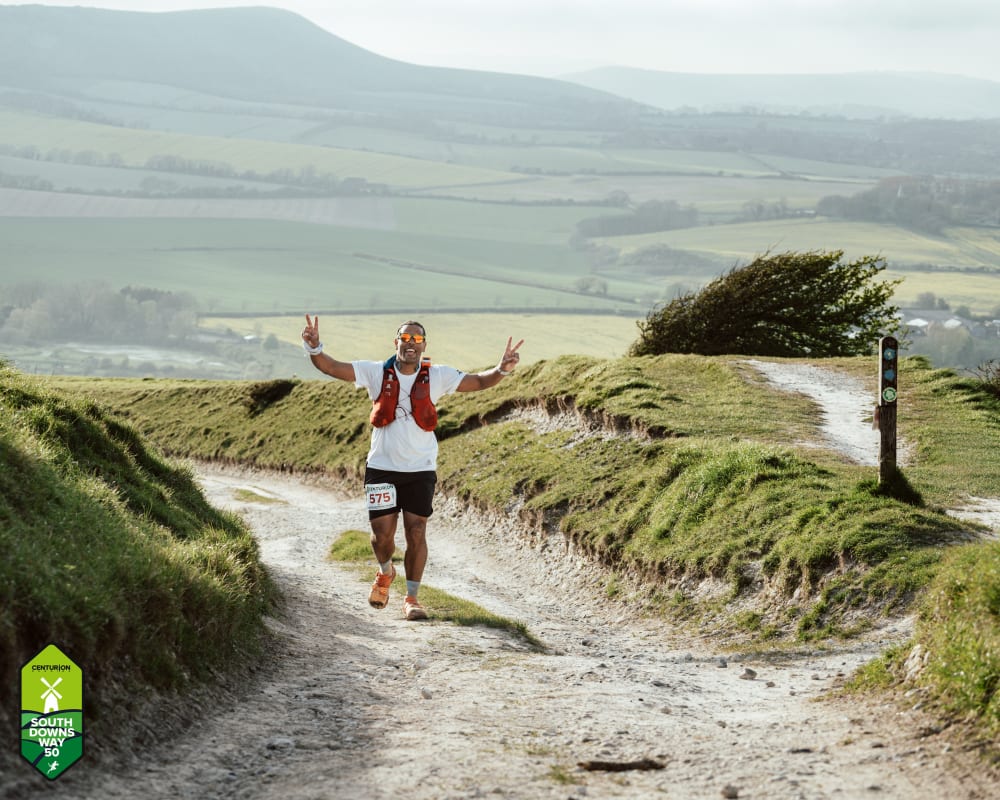
The weather of late hasn't been an early spring so much as an early summer. The trails are in the most unbelievably good shape for the time of year and if anything runners will be more concerned about getting a sun tan and dehydration than rain, wind and muddy ground. Of course there is plenty of time for that to change! And the downs can be notoriously unyielding to any local conditions. The ridge is so prominent and so near the see that mist, fog, high winds and rain have all featured in years gone by. It is always a bit of a game planning for and packing for a downs event in April.
This years list of contenders for the top spots contains many familiar names but also some new ones who could make things very exciting. As usual you can follow all of the action via the Live Tracking Page and our Instagram Channel from 0830 on Saturday 12th.
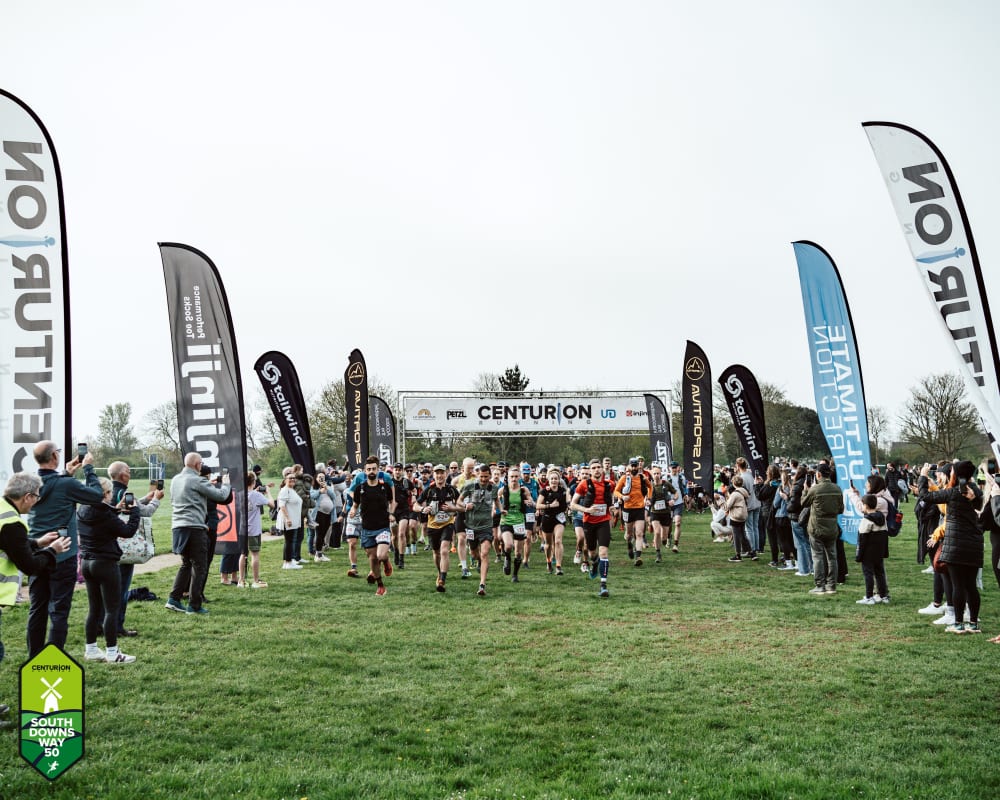
WOMEN
Sarah Page: Sarah was the 2023 SDW100 Champion and the 2024 NDW100 Champion. Also bagging second place at the Autumn 100 and 7th at the 110km Bue Course at Istria by UTMB amongst them. She started 2025 with a bang finishing second at the Arc of Attrition.
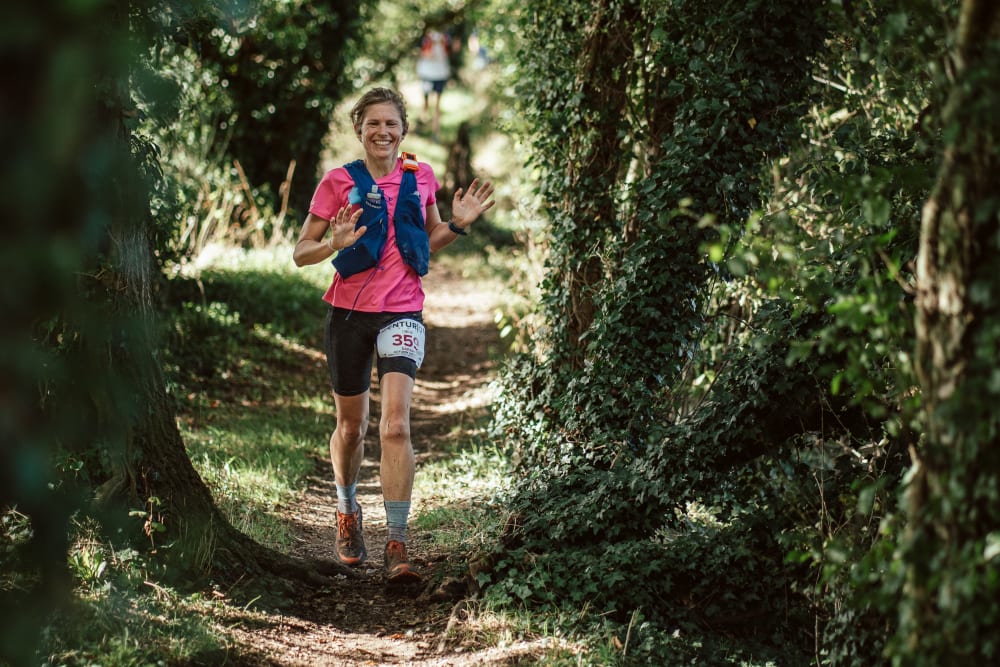
Sarah Page
Anna Buckingham: Centurion Running coach Anna Buckingham has completed some of the most iconic races in the UK and Europe, including the Spine, Mont Blanc 90k and the Tor des Geants and is still getting quicker over the shorter distances with 8th at the MIUT 85k last year a sign of that. 2025 started with a 10k PB of 40:06 and that leg speed will be key with the SDW being a little more runnable than her usual races.
Rachel Stanley Evans: Finished third at the Autumn 100 in 2023. Top 5 finishes in recent years include Race to the Stones, Ultra X Jordan, Pilgrims Challenge, Race to the King and many more.
Tamsin Neale: Second at the Thames Path 100 last year, Tamsin has been really consistent across the 50km - 50 mile distance in years preceeding that. Results include a third at the Chiltern Wonderland 50, two fifth places at Hundred Hills 50km and some solid results at much more mountainous ultras such as UTS50km and 14 Peaks.
Rachel Lindley: 7th here in 2019, Rachel went on to a superb Grand Slam in 2022 finishing sixth at this race in 8:10, before taking fifth, third and sixth at the remaining three 50s that year. In 2024 she ran onto the podium at Hundred Hills 50km before taking fifth at the SDW50 again, in 8:26.
Charlotte Laing: 7th at this race in 2023 in 8:43, a big improvement on her 2020 time of 10:01.
Laura Watts: Our 2024 Winter Downs 100 champion is back for some more downland running!
Annaka Charters: Winner of Run to the Sea Bournemouth in 2022, in 2024 she was second at the London Lea Valley 50km by Camino Ultra, and fourth at the 5 Valleys ultra later that September.
MEN
Mark Darbyshire: Centurion Ultra Team runner who remains the best in the business. 2025 is off to a mixed start, after a DNF at the Spine Challenger South in appalling conditions, and a rough first half of TransGranCanaria, Mark then turned on the jets to pass over 50 runners and finish in 12th. Mark is the course record holder at too many races to list, including but not limited to: NDW100, Lakeland 100, Arc of Attrition, UTS 100 mile, 13Valleys, Lakes Traverse etc.
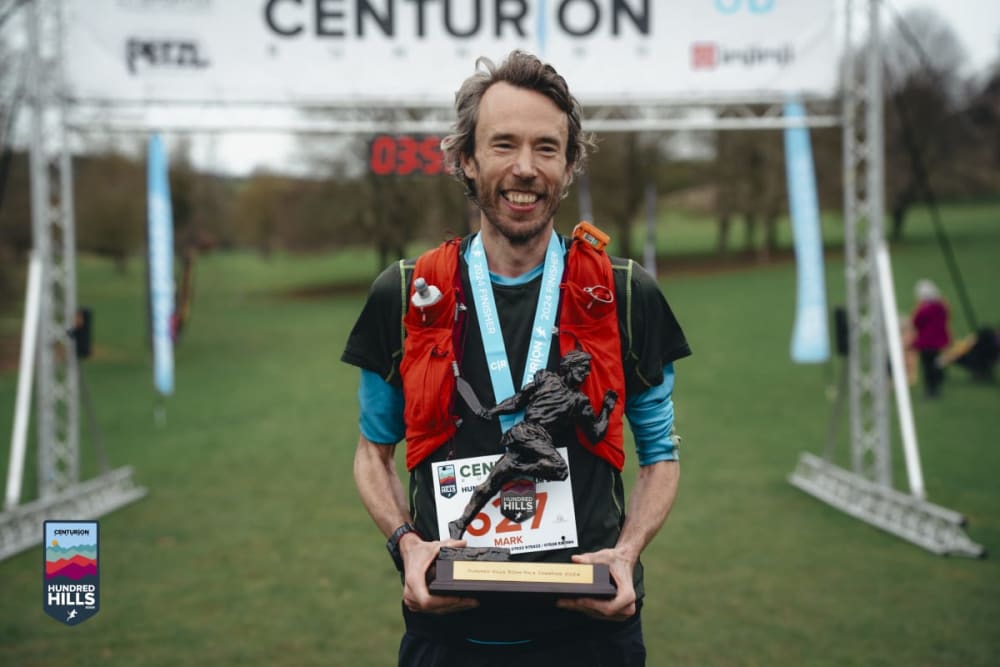
Mark Darbyshire
Josh Barrow: Champion here in 2020, in a blazing time of 6:15. A 2:33 marathoner, in 2024 he won Race to the Stones in a sub 8 hour time and this year has started off with a win at the Chester 50 in 6:25.
Patrick Wightman: 9th here back in 2015, the last two years have seen him raise the bar substantially at the NDW50, with a second place in 2023, bettered by a win and a new course record of 6:31 at that event in 2024.
Guy Hudson: Third here last year in 6:35, a big improvement on his three other previous top ten finishes here. Guy has turned Vet 50 this year so it looks a tough ask for him to be beaten in his age cat!
Paddy Hamilton: 2:23 marathoner back in the day, Paddy has raced a few shorter ultras in recent years including a win at Race to the Stones in 2021 and a win at the Pilgrims Challenge in 2023.
Matt Hammerton: Burst onto our scene with a win and course record at Wendover Woods Night 50km in 2022. Since then key results include eighth at UTS50km in 2023, fourth at the SDW100 in 2024 in a really impressive 15:04 and then a podium spot at the Wendover Woods 50 mile late last year.
Tim Piggott: Picked up a few wins over the years on the UK scene, amongst some finishes at bigger international ultras. Key first place finishes include Spine Challenger South in 2022 and Race to the Stones in 2019.
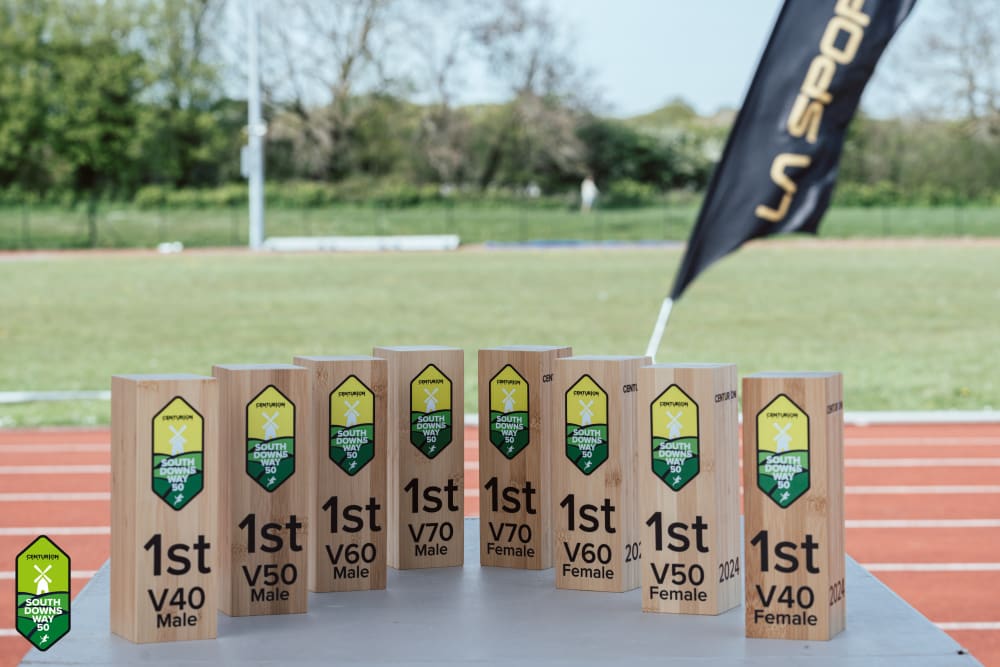
4 Mar 25 by James Elson
Hundred Hills 50km 2025 Race Preview
The first race of the 2025 season is upon us. Kicking off at 0900 on Saturday 15th March is the third edition of the Hundred Hills 50km. With approximately 4000ft of climb and a 9 hour cut off, the race has quickly become an early season show down, showing us who is in shape headed into the spring and summer race seasons. As well as a perfect way for many to build up to our 50 mile and 100 mile events to come, or simply to tackle their first ultra.
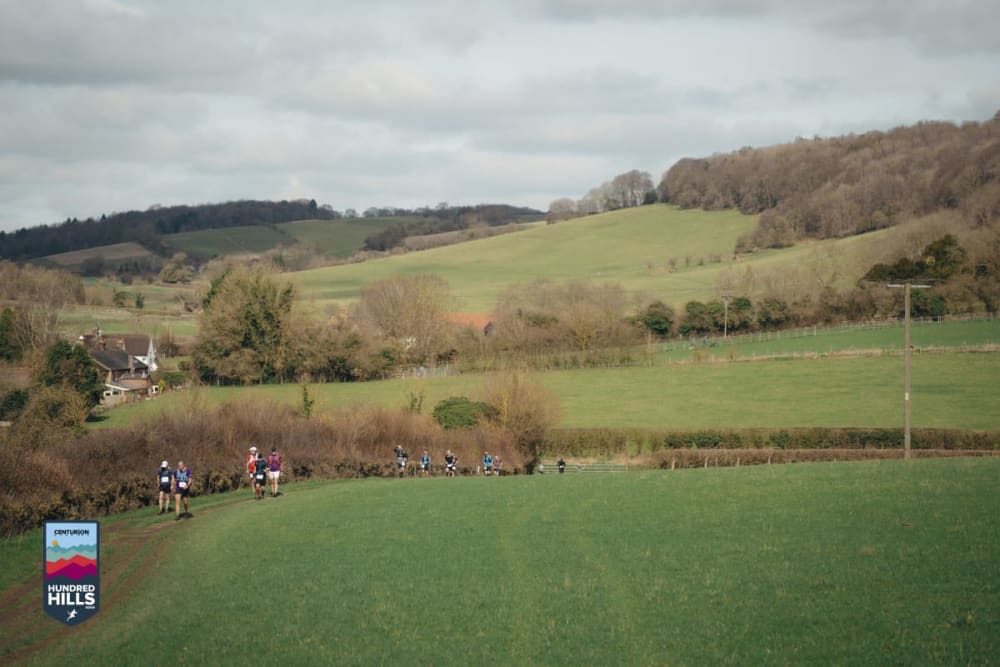
As in 2024 the field has been capped for around 425 starters. Beginning at the magnificent Stonor Park, runners head out on the first loop through the villages of Ibstone, Fingest and then Skirmett, two of which have fully stocked check points, before returning to Stonor at half way. The second loop takes them over to the Hambleden Valley, then on to Bix, the final check point before the final kick for home back to Stonor.
The course is unchanged from its previous two editions. Big news is that we have now partnered with Precision Hydration. So not only will runners find Tailwind and Gu out on course, alongside a raft of real food of course, but also a full offering of PH Chews, Electrolyte and Gels to fuel then to success.
You can follow the race live via the tracking page which will be available just prior to race start through the link here.
Let's have a look at the likely leading contenders for the top spots. The womens field is deep with lots of potential winners. The mens field is packed full and should be a very close race.
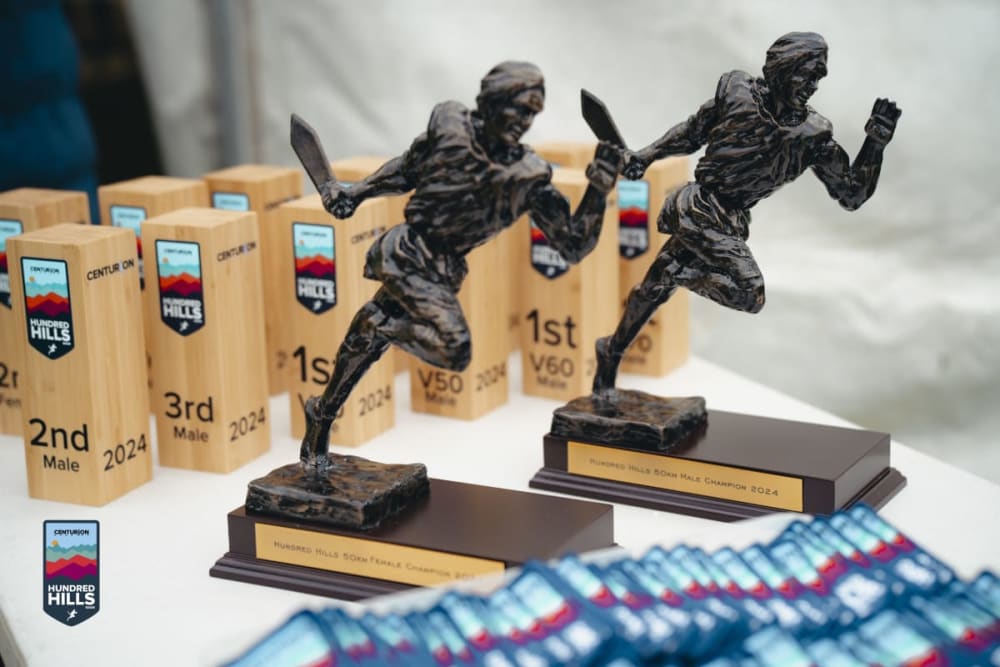
WOMEN
Julia Davis: Julia is a 50/50 as to whether she will start, as she is just returning to full fitness but if she does, she will be the woman to beat. Our Centurion Coach is still the South Downs Way 50 record holder and recently represented Team GB over 100km again in India in the World Championships in December where she came home in 14th place. The 2:39 marathoner has also won a national vest and competed for GB on the trails at the World Champs, last time out in 2023.

Julia Davis
Amy Sarkies: A past Wendover Woods 50 and Autumn 100 champion, Amy has also represented GB at 100km, in 2022. In 2023 she won Hardmoors 55 and has twice podiumed at Lakeland 50.
Rebecca Ash: Seventh here last year. Previous winner of Robin Hood 100 and top three at Wendover Woods 50.
Karla Borland: Third place at the ACP 100km in 2023, also third at Country To Capital a couple of months ago. Previous winner of the Weald Challenge and Brecon Beacons 50km.
Camilla Mitchell: Has consistently finished in the top 5 at lots of ultras over the past few years including Race to the Stones (second), Ultra X Spring Trail Series (first) and the Amersham Ultra (first).
Amy Sole: Grand Slam 50 mile champion in 2023, Amy finished on the podium at the NDW50 and in the top ten of all four. Second place at the Arc 50 in 2022. Previous winner of the Black RAT.
Nicole Frisby: 2:58 at London in 2024. Winner of Wendover Woods Night 50km in 2023, with several other shorter ultra race wins to her name.
Rachel Dench: Fourth at the SDW50 in 2023, also won the Maverick X Series Chilterns 50km that year around a similar area to this. Lots of top ten finishes at races of all distances going back to 2014, always consistent and including a podium at Chiltern Wonderland 50 along the way.
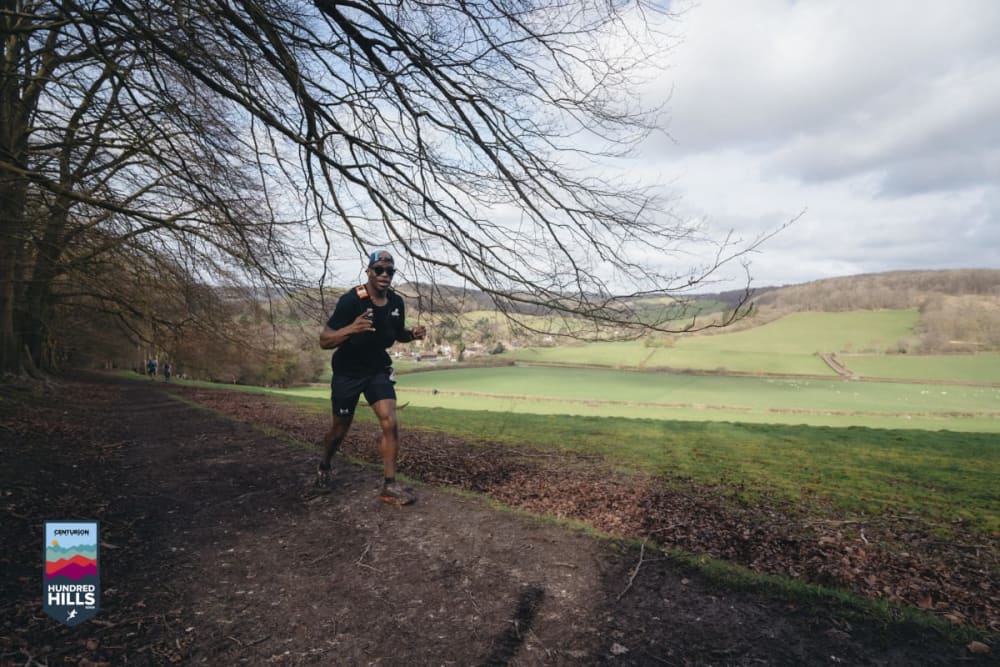
MEN
Kallum Pritchard: Kallum keeps getting faster and faster. Last year he was second to Mark Darbyshire (a late non-starter this time), five minutes back. Since then he has go on to win the Thames Path 100, Manchester to Liverpool 50 in 5:39 and recently set a new course record of 4:45 at Country to Capital. An Ed Catmur course record that had stood since 2014.
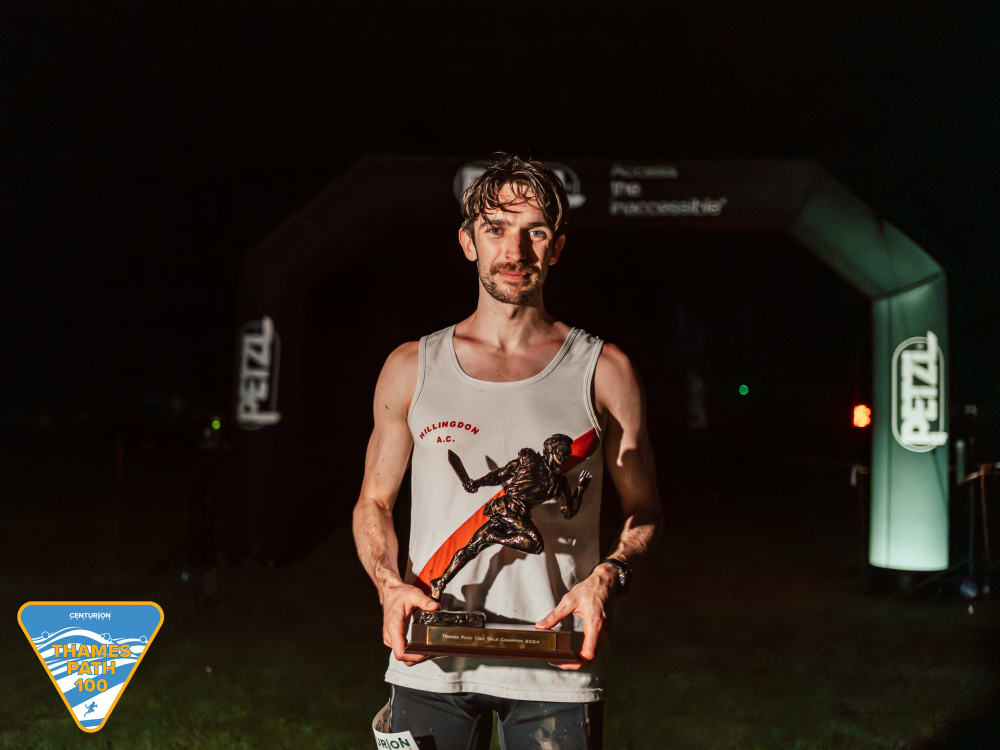
Kallum Pritchard
Joseph Turner: Jo is a Team GB 100km runner with a PB of 6:35 over the distance, he represtented Team GB in India in December. But he's handy on the trail too with wins at Wendover Woods Night 50km, Maverick's Jurassic Ultra 50km and Ultra X's summer trail series 50km scattered in amongst some international level road and track running.
Jose Rodriguez: Winner of the NDW50 in 2023 just ahead of Patrick (below) in what was a course record time. Fourth at the SDW100 in 2022 and ran 144km in 12 hours in 2024.
Patrick Wightman: Set a new North Downs Way 50 Course Record last year, coming home in 6:31. He's finished that race three times, improving to second in 2023 before finally cracking it last year.
In the Hunt for Top Ten: Nick Berry (winner Serpent Trail 100km/ Beacons Ultra), Will Burrard Lucas (2:37 marathon), James Whetman (Winner Serpent Trail 100km, fifth here last year), Mark Shannon (eighth here last year), Mark Potts (second Spine Challenger South in January, 12th here last year), Stuart Farmer (Second at the 2022 South Downs Way 50)
5 Dec 24 by James Elson
Winter Downs 100 and 200 2024: Race Preview
Less than a week out from the second edition of the Winter Downs 200 and the inaugural Winter Downs 100, excitement is reaching fever pitch!
Race week - a race which has a 96 hour cut off makes it almost a full week for the staff and volunteer team - was an incredible amount of fun in 2023 and everyone is excited to see what this years edition brings. Alongside the 200, we have added the 100 miler new for this year. Start time for the 200 remains 0800 on Wednesday 12th December, with all runners required to cross the line by 0800 on Sunday morning. The 100 starts exactly half way around the 200 mile loop, from Amberley Museum at 1400 on Wednesday. The idea being that the very front of the 200 field catches the very back of the 100 mile field. That will be an exciting time at the finish!
As usual, we have live tracking for both events. Plus a media team out on course who will be providing regular highlight videos, images and live updates on course. The best place to get those is via our instagram channel which as usual will be buzzing with activity, morning, noon and night throughout race week.
Live Tracking for the 200 can be found here
Live Tracking for the 100 can be found here
Taking a look at the race rosters for both the womens and mens events, at both distances, there are some exciting prospects at the front, but some amazing stories to follow futher back as well.
As we look at a few of the runners this year it's important to reflect on whether they are crewed or uncrewed. Whilst there is no distinction in the results, those with crew will have some obvious advantages so it's important to bear in mind! Of course runners may switch between crewed and uncrewed right up to the race itself so all of the data below is provisional.
WINTER DOWNS 200

Womens Race
Emma Stuart (Uncrewed): The Irish international has in what has been a relatively short running career, established herself as one of the top handful of British athletes at ultra trail events in recent years. Results speak for themselves. Since bursting on to the ultra scene in 2019 she has only failed to finish on the podium once and that was at the European Championships. In the UK she has already racked up wins at several of the highest profile and most difficult trail and mountain 100s - Lakeland, Arc of Attrition, UTS. Internationally she finished third at TGC and at Lavaredo, winning Tor Des Geants last year to boot. She is most recently off of a win at the Kullamannen 100 mile, a race which she ran in 16:28 for a new course record. It is fantastic to have her racing here.
Edwina Sutton (Uncrewed): Eddie was one of the founding members of our Centurion Ultra Team back in 2013. She has also been on our coaching staff for a decade is well known to all of our community both for her results and more recently for her role on the Tea and Trails Podcast. Eddie has won both the SDW50 and CW50 in the past with us. She's also finished on the podium at the British 100km champs. More recently she has focused on the longer / 200 mile distances and finished on the podium at both the Spine in 2023 and the Northern Traverse, earlier this year.
Rachel Fawcett (Crewed): Still our Grand Slam 50 mile all-time record holder and Grand Slam 100 mile finisher, Rachel has won four Centurion events already including the Wendover Woods 100 in one of its three appearances on the calendar. This year she ran home second at UTS 100 mile. She's also won events such as the Jurassic Coast 100 mile and the East Devon Round.
Laura McGill (Crewed): Laura has three Chiltern Wonderland finishes to her name including a third, second and a sixth. She's also finished in the top ten at Thames Path 100, Autumn 100 and the South Downs Way 50, all in the last three years.
Allie Bailey (Crewed): Allie co-hosts the Centurion Pod is also part of our Ultra Team. She has finished many of the longer, tougher ultras in the UK but stand out was her win at the South Wales 200 in 2022. She was also fifth at the Spine Summer Challenger this past June.
Mens Race
Dan Lawson (Crewed): Dan most recently won the South Downs Way 100 in what was an incredibly competitive race, given it's launch into the World Trail Majors Series. Earlier this year he also finished second at the South Downs Way 50, a race he led until a couple of k's from the finish. Our Centurion Ultra Team runner has been one of the leading lights in the sport for a very long time. Dan's back catalogue is simply too long to go into here, highlights include but are not limited to at least half a dozen Team GB 24hr vests where he has performed brilliantly and more consistently than any other including a European Champs gold in 2016. GUCR record holder. World V50 100 mile record holder with a 12:37 at our track 100 in 2023. Winner of Ultrabalaton, Ultra Trail Gobi (perhaps his most relevant finish given the format here of 200 mile plus), third at Badwater, second at Spartathlon the list just goes on and on.
Tristan Stephenson (Crewed): Centurion Ultra Team runner Tristan won our Thames Path 100 in 2022 in 13:59, narrowly missing out on the course record. A year when he also finished second at the Arc of Attrition in what was then a second fastest ever time. Last year he finished on the podium at the Dragons Back and set a 50 mile age cat British record of 5:54 at our Track 100.
Peter Windross (Uncrewed): Champion of the SDW100 in 2021, Pete has also won the Autumn 100 (sub 14 hours) and the Thames Path 100. Four time Grand Slam finisher, Peter is one of our most decorated runners both in terms of finishes but more so top tens, podiums and wins. This will be his first 200 miler.
Scott Newburn (Crewed): Scott was third at the Northern Traverse in 2022, a race that runs past his front door at the New Ing Lodge on the edge of the Lake District in Shap. His pedigree over tough mountain and trail races is fine. Seventh at the Arc of Attrition, second at Wendover Woods 50, fourth at Lakes in a Day and two solid Lakeland finishes. This year he also finished the Paddy Buckley Round in under 24 hours.
Nick Smith (Crewed): Nick has proved he can run well on any kind of surface and after his DNF here last year, having led the race early on, will be hungry to get it right this time. Last year he ran 14:06 for 100 miles on the track. But his past trail results include a second at Wendover Woods 50, a win at the Robin Hood 100 and a sixth at NDW50 amongst many more.
Martin Wilson (Uncrewed): Second at Lakeland 100 in 2023 in a fine time under 22 hours, a race he has finished five years in a row. Recorded 237km over 24 hours on the track in 2023 also.
SPECIAL INTEREST
John Fanshawe (Uncrewed): At 78, John will be aiming to become a two time finisher here having made it across the line uncrewed in 95:15 last year. Listen to a podcast recapping his 2023 race here.
WINTER DOWNS 100
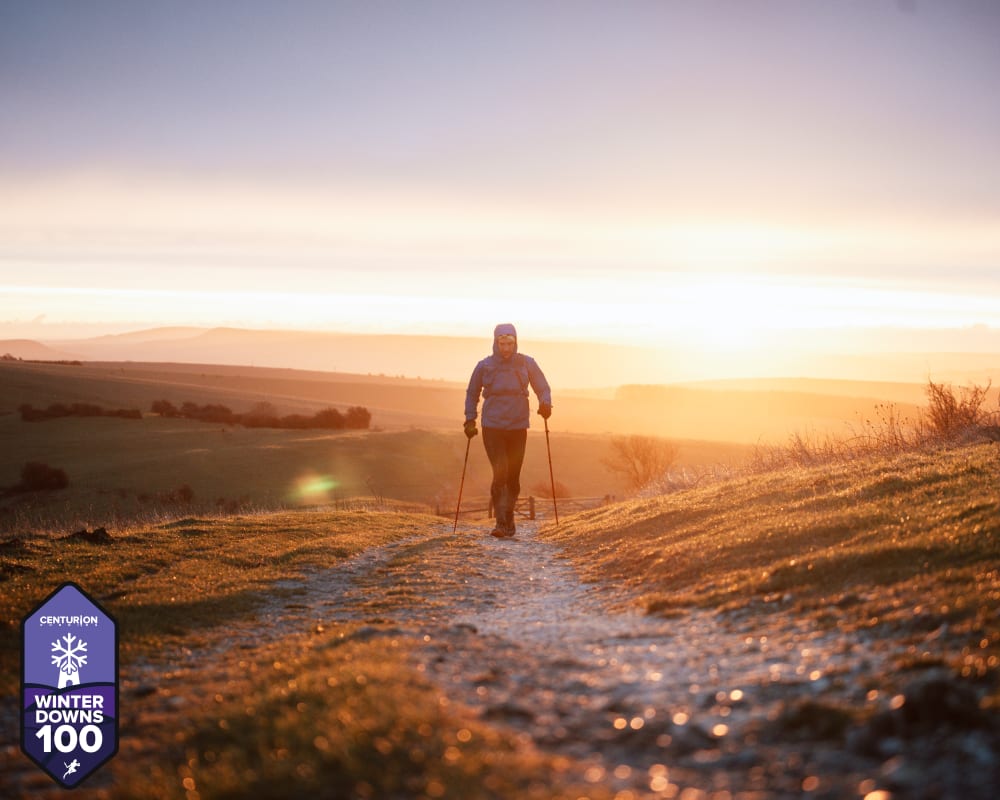
Womens Race:
Laura Watts (Crewed): Three consecutive Badwater finishes in the last three years she has also peppered in lots of other long, hard races. Wins at Leeds to Liverpool Canal Race and Kennett and Avon Canal Race over 130 and 145 miles respectively being highlights, she has also had strong finishes at events such as Spartathlon, NDW100, Daytona 100 and Keys 100.
Emma Nicholls (Uncrewed): Winner of the North Coast 110km this year, she has won or placed on the podium at several difficult coastal ultras in recent years including Arc 50, South West Traverse Extreme (90 miles) and the Atlantic Coast 40 mile. 8th at the Autumn 100 in 2023.
Vanessa Kellie (Uncrewed): 5th at the Cotswold Way Century, third at Wild Horse 200 - South Wales in 2022 and eighth at the Summer Spine Race are stand out results from a consistent performer.
Kasia Atmaca (Crewed): Kasia was fourth at the TP100 this year and was first lady at the Longbridge Backyard Ultra back in January.
Mens Race:
Geoff Cheshire (Uncrewed): Geoff's back catalogue at Centurion events is really impressive. Whilst he has suffered set backs with the occasional drop or finish behind his potential, he has enjoyed incredible success too. He has won the Thames Path 100, Autumn 100 (13:58 course record) - both in 2023 - and the Chiltern Wonderland 50. Finished on the podium in addition at the NDW100 twice. Top ten at Lakeland in 2023, he has won lots of other shorter but competitive ultras too including Race to the stones.
Howard Dracup: Howard has placed third at both the Spine Winter Challenger South and North in recent years. He set the Steve Parr round record in 2020 (subsequently broken) - over 115 miles of rough Lakeland Ground. He was also 17th at Swiss Peaks 360 last year.
Mark Perkins (Crewed): The one the only, Mark remains our all time South Downs Way 100 record holder with his 14:03 from 2024 lasting now over a decade. At that time Mark was together with Dan Lawson, arguably the best in the land. He ran a hair over 12 hours for 100 miles on the track at Crawley. And he won Berlin 100 in 13 hours too. After a long lay off with a persistent injury he is slowly working his way back in to the sport again and the last thing we want to do is put pressure back on him. But after winning the Ring of Fire this summer he has proven he really is back again.
Ben Carroll (Uncrewed): An excellent 248km at Crawley 24hr last year. Has also finished 7th at the GUCR.
Ben Hall (Crewed): Two excellent runs this year so far have resulted in a third at the NDW50 and a second at the CW50.
26 Nov 24 by James Elson
Spine Race Kit 2025
KIT AND LOGISTICS
This area of the post is specifically designed to look at the detail of all aspects of the kit, footwear, apparel, nutrition and miscellaneous items that you need to think about in order to compete safely and successfully in the Spine Races or indeed, for winter in the mountains.
Resources and Advice
Click here to find all of the recommended kit available on our ultrarunning store.
Click here to watch a longform video going into all of the kit for the Spine Race with James Elson (YouTube) - see also embedded below.
Click here to watch the 2025 Upper Body Layering System Update Video
Click here to watch the 2025 Lower Body Layering System Update Video
Click here to watch the 2025 Footwear Update Video
Click here to watch the 2025 Sleep System Update Video
Click here to read James' race report from 2023.
Click here to read the in depth look into the appropriate kit for the Spine Races.
Click here to listen to James' recap podcast of the 2023 event.
Click here to listen to a British Ultrarunning Podcast conversation between James, Dan, five time finisher Matt Neale and 2023 Mens Race Winner Damian Hall.
This video accompanies this post, going into further detail on all of the items below as well as the drop bag and how to think about packing for the race.
Clearly a huge caveat needs to be placed at this juncture. Every single person emerging from the Spine will have a different view on kit, how in functions, what minimum requirements are vs what you actually need to carry.
You need to think very carefully about what you need to carry/ have access to and not just what's on the mandatory kit list. The kit list is there as a safety net and often just in case of emergency. What you actually require to stay safe and perform well at the Spine Race goes far beyond it.
We also need to be realistic about cost and what you do and don't need to buy. Some of the kit is very expensive plus there is of course a large energy cost to production and transport in a lot of cases. So consider what you have already that is fit for purpose, what can be borrowed and what can be hired. As time goes on and we are able to put the time and resource into it, hiring kit is something we'd like to get into - many already do this. The facebook group here is a valuable resource in borrowing kit or getting advice on how to look after it.
Cheaper alternatives are available for everything, always look at the compromise though: Weight vs Packability vs Price. We've picked out the best balance of those three things, in our opinion.
And on that note - as a retailer of ultrarunning gear, all that happened as we went sourcing the best kit, was that we started to stock it. So that we could pass on a collection of kit that was all in one place for runners interested in the race - with first hand, real world advice. We don't stock it all but we're getting there. All of the links take you to the best place to find each product. It might seem salesy but believe me when I say I think the biggest saving is actually hopefully on people's time trying to find good advice and being able to ask questions about kit/ shop from us at the same time. We're here for the detail.
However, we are not the authority on Spine Race kit. If you have any questions or want to check if what you have meets kit requirements for the race, then you should contact the Spine Race and Lindley Chambers who heads up their kit side of things, via his email [email protected] . You can also read his advice and tips on kit and kit check on this page here.
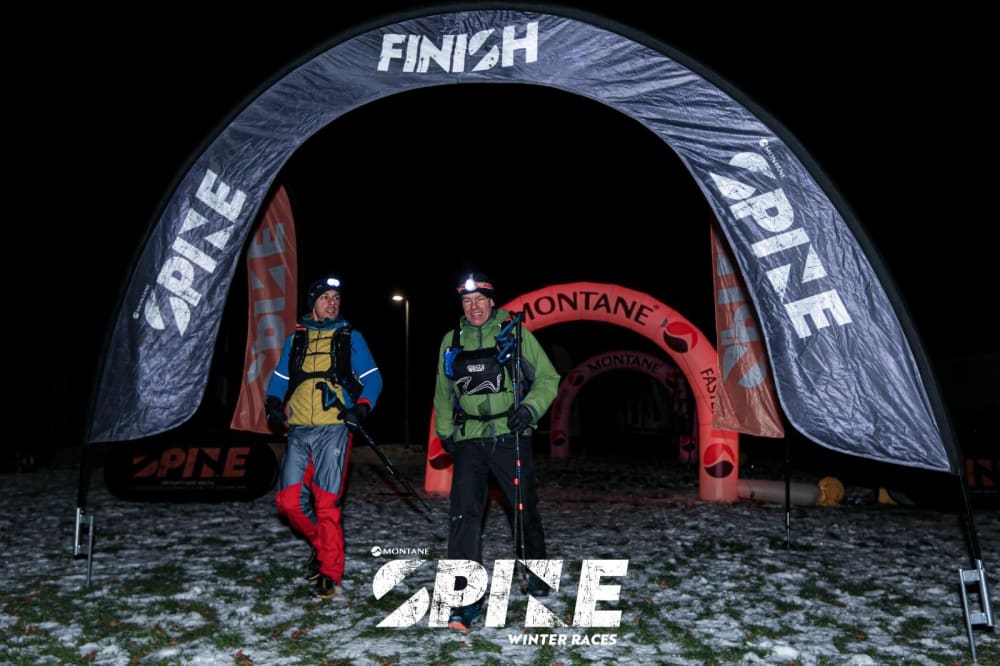
What I've done here is distilled down my experience not just at the Spine but of a nearly two decades of racing in all conditions, utilising a wide range of winter kit over and over again - as well as organising more 100(+) mile ultra distance events than anyone else in the country! I know there will be some people who have no idea of who I am so I have included a short bio at the end of this post.
This kit has been used, not actually mainly in racing but in training and on days out on the hill, in winter. You must get used to using the kit, particularly working out what footwear and what layering systems work for you. I am around 65kg, 5ft7 and without tooting my own horn, tend to move towards the mid to the front of the pack in events. I would say days out over the Wainwrights in winter were a turning point for me. Learning to read the forecast, particularly with regards to wind speeds at height, anticipate clothing requirements, navigate in the dark and mist with map and compass and scramble/ climb very difficult ground - these are the skills that make me feel most comfortable in terrible weather. A lot of my racing might also seem irrelevant but you draw on the experience of everything that has gone before, in events like the Spine. Races/ Rounds I've run that help contribute to choices here include Tor Des Geants, Arc of Attrition, Lakeland 100, Western States, Bob Graham, Paddy Buckley, Charlie Ramsay, Leadville, Lakeland, 4Deserts Series (antarctica being the most cold weather specific). But more so things like the Wainwrights in winter, crossing Iceland on foot and many long days out by myself.
Finally you will find kit suggestions and comments throughout this text which features my own kit. Firstly from two of our team runners - Debbie Martin-Consani who has finished the race twice including a win at the 2022 edition. And Edwina Sutton who finished third in the 2023 race. Finally, from 2023 Mens winner Damian Hall.
A link to the full mandatory kit list for 2024 (and 2025) is available here. All of the below kit meets the criteria for the event.
Footwear:
Clearly, managing your feet is one of the handful of major things to concentrate your energy on. For some time as a team we had been waiting on the La Sportiva Cyklon Cross GTX to come out. We'd sat in a team meeting back in April and Jono Wyatt had pulled a pair out and previous race winner and PW Record Holder - John Kelly - sitting to my right, had asked on the spot if he could possibly just take them home with him. They are effectively an insulated, waterproof, lightweight shoe - that looks like a boot due to the gaiter. The sole unit is La Spo's grippiest rubber. The upper is soft, warm and you can dial it in tight or back it off using the boa system. Then there is a Gore Tex gaiter coming up to ankle height, so effectively there are two waterproof layers to the shoe. This kind of shoe has moved the game on with regards to protection from winter/ very wet or cold conditions. It feels like you are wearing a lightweight shoe, whilst getting the protection of a mountain boot (not crampon compatible as the sole is not rigid enough - great with microspikes of course). Others were still wearing regular trail shoes and asking more of their socks but for me whether you are running up the front or scraping cut offs, this shoe does it all. The other model I had in my armoury was the La Sportiva Blizzard. This is again a Gore-Tex shoe with a debris gaiter, and has a metal stud matrix built into the sole unit - essentially built in nano-spikes so you can run across ice without issue (note these will not pass kit check, you still need a separate set of spikes or yaktrax).
The other component of course, is socks. I hadn't worn waterproof socks since the Last Desert Antarctica in 2008. But I got hold of some Dexshell Compression mudder socks and quite frankly they became the most important piece of kit I had. They are impermeable to both water, but also to debris. And at knee height you have to be in a very significant bog or river to get water in the top. If that does happen, they then insulate that water like a wetsuit, and keep your feet warm.
I had no liner sock, just the Dexshell. I started in the Cyklon Cross. Because it was minus 2-3 in the valleys and 6-7 on the tops all week, every hard surface was covered in ice so I then used the Blizzards for Day 2 and 3. Before going back to the Cyklon Cross for the last two sections.
All four of the runners mentioned on this post including myself, Debbie, Eddie and Damian all used the same DexShell sock for this race.
2022 Womens race champion Debbie Martin-Consani used a liner sock in combination with the DexShell and had just as much success with her feet - Debbie talked about her foot route in a post-race intstagram post here. Liner socks should be thin, it is well worth experimenting with both options in your training. Damian Hall comments: 'I too use DexShells and tend to wear a toesock as a liner. The only problem I've had is from feet being too warm in conditions less severe'. Again, test them in training.
With the Dexshell Sock, and then the Cyklon Cross/ Blizzard I had zero blisters (i had one small bit of skin come off at the finish because i tore off a bit of preventative tape too soon with wet skin underneath), zero hot spots, never once got cold feet and always had the grip I needed. I took my shoes and socks off in at the 144 mile check point and the medic asked me where I'd washed my feet - they stayed that clean and clear. The Blizzards - after 40 or so hours began to make my feet tender, I think where the sole is more rigid and the spikes less forgivining but they were priceless for the icy rocks, hence the switch back to the Cyklon Cross. I take half a size up in both to allow space for the thicker Dexshell Sock.
So as an N of 1 sure, but if you want to get through the Spine without foot issues, there's a good system to try. This is more of an invidivual area than almost any other part of your race strategy, besides nutrition.
Separate Spikes or Yaktrax are part of mandatory kit. Nanospikes won't pass kit check. I would always carry a Yaktrax for speed and weight, but also have my Kahtoola Microspikes in the drop bag. These are essentials for any winter mountain day anyway, will see plenty of use! I've had my Yaktrax since 2008, still going strong.
La Sportiva Cyklon Cross GTX - Unisex
Salomon S/Lab Genesis Spine as an alternative to the Cyklon Cross - Unisex
La Sportiva Blizzard
Dexshell Mudder Compression Socks
Kahtoola Microspike
Yaktrax
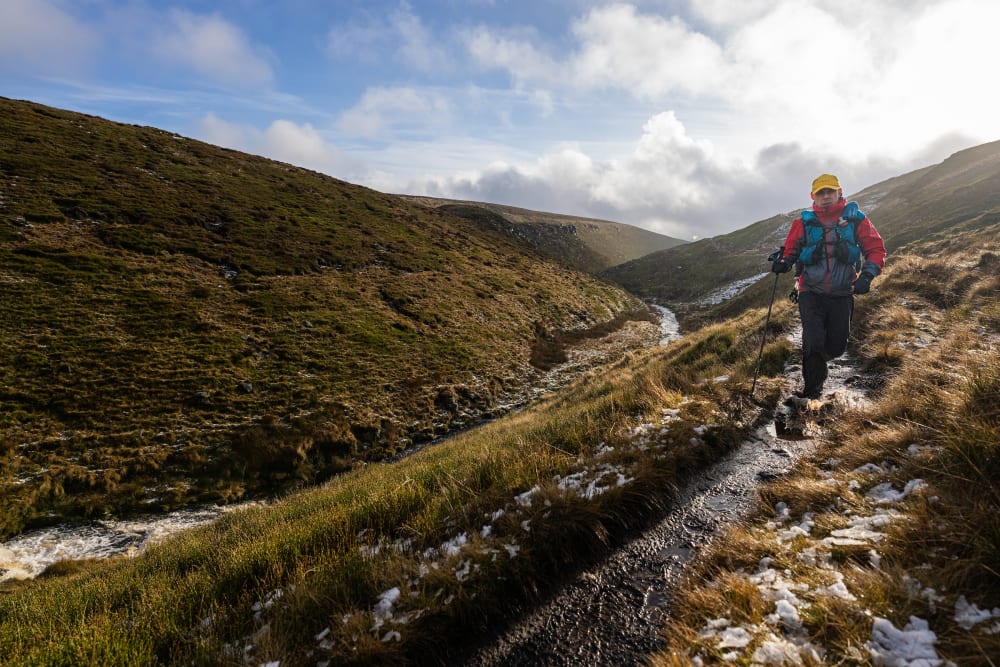
Freezing waterlogged paths - but no water ingress or foot problems.
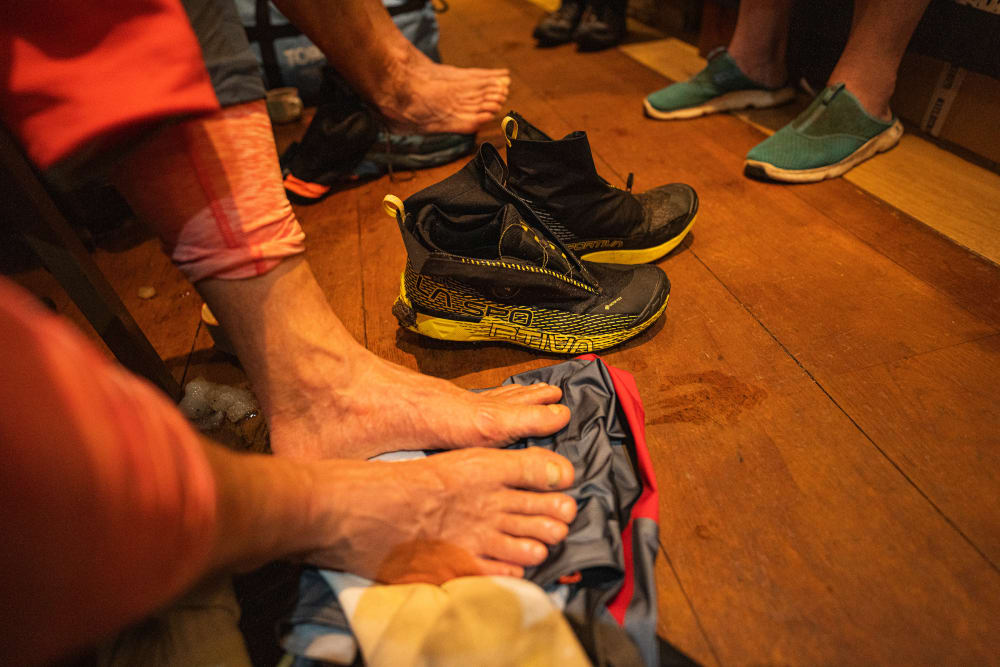
Kirk Yetholm: Completely blister free, dry feet. (Photo c/o Steve Ashworth)
Lower Body:
All through training including in sub zero temperatures for many hours, I'd worn one pair of tights and lightweight waterproof trousers. But in the race this was simply not enough. I ended up putting on a second pair of tights and then a waterproof trouser. I needed two pairs of tights to stay warm enough at the coldest times. Remembering then that these stayed largely dry through the race, I didn't touch my spare/ third pair but you need to carry one additional pair to that which you are wearing. I can't see getting away with less than three pairs of tights is viable, and a fourth would be wise.
As for the trousers, the Drizzle Pant (unisex) is a light, tapered running waterproof trouser, you feel like you can move fast in them. This was good for almost everything, you could put on a heavier Gore-Tex weight trouser in wetter weather however, that could be a valuable addition.
On the lower half, Damian Hall, moving on the whole much faster (than almost anyone else!) found that one pair of tights was often enough, with a pair of lightweight waterproof trousers over the top just for the very worst sections. But certainly for us slower movers a bit more protection is worth getting used to in training.
Montane Slipstream Tight Mens | Womens - 3 Pairs
La Sportiva Drizzle Pant
Montane Spirit Lite Gore-Tex Waterproof Trouser Mens | Womens
Upper Body:
This is a huge area, clearly. A good mountain layering system and an understanding of that is worth looking at. I know some runners will simply stick a Buffalo Jacket on and that'll cover almost anything they need. But I prefer the layering because it allows flexibility around conditions.
You should look at having a base layer. Two mid-layers - ideally a breathable fleece type material and a heavier weight fleece jacket, a primaloft jacket and two outer shells - a windproof and a waterproof.
For the majority of the Spine I had on six layers. Base Layer - La Sportiva Jubilee. Mid-weight fleece - the OMM Core Jacket which is super light, breathable and packs suprisingly small. A La Sportiva zip up fleece hoodie / Montane Protium Hooded Fleece. My La Sportiva Primaloft jacket. My Blizzard Windproof. A Montane Gore-Tex Active outer shell which I had on in the wet/ snow showers only. In training, I never had more than three layers on. But thermo-regulation goes out of the window several days in and you need to anticipate wearing far more than you ever will in preparation.
You then also need to have back ups for these layers. They will get wet at some stage. Having spares in your pack and your drop bag, is essential. Here's how and why.
Before a base layer for us men, Eddie Sutton adds 'this sports bra is thick (think free extra warmth) but has no seams and a large surface area to protect back. I had no chafing under arms or on back and it never felt wet so I didn’t get cold.'
A good base layer needs to be able to move moisture away from your body whilst insulating to a high degree here. The truth is at the Spine you are only really sweating up on climbs and even then if you are, you need to look at your effort level. I had several, one on me, one in the bag (that is the mandatory kit rule - one spare base layer not in use) and then a couple in the drop bag.
A good quality Waterproof Jacket is obviously crucial. Whilst a 10k/10k lightweight jacket will pass kit check, it's absolutely inappropriate to start this race with something that lightweight. The minimum level I'd suggest for the race is Gore-Tex Active. Right now we have the privielege of being able to wear a Gore level jacket which weighs close to nothing. The jacket I had for the majority of the race was the Montane Phase Nano. This is the evolution of the Spine Jacket. They are both Gore-Tex Active which translates to much greater protection than any of the other lightweight (10k - 20k range) jackets, durable, adjustable hood and hem and extremely lightweight. The womens edition of the Phase Nano is not out until September 2023. So the Spine jacket for both men and women and then the Phase Nano Mens from Spring and Womens from Autumn 2023 are the pick of the bunch for me.
Eddie Sutton comments 'I had run in a montane spine jacket for a few years size 10 one…then about a month before the race I purchased a size 12 one which I wore for the race and was so pleased I did. It enabled me to wear more layers underneath, I had more mobility and it was easier to get the hood up and down. I then took the size 10 in my drop bag ready to double layer if I needed to but we had a dry year!'
Some will point to needing heavier jackets than this - Gore-Tex Pro, higher denier grade material will stand up longer to bad weather, but that is personal preference - again weight vs packability vs protection - I believe Gore-Tex Active in these latest Montane jackets is the way forward.
You could certainly argue the case for needing one or two spare jackets too - if you are soaked through and keen to leave a check point in a hurry.
I would put a good windproof up there as just as important as a waterproof. There were times during the race where the wind was up to 40mph and on a -6 temperature reduced wind chill to -15. That cuts straight through a waterproof because of the nature of the material, where a windproof offers substantially more warmth/ protection. It still amazes me how a garment I use almost every day is so neglected in the running world. The Blizzard and Briza are nnot much over 100 grams and provide that layer of protection.
Finally the Primaloft layer, go for primaloft and not down. Primaloft still works as an insulating layer when it wets out but down does not.
Inov8 Merino Long Sleeve Base Layer Mens | Womens
OMM Core Jacket Mens | Womens
Montane Protium Fleece Mens | Womens
Montane Phase Nano Mens | Womens
Montane Fireball Lite Mens | Womens
La Sportiva Blizzard Windproof (unisex)
M&S Reversible Seamless Sports Bra
Headwear:
The main way you will regulate your temperature during the race is by removing or adding hat/ headwear and hoods. Far simpler and quicker than removing layers. The Core Beanie from OMM is breathable, so you don't get a sweaty head. It weighs next to nothing and is made out of primaloft active.
Another good option is a headband which allows your head to release the heat whilst ensuring you don't get cold ears, which can be a real issue.
Hoods up or down in conjunction with how cold / windy it is - the hood on your windproof being the main one to use.
I also wore a Weather Resistant/ Waterproof Cap for the first day when it rained hardest, just to re-inforce the peaked hood on the waterproof jacket and ensure rain stayed off of my face.
Take plenty of buffs. We all have them. Good for face covering, extra warmth/ neck cover, head cover and of course wiping stuff up!
OMM Core Beanie x 2
OMM Kamleika Waterproof Cap
Centurion Versatile Head and Neck Wear
Gloves
Understanding combinations of gloves based on how cold and wet your hands might get is obviously as important as any other facet of your kit. If you lose operation of your fingers, you can't eat, undo bottle caps, undo zips/ change clothing. Basically somewhere between inconvenient and dangerous. Getting into this situation was the defining factor for me in bailing off of a second Barkley loop in 2019! I got my kit wrong when the weather turned very quickly and couldnt' navigate or do my jacket up.
A liner glove, with fingers is worthwile and worth having several pairs of. I'd start with one on and one in your bag (mandatory kit). Then a couple more spares in your drop bags.
As a warm overmitt, always go for Primaloft over Down, because when they get wet - the primaloft will still work as an insulating layer. The Montane Prism Dryline is their warm Prism Mitt, super soft, comfortable and light, but with a pertex waterproof layer. I had three pairs. One on. A spare in my pack. One in my drop bag.
Then a waterproof outer glove for really harsh conditions - the Minimus overmitt also from Montane. Just one pair of those.
Montane Trail Lite Glove Mens | Womens
Montane Prism Dryline Mitt or Mens Glove / Womens Glove as per preference x 3
Pack/ Belt:
During the race I used 2 different packs. I started out with an old S/Lab Peak 20 which was a skimo pack from 2017 - basically an old faithful. Before I got hold of a Montane Gecko 20. It was a case of using what I was used to. I switched to the Gecko 20 at Middleton when the back zip failed on the Salomon and that must have been fate. Because the comfort level of the Gecko is incredible. For me it is the superior option and I wished I had started in it. The best features in my opinion are the adjustable straps across the front which allow cinching around unknown layers of clothing, and the comfortable waist belt that takes some of the load off of your shoulders. But particularly the soft elastane blended material and side pockets. Unlike almost any other pack you can reach straight into them, just down of your waist but close to the front, and stuff them full of almost anything you might need on the run. Honestly they are like Mary Poppins' bag. The fit is exceptional, so comfortable and despite the weight you barely notice you have it on. For me, there was always ample space in the back - I packed light but then added a complete set of spare clothing on the top for easy access and there was ample room. I also used a Naked Band for additional space early in the race, particularly useful for excess nutrition.
Eddie sutton also used the same back and trained and raced exclusively with it. She comments 'it's a super comfortable pack, I didn’t feel the weight or pack rubbing (but I trained a lot with the pack too!) I brought an extra chest strap from montane and attached that high up which made a huge difference too.'
For further space, the OMM Chest Pod is compatible with almost any vest or pack, by adapating the fastenings that are provided with it - giving you front access to another 4 litres. I have never found I have needed this, but many in the race use this set up.
For greater capacity - if you are someone who plans to carry bulkier jackets, extra food, or less packable sleeping bags etc, then the best 30 litre option is the UD Fastpack 30, or FastpackHer 30. Again with the belt added for more space.
Montane Gecko VP20+
Naked Waist Band
OMM Chest Pod
Ultimate Direction Fastpack 30
Ultimate Direction FastpackHer 30

Centurion Coach Eddie Sutton rocking the Montane Gecko VP20+ en route to third place at the 2023 event (Photo: Steve Ashworth)
Lighting:
My go to lamp for the last 3-4 years now has been the Petzl Swift RL. Light, packable, easy to change rechargeable battery, long lasting and plenty of light and power. But. I found out during the first night that the lamp didn't like just how cold it was here. It's not been asked to do that duration in that cold before and because the battery was front mounted on my head, it was more exposed to that cold and seemed to drain quickly. That is anecdotal, lithium batteries should not drain any faster in that level of cold per se but that was my experience here. The batteries were all fully charged.
So I switched to my Petzl Nao RL which is Petzl's newest headlamp offering. On low reactive setting I got tons of light, more than I ever needed, and one fully charged battery lasted over 20 hours. I would only ever choose this lamp again. It's light, the battery is on the back which balances the weight out on your head, and crucially means it is protected from the bitter cold by your hood/ gets less cold.
A rear Red LED is mandatory. Rather than a cheap one which will likely break, I attach a Petzl E+Lite which has the added bonus of being usable as a back up emergency lamp with several other settings.
Petzl Nao RL x 2
Spare Nao RL R1 Batteries - x 4
Petzl E+Lite
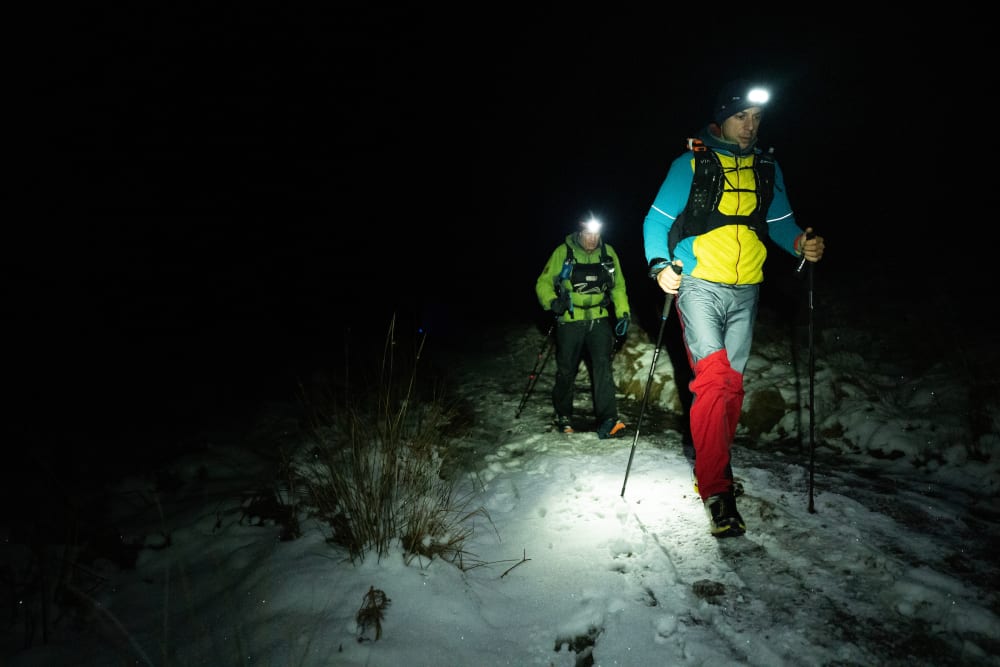
20 hours plus on low reactive setting with the Petzl Nao RL - always enough light to move well. (Photo: Steve Ashworth)
Sleep System:
Full disclosure here, I used this in training and on the freezing cold floor in Bellingham but I did not Bivi out during the race. The Thermarest Hyperion 32 has a comfort rating of 0 degrees C. It is super lightweight, but immensely comfortable and feels substantial despite how small it packs down. It is the minimum rating to pass kit check, but honestly with the Mat, Bivi and Clothing you have, it is unlikely that you will require more than this bag. We also stock the Hyperion 20 which is rated down to -6C for those who plan to bivi out or who want that extra layer of safety/ comfort. You can of course find other marginally lighter, extremely expensive alternatives but with performance vs packability vs weight, this is the optimum bag for me.
The sleep pad - I opted for the lightest as once again, I wasn't planning on a bivi unless in emergency - but I am happy having bivi'd on it before that whilst not the most comfortable night, as an insulating layer it does everything you need eg. gets you off of the freezing cold ground which is conducting your body heat away very quickly indeed. The Neo-Air Uberlite inflates extremely quickly and is a pass at kit check. Again it feels substantial. To me, the mat is the least important thing. If you try to inflate a mat like this with little or no shelter in high wind in an emergency you may as well be holding onto a kite. You need to get the bivi out first and try to inflate the mat inside of it whilst pinned down and ideally behind shelter. You need to practice these things in training!
With the bivi, I have again gone super lightweight, almost as light as you can go. The less durable bags eg SOL will fail at kit check. This is a waterproof bag with taped seams and perfectly adequate to keep you protected for short sleeps or awaiting assistance. This isn't a bag I'd hang out in year round for comfort - but that isn't why I am carrying it during this event.
Thermarest Hyperion 32F/0C Sleeping Bag
Thermarest Hyperion 20F/-6C Sleeping Bag
Exped Ultra 1R M Mummy Sleeping Mat
Exped Uno UL Ultralight Bivi
Navigation:
The Pennine Way is not a well marked trail. You will find finger posts and the acorn symbol in lots of places. But nothing it all in much greater amounts. Map and compass are mandatory kit and for good reason. If you'd had your watch die and/ or your OS App jumping all over the place in heavy clag on the high mountains, you need to be able to use them. Again for me it was a hard lesson on top of Red Pike by myself winter in serious conditions when the electronics all failed that forced me to take 'thumbing the map' more seriously. But, I would use the maps as a back up here because you ideally want hands free for poles, eating and gates. So use the excellent GPX trace, uploaded on your watch. It will tell you when you are going off course and when to make a turn. The Coros Vertix 2 has the longest battery life of any watch going, so we stock that to try to ensure least charging time.
The handheld GPS you will see some using as a primary navigation device but more often than not it is a back-up. We used it on the Cam Road section on the longest stretch between check points, when my watch died. The Garmin 66S is easy to use even with big gloves on, takes 3 x AA batteries which are easily changed and is essentially bomb proof navigation. You need to learn to use the funcationality before you head out, you will need to upload the right maps for the Pennine Way - it doesn't come with these built in and you will be best off leaving it switched on, so if you do need to use it it is already there with the route and your position on it, not loading up in harsh conditions as you stand around waiting for it.
Reference a compass, I personally prefer a thumb / orienteering compass, but that won't pass kit check here so get a solid reliable compass like the Silva Ranger instead.
Garmin Fenix 8 PRO
Pennine Way Harveys Map: North and South
Garmin 66s Handheld GPS
Silva Ranger Compass (coming to store soon!)
Poles:
I'm not sure if anyone went without poles but I'd be suprised. For stability, for measuring the depth of bogs - seriously, and for more efficient forward movement they have to be considered essential. Whilst I am a huge fan of Leki's Ultratrail FX.One Superlight poles which I used for TDG, I have always used a Black Diamond Carbon Z or FLZ pole when wearing gloves. They are super light, durable, fold down quickly and easily when out of use and most importantly have an easy to adjust hand strap so that I am not trying to squeeze the otherwise excellent Leki Shark Glove system over several layers of changing glove types. The FLZ have the added bonus of being height adjustable on the move.
Poles: Black Diamond Distance Z Poles
Stove/ Cooking / Eating System:
Aim for me is to be able to boil water quickly and simply but for it to be reliable. Whilst meths is lighter and more packable, the chance of a leak and the hassle of the longer burn time don't make it worth it for me. So I like gas options. Stoves are tiny these days and I use an Alpkit Kraku screwed straight into the gas canister, with storm proof matches to light. Remember you can't blow these out! So get used to letting them burn out in your hand like a sparkler! The Bugaboo mug from GSI is titanium so super light and useful obviously for drinks at the CPs - it is also good to use on the stove and boils extremely quickly, the 400ml limit you need to carry for kit - also coincidentally the amount you need for most rehydrated meals. I'd say good going less than 5 minutes to brew. The bugaboo will be HOT when you pick it up, but the handle is separated - so make sure you wear a glove and within a minute or two is fine to hold. Again, I wouldn't use this system day to day but on the spine (the bugaboo is not meant for this, it will eventually start to deform if you burn it for ages and ages) but it's everything I need here and more. The Titanium Spork from Optimus weighs nothing.
For flasks/ water, it's worth carrying insulated soft flasks so that your fluid has less chance of freezing. My flasks froze several times leaving me an issue on those sections. It is also worth carrying a filter bottle which you can then decant, if you choose to or need to fill up from questionable sources.
Alpkit Kraku Stove
GSI 110g Isobutane Gas Compatible with that stove
LifeSystems Storm Proof Matches
GSI Bugaboo Cup
Optimus Spork
Salomon insulated soft flasks x 2
Katadyn Befree Filter Flask 600ml
Medical
Take a decent medical kit with you. Look at what is on the kit list, ensure you have it all but also think - what do I really need to carry? Pre-taping feet and having the right, quick to use tools to do that is something to look at pre-race. I am not a big fan of pre taping, but the conditions at the Spine are unique and by adding tape strategically you can often offset some of the worst problems. Remember, don't get into a check point and rip the tape off. Be careful. Your skin will be moist underneath and will tear more easily, so take extreme care when removing and replacing tape.
Lifesystems Waterproof Micro First Aid Kit
Lifesystems Blister First Aid Kit
Other Mandatory Kit
Lifesystems Hurricane Whistle - far better than the one that came free with your pack. They will make you blow it at kit check!
Swiss Card Knife/ Scissors - This is an expensive option but essentially gives you lots of other useful kit for almost no weight/ size. The blade passes kit check in length. Cheaper replicas are available.
Bolle Safety Goggles - Light and cheap. Tinted expensive ski/ mountain goggles won't pass kit check, you need a clear goggle. These are worth getting used to in training as they need to be adjusted to feel comfortable. Lots of similar options in their range, must have a headband.
GSI Cathole 'Poo' Trowel and Tissues plus poo bags
Food and Drink
This is perhaps the most individual area of all. My advice to you is to consider carrying not just the 3000kcal minimum you are required to have, leaving each check point, but ensure what you have is going to be appealing and easy to consume over very long periods.
In races in the past I have consumed exclusively gels - including at Western States in 2011 where I ate 70 Gu's. For this race I took almost no sports nutrition with the exception of some Maurten 320 CAF 100 drink mix primarily for the caffeine overnight.
The other critical component is thinking about freeze dried meals. You won't need these at the check points which are very well stocked, but you will benefit from them at certain points in between. Either at the 0.5 check points or at the pop up locations with MRT where hot water is given. Or again, if you stop to brew up yourself.
I ate all of these things during the race and these options worked best for me. This is a very individual area however.
Expedition Foods Freeze Dried Meals
Gu Stroopwaffels
Chia Charge Mini Bars
Clif Bar Mini's
Maurten 320 CAF 100
Succeed! S! Caps
Non Mandatory but Borderline!
Battery Packs: I used two larger power banks here in my drop bag, to charge batteries between check points. And then two smaller ones here that I carried on my person. Plug sockets whilst available at some check points are far from guaranteed. This system allowed me to charge everything for 5 days, with plenty of power to spare, without ever needing mains power. My watch, headlamp and phone cables, I carried in my bag to recharge on the go - I only needed to do that between Hebden and Hawes due to the length of that section. But it was nice to know I had that option if I needed.
Lifesystems Ear Plugs - It's noisy in the bunk rooms!
Anti Chafe: Bodyglide
Dry Bags: The Ortlieb 13 litre dry bag fits nicely in the Montane Gecko 20 and is truly waterproof/ hard wearing. I then use lighter Exped Fold Lite Dry bags for other kit and my bags to go inside drop bag bags.
Repair Kit: OMM Waterproof Patches, Cable ties, Duct Tape, KT Tape, bungee. Shoe, pack, pole, clothing repairs are almost certainly going to be required at some stage.
BIO
My Spine Race finish in 2023 came 17 years almost to the day, fter my first ultra.
I began in 2005 and my first big adventure was the MDS. I went on to become the youngest finisher at the time of the 4Deserts Series including multi-stage races across the Gobi, Atacama, Sahara Deserts as well as on Antarctica. In 2009 I began running 100 milers and have finished quite a few of the bigger marquee events to date including:
Western States, Leadville, UTMB, Arc of Attrition, Lakeland, WHW Race, Caesars Camp, Old Dominion, Rocky Raccoon (x 5), Autumn 100 etc.
I've also explored the longer single stage races finishing Badwater, Spartathlon, GUCR, many 24hr races including 2 Silver medals in a GB vest and more recently the Tor Des Geants.
In 2011 I started Centurion Running and we've had a stable of 50 and 100 mile races since that time. I have personally Rd'd over 50 races of 100 miles or more and 30 x 50 milers in that time.
Outside of racing I ran the Bob Graham in 2014, the Paddy Buckley in 2021 and the Charlie Ramsay in 2022 made me the 73rd person to complete the Big 3 in under 24 hours. In 2015, I ran across Iceland with Robbie Britton - a very cold expedition over 7 days/ 200 miles. I completed my Wainwrights journey many years ago with many wonderful solo days out in the hills in all conditions.
In addition I've run 150 marathon+ events with a PB of 2:43 and fi
24 Nov 24 by James Elson
Spine Race Sleep System - 2025 Season
This video focuses on the Spine Race Sleep System with an update for the 2025 season.
Resources and Advice
Click here to find all of the recommended kit available on our ultrarunning store.
Click here to watch a longform video going into all of the kit for the Spine Race with James Elson (YouTube)
Click here to read James' race report from 2023.
Click here to listen to James' recap podcast of the 2023 event.
Click here to listen to a British Ultrarunning Podcast conversation between James, Dan, five time finisher Matt Neale and 2023 Mens Race Winner Damian Hall.
This video accompanies this post, going into further detail on all of the items below as well as the drop bag and how to think about packing for the race.
18 Nov 24 by James Elson
Spine | WD200 | Winter Running 2025 Update: Lower Body Layering System
This video focuses on the pick of Winter Running lower body layers and socks for 2024-2025, with the Spine and Winter Downs events in mind. But also for all round winter running.
Resources and Advice
Click here to find all of the recommended kit available on our ultrarunning store.
Click here to watch a longform video going into all of the kit for the Spine Race with James Elson (YouTube)
Click here to read James' race report from 2023.
Click here to listen to James' recap podcast of the 2023 event.
Click here to listen to a British Ultrarunning Podcast conversation between James, Dan, five time finisher Matt Neale and 2023 Mens Race Winner Damian Hall.
This video accompanies this post, going into further detail on all of the items below as well as the drop bag and how to think about packing for the race.
17 Nov 24 by James Elson
Spine | WD200 | Winter Running 2025 Update: Footwear
This video focuses on the pick of Winter Running footwear for 2024-2025, with the Spine and Winter Downs events in mind. But also for all round winter running.
Resources and Advice
Click here to find all of the recommended kit available on our ultrarunning store.
Click here to watch a longform video going into all of the kit for the Spine Race with James Elson (YouTube)
Click here to read James' race report from 2023.
Click here to listen to James' recap podcast of the 2023 event.
Click here to listen to a British Ultrarunning Podcast conversation between James, Dan, five time finisher Matt Neale and 2023 Mens Race Winner Damian Hall.
This video accompanies this post, going into further detail on all of the items below as well as the drop bag and how to think about packing for the race.
15 Nov 24 by James Elson
Spine Kit/ Winter Downs and Winter Running 2025: Upper Body Layering System
KIT AND LOGISTICS
This area of the post is specifically designed to look at the detail of all aspects of the kit, footwear, apparel, nutrition and miscellaneous items that you need to think about in order to compete safely and successfully in the Spine Races or indeed, for winter in the mountains.
Resources and Advice
Click here to find all of the recommended kit on our ultrarunning store.
Click here to watch a longform video going into all of the kit for the Spine Race with James Elson (YouTube)
Click here to read James' race report from 2023.
Click here to listen to James' recap podcast of the 2023 event.
Click here to listen to a British Ultrarunning Podcast conversation between James, Dan, five time finisher Matt Neale and 2023 Mens Race Winner Damian Hall.
This video accompanies this post, going into further detail on all of the items below as well as the drop bag and how to think about packing for the race.
3 Nov 24 by James Elson
Wendover Woods 50 2024 Preview
The eighth edition of the Wendover Woods 50 kicks off this coming Saturday 9th November at 0930. After a summer edition in 2023 where it formed part of our our Wendover Woods Weekender - the race returns to it's traditional place in the calendar, as the regular season finale. It always feels like a party because of that, but also because of the looped nature of the course, with runners returning to our base in Trig Point Field four times to join in the fun, before crossing the line to finish at the end of their fifth, 10 mile lap.
Conditions in November in the woods are good for the time of year on the whole because they drain so well - the chalk ridge running off steeply in all directions. Individual sections can get muddy but right now the course is in good shape and if heavy rain steers clear from now until after race day, there will be some fast times but that is all relative, as the course boasts 10,000 feet of climb and descent making it one of the hilliest races in the southern part of the country. The 15 hour cut off is 2 hours longer than any other 50 miler we host.
This year we have a field of 300 and what as always looks to be some good racing at the front both races. Here is a look at the likely leading contenders.
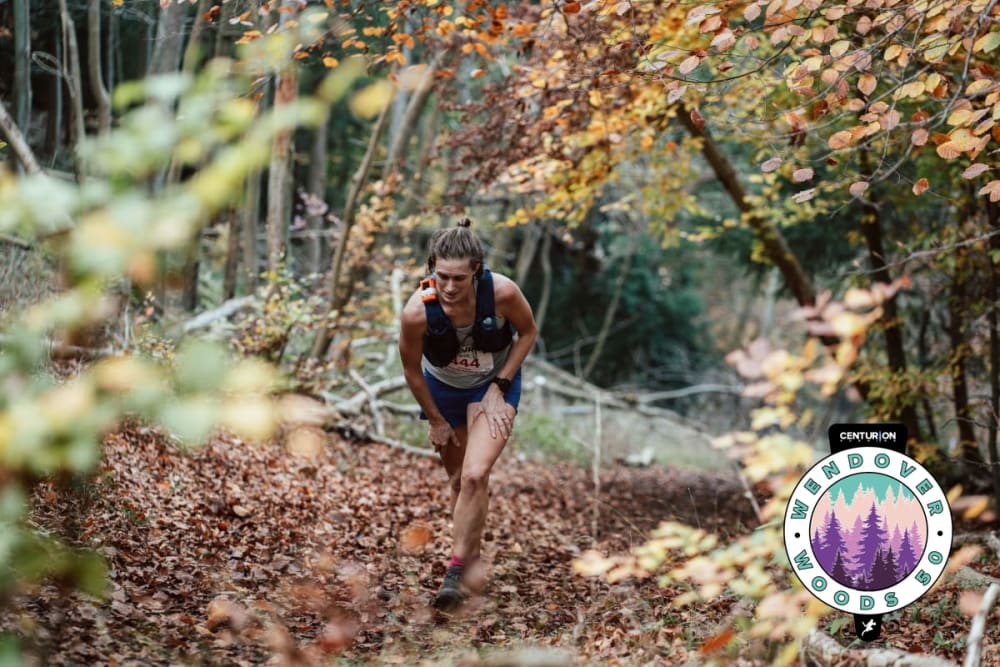
Fi Pascall on route to a course record win in 8:33 back in 2022
WOMEN
Holly Stables: Holly is our long standing North Downs Way 50 record holder. The ex-GB Marathoner with a best of 2:37, has now been running ultras for over a decade and in that time has taken wins at the Autumn 100, Ultravasan, Cotswold Way Century and many shorter events. 7th at Comrades, two top ten finishes at CCC - she has done brilliantly internationally too. This year she came home second at the Arc 50 back in January and has raced plenty of shorter events too cracking 3 hours at Manchester Marathon and more recently running 84 minutes for the half at Amsterdam.
Michelle Attridge: Michelle is our 2024 50 mile Grand Slam leader having won the South Downs Way 50 back in April and followed that up with a second at the North Downs Way 50 in May. She’s raced several times internationally in between times and done well in all. She finished third at the Chiltern Wonderland 50 in September, dropping back from the lead in the closing stages, but that still gives her a healthy margin in the overall slam standings over 69 minutes over second place Ally Whitlock.
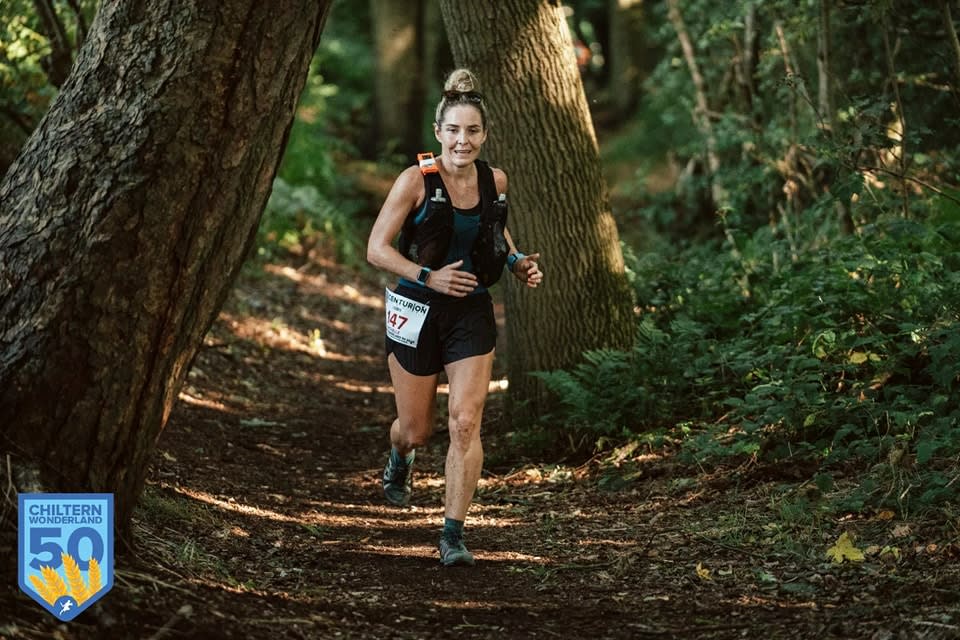
Michelle at the CW50 in September
Ally Whitlock: Currently second behind Michelle in the Grand Slam table with a third, a fourth and a ninth so far this year. She also finished third at the NDW100 in what has been quite the year of racing. Previously she’s finished many of our races in the top ten and on the podium in more recent years including the Autumn 100, Winter Downs 200 and Wendover Woods 100.
Sophie Power: SheRaces founder and Team GB international Sophie, returns to this event for the second time, having finished third here in 2022. In the interim, she has gone from strength to strength with two sensational 24hr performances in 2023 in particular, a 235km at Crawley and then a 227km top 20 finish at the World Championships in Taipei. She has scores of superb performances to her name over the 15 years, but most notably for us she was one of the pioneering few who finished the first ever Thames Path in 2012, in truly atrocioius conditions back when it was held in early March!
Helen Moss: Helen finished second at the South Downs Way 50 this year under 8 hours, dropped a little further back in the Grand Slam standings with an 11th at the NDW50 in May but then turned it back around with a fifth place at the Chiltern Wonderland 50. She is a previous winner of the Chiltern Challenge with XNRG and the Downslink Ultra.
Becky Pearson: Becky is enjoying a fantastic 2024 with a fourth at the SDW50 and a seventh at the SDW100 already this year.
MEN
Alastair Courtney: Fresh off of the back of a win at the Chiltern Wonderland 50. Alastair is having quite the year with us. Third at the Hundred Hills 50km in a super competitive field, he went on to win the South Downs Way 50 in 6:27 and took second at the North Downs Way 50 in 6:38. He leads the men’s Grand Slam 50 mile table.
Matt Hammerton: Matt set the Wendover Woods Night 50km course record in 2022 when he ran a storming 4:27 to win by over half an hour. That record was lowered by GB International Joe Turner in 2023, but only by 3 minutes. This year Matt finished fourth at the SDW100 in 15:04.
Pete Windross: Known by all at Centurion for being one of the most consistent performers over many years. With wins at the SDW100 and TP100, as well as several Grand Slam 100 mile finishes - Pete rarely steps down to 50 miles so it's good to see him racing here. This year so far he's taken a third at the SDW100 in 14:48 and a seventh at the TP100, both of which were his seventh finishes at each event.
Tim Bradley: Fifth here in 2022, Time went on to become our 2023 South Downs Way 100 champion. He also won the Spine Challenger North that year. This year he ran home 35th at Lavaredo in a solid international field.
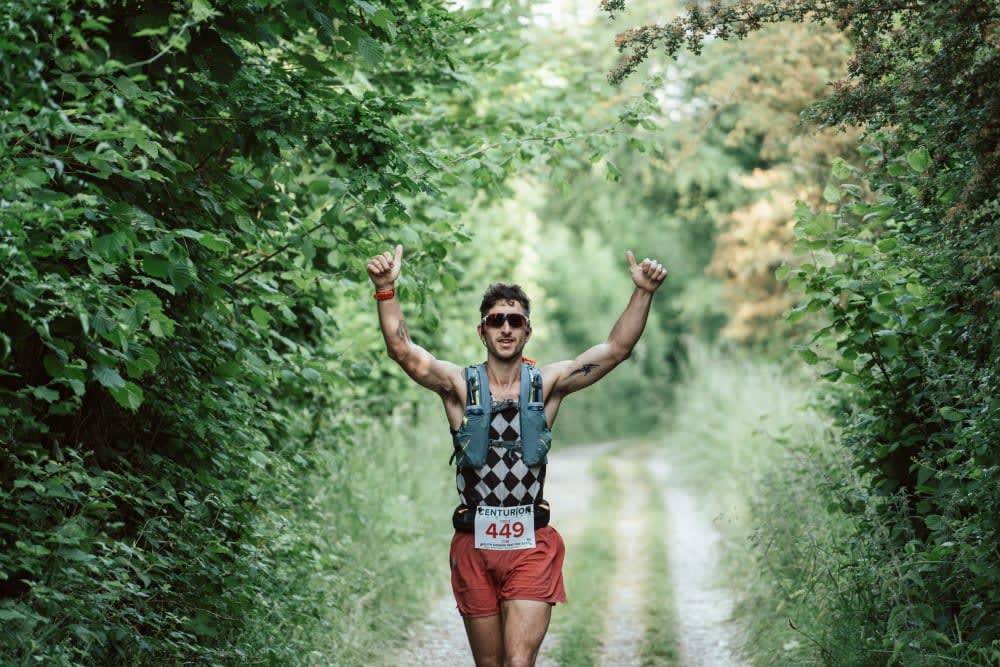
Tim Bradley on route to winning the SDW100
Sam Downing: Second at the Arc 50 last year and the second fastest all time on that course. Has a string of other top tens including the Arc of Attrition, Dartmoor in a Day 50km, Serpent Trail 50km and the Classic Quarter.
Mike Jones: Mike was the founder of the Ultra Trail Snowdonia and is the man behind the Apex Running events. But as an athlete he achieved great success, becoming a winner at Lakeland 100 in both 2016 and 2017. After some years out dealing with a few issues it was great to see him back nearer the top of his game as he took sixth at the same event again this year.
Tom Hedges: Tom was second at last years Chiltern Wonderland 50, previously finished fourth at the Night 50km version of this event and won the Humanity Direct Chiltern Ultra held in the same area, this year.
Mark Potts: Mark finished fifth at the Chiltern Wonderland 50 in September. His real home ground is the Pennine Way though, having finished second at both the Spine Summer and Spine Winter full, as well as having previously taken the victory at the Spine Summer Challenger.
Sam Harper: Sam was second at Race to the Stones in 2023 and third at the North Downs Way 50 in 2022.
Iain Ward: Winner over the past year at both the Norfolk 100km and Peddars Way ultra, both quite different in profile to Wendover of course!
Follow the race live via the link here or on the homepage available later this week.
6 Oct 24 by James Elson
Autumn 100 2024 Preview
The thirteenth edition of our classic regular 100 mile season closer - the Autumn 100 kicks off this coming Saturday 12th October. The course features a series of four, 12.5 mile out and back legs - two on the Thames Path and two on the Ridgeway. With the Thames Path in flood until recently there were concerns over the going on leg one in particular, but a dry week and some sunshine has removed any issue and barring a last minute sustained deluge the race will be run on the normal course.
The mens course record of 13:58 (co-incidentally owned by Geoff Cheshire who is on our marking team for this years race) does not look under immediate threat, however the womens record, held by Susie Chesher since 2016 looks the more likely to go with a high calibre womens field set to toe the line this year.
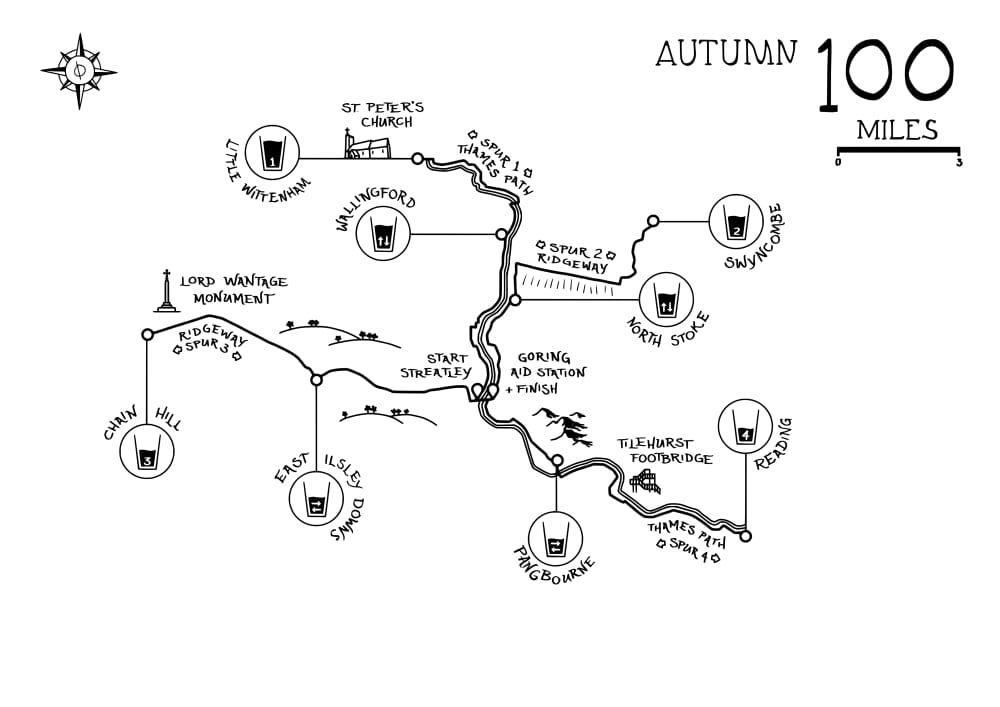
WOMEN
Hannah Rickman: The improvement in Hannah's running over recent years from an already high benchmark has been wonderful to behold. Her last outing at a Centurion event was a win at the 2021 North Downs Way 100, arguably a bit of a break out performance. For, since then, she has gone on to win Ultra Trail Drakensberg 160km, the Spine Summer Sprint, The Northern Traverse and has twice placed second at the Winter Spine full as well as at Lakeland 50. This will be more flatter running than she is used to amongst those races but that shouldn't stop her. The guys better look out.
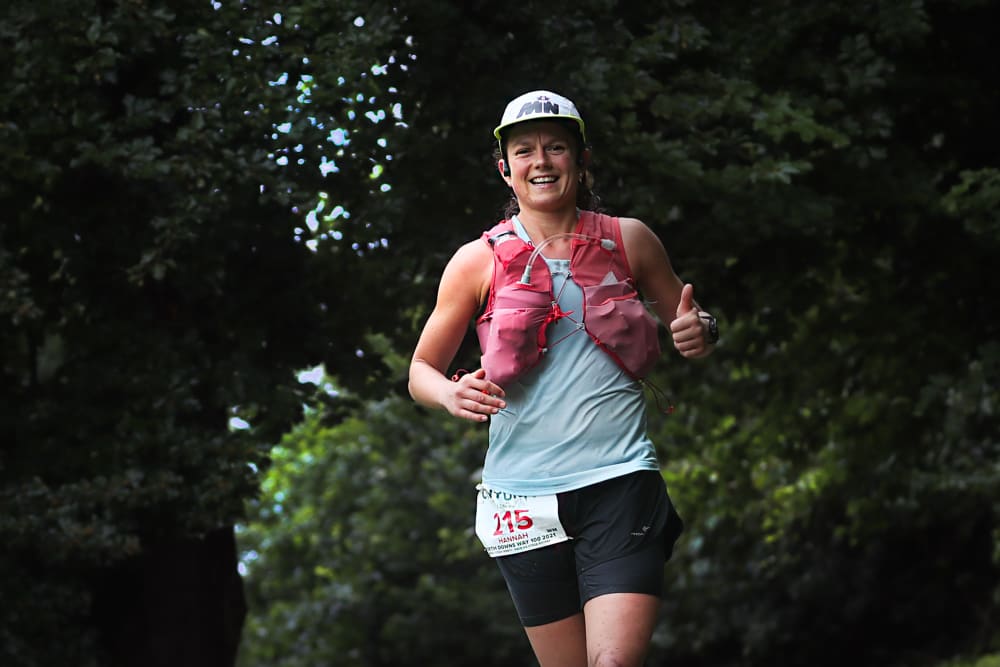
Hannah Rickman
Ali Young: Multiple time GB 24hr Team athlete Ali is one of the most consistent performers in the sport. This year she clocked a 16:20 100 mile split and 220km total distance at Crawley 24hr. Past stand out runs are all at flatter 100 mile+ events and so this race will suit her down to the ground. She has three Spartahlon's to her name with a best of 28:57 for fourth. Four GB 24hr Team vests. A win at Grand Union Canal Race and a 100 mile PB where she also set a national age group record running 15:41 at our Track 100.
Amy-Jo Clarke: Amy-Jo won our Hundred Hills 50km in 2023 and that followed her first Centurion victory which came at the 2022 North Downs Way 50. She also has wins at Race to the Stones and Hurtwood 50km to her name. This looks to be her first 100 miler.
Camilla Mitchell: Has a string of podiums to her name, though all at shorter distances over the last few years. Second at Race to the Stones, winner of the Amersham Ultra 50km and second at the Druids Challenge - which takes in a lot of the A100 course - amongst them.
Anastasia Hounslow: Winner of the Serpent Trail 100km in 2021 and 2022 as well as the Fox Ultra last year.
Jenny Crouch: Second at this years Arc of Attrition, Jenny has also won the Butcombe Ultra twice, the Beacons ultra and placed fourth at the RAT 100km.
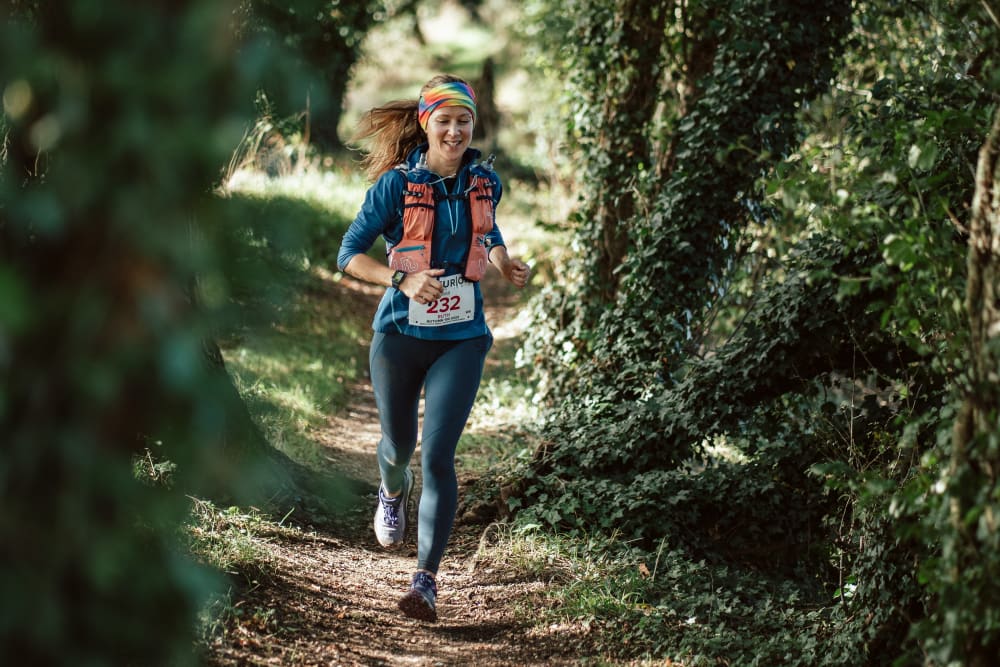
MEN
Matt Gallagher: Matt has become a consistent performer over the 100 mile distance in recent years. Results include at 16:34 here in 2022, a 19:04 at the NDW100 in the same year. A 16:21 at the TP100 in 2021 and a 15:24 at the TP100 in 2023. All of those landed him top ten finishes. The majority of his other shorter ultra performances are also top ten finishes.
Ed Knudsen: So solid over 50 miles, Ed is yet to have his dream 100 but will surely be up for it here. Past NDW50 champion, CW50 champion and with podium and top ten finishes at a range of other ultras over all terrains including and up to the Dragons Back, Ed's back catologue is extensive. His 14th place at the NDW100 this year and 19:22 at this event back in 2017 are not indicative of what he will surely achieve in the near future over 100 miles on trail.
Brady Poskin: Brady ran home fifth at our NDW50 earlier this year in 6:49. The US based runner has enjoyed wins at US events such as Tahoe Rim 50, Badwater Salton Sea and Three Days of Sylamo. At 100 miles he's also had success with solid finishes at Run Rabbit Run and UTMB - in a career which stretches back 50 races+ over a decade or more.
Neil Kempton: Sixth here in 16:22 in 2022, Neil hasn't hit the same heights since but did come home tenth at the Classic Quarter down in Cornwall earlier in this year.
Ciaran Mcaneny: Holds a 100 mile PB of 16:21 set at our Track 100. Some shorter ultra racing so far in 2024 has yielded three top ten finishes.
Damon Hannis: Seventh at the TP100 in 2023 in 16:40.
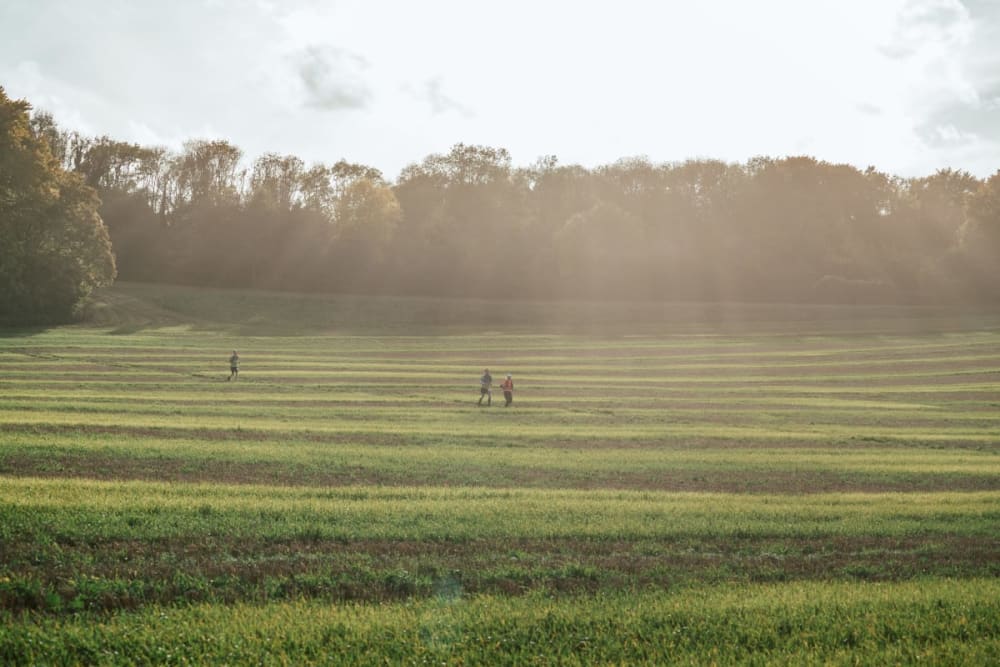
FOLLOW LIVE
Follow the race live via the link here kicking off from 0900 on Saturday 12th October. A huge thanks in advance, as always, to our volunteer team and sponsors without whom none of this is possible.
9 Sep 24 by James Elson
Chiltern Wonderland 50 2024 Race Preview
2024 marks the ninth edition of the Chiltern Wonderland 50. Our third 50 miler of the year and the third in the Grand Slam, the race holds a special place in the hearts of many who are so fond of the route which takes runners out from Goring on Thames, through picturesque villages, remote valleys and an amazing and diverse range of trails.
This years' race starts at 0830 on 21st September and as always you can follow the race every step of the way which will be available from just prior to race day via our live tracking here.
Read on for a quick preview of the likely leading contenders in both the womens and mens events.
WOMEN
Michelle Attridge: Michelle is our 2024 50 mile Grand Slam leader having won the South Downs Way 50 back in April and followed that up with a second at the North Downs Way 50 in May. She’s raced several times internationally in between times and done well in all.
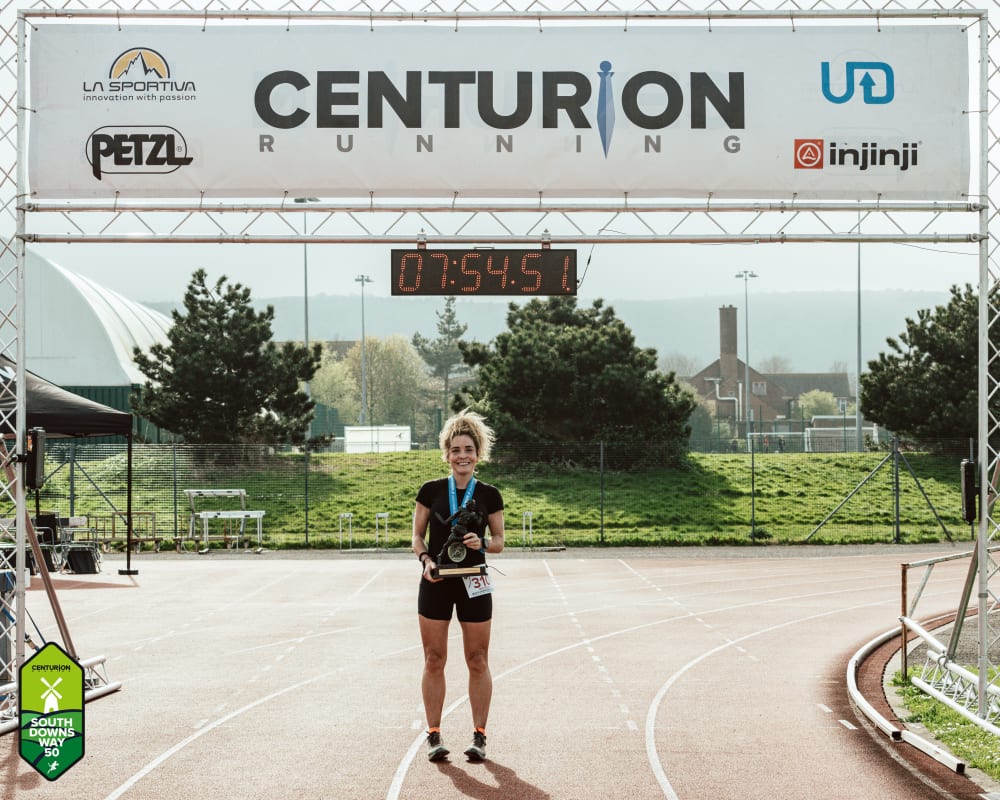
Michelle Attridge
Ally Whitlock: Currently second behind Michelle in the Grand Slam table with a third and a fourth so far this year. She also finished third at the NDW100 last month. Previously she’s finished many of our races in the top ten and on the podium in more recent years including the Autumn 100, Winter Downs 200 and Wendover Woods 100.
Jennifer Wood: Second at our South Downs Way 50 in 2023 in a blazing 7:29. Has previously run 129km+ over 12 hours which puts her firmly in the top ten British female performers in that category.
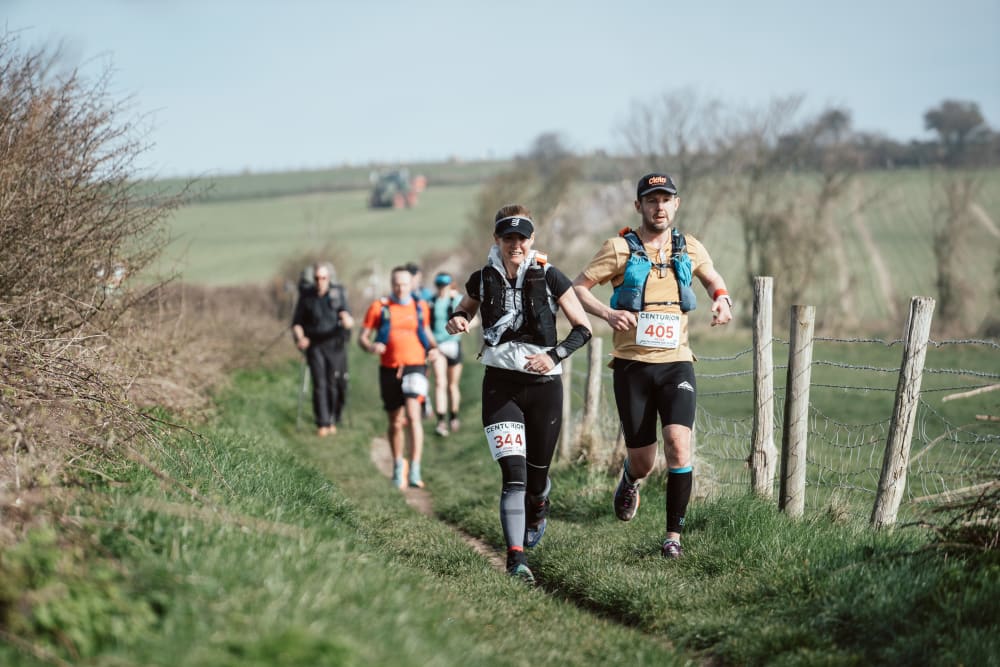
Jennifer Wood
Gemma Game: Finished third at this years MdS and that was her third podium there over the years. Previous winner, podium and top ten finisher at a raft of races both in the U.K. and abroad including most prominently Tenerife Blue Trail and Transgrancanaria Advanced.
Laura McGill: Finished second here last year and third in 2021. Finished fourth at the Autumn 100 in 2023 also.
Helen Moss: Helen finished second at the South Downs Way 50 this year under 8 hours but dropped a little further back in the Grand Slam standings with an 11th at the NDW50 in May. Previous winner of the Chiltern Challenge with XNRG and the Downslink Ultra.
Sharon Walker: Sharon was third at the Thames Path 100 last year in 19:11. Previous podium finisher at Race to the King and Race to the Tower. She finished seventh at the North Downs Way 50 this year.
MEN
Alastair Courtney: Alastair is having quite the year with us. Third at the Hundred Hills 50km in a super competitive field, he went on to win the South Downs Way 50 in 6:27 and took second at the North Downs Way 50 in 6:38. He leads the men’s Grand Slam 50 mile table.
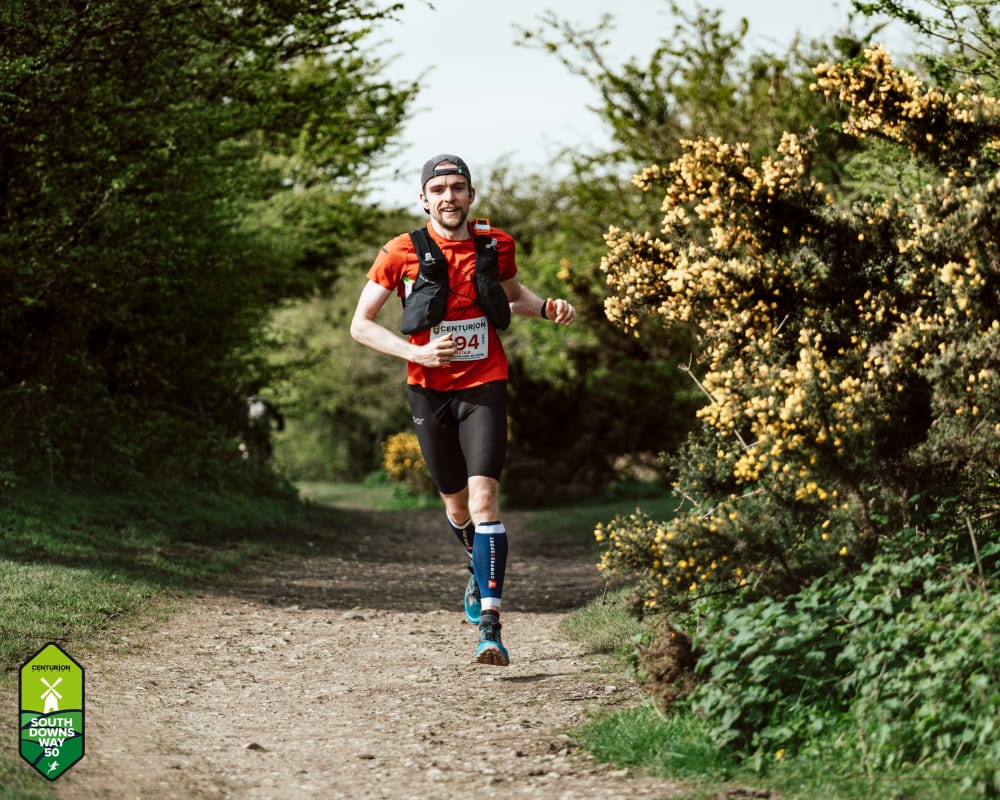
Alastair Courtney
Ben Hall: Ben was third at this years North Downs Way 40 just behind Alistair. He’s previously finished top ten at the SDW50 and won the Pilgrim Challenge.
David I’Anson: Winner of the Druids Challenge and the Oner. He went top ten at the South Downs Way 100 in 17:01 in 2019 and finished in the top ten at the UTS100km in 2021.
Paul Fernandez: Multiple time winner of the Ridgeway Challenge with a best over the 86 mile course of 13:39. Fourth at the North Downs Way 100 in 2020. More recently a winner of the Beast of the Beacons 40 mile race and past winner of the South Wales 50 and Brecon to Cardiff ultra.
Thomas Wright: Fourth at the Wendover Woods 50 in 2022.
Once again you can follow the race every step of the way which will be available from just prior to race day via our live tracking here. Thank you in advance to our wonderful team of volunteers
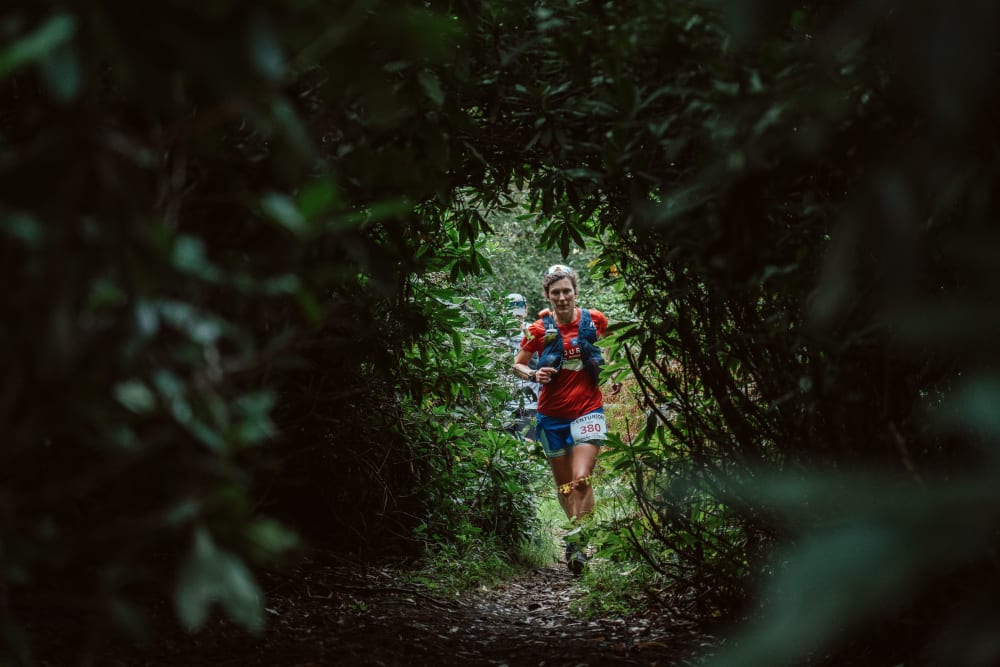
22 Jul 24 by James Elson
NDW100 2024 Race Preview
The North Downs Way 100 comes back around for the fourteenth time! This was our original event back in 2011 and as the pedigree of the race continues to grow we have a stellar field with an eye on the prize - certainly the course records which are some of our longest standing, could be put under threat if conditions play ball.... but that is a big if!
The womens record is held by Debbie Martin-Consani who ran 18:34 all the way back in 2016. Mark Darbyshire was early on in his running career when he seemingly appeared out of nowhere and obliterated the mens course record in 2019, by running 15:18.

WOMENS
Sarah Page: Sarah was our 2023 South Downs Way 100 champion and ran home second later last year at the Autumn 100, her first year of 100 mile races and an impressive one at that.

Sarah Page
Ally Whitlock: Ally is in the midst of running our 50 mile Grand Slam this year and has already recorded a third at SDW50 and a fourth at NDW50 over the first half of the season. Ally has many years of fine results at our events behind her. In 2023 she was third at both the Winter Downs 200 and Wendover Woods 100, arguably the two hardest races we've staged to date. Previously over the 100 mile distance her best was 18:27 for second at the much flatter Autumn 100 in 2022. In 2020 she finished sixth here in 26:45 but there is no doubt she will be looking to go a lot quicker this time.

Ally Whitlock
Anastasia Hounslow: Two time winner of the Serpent Trail 100km and winner of the 2023 Fox Ultra.
Amy Sole: Our 2023 Grand Slam 50 mile Champion, Amy finished in the top ten of all four events in 2023. She also has a second place at the Arc 50 to her name.
Kate Archer: Kate was fifth at the Lakeland 100 in 2023 in a sub 30 hour time which bodes very well for a good run here.
Mary Marshall: Mary was fifth at the NDW50 earlier this spring, which followed a win at the EnduranceLife North Cornwall 50km back in January.
Sophie Brownlee: Sophie looks to have podiumed at each of the six ultras she has to her name. Those races include Race to the Castle, the South West Traverse and then in 2023 her longest race to date - the Devon Coast to Coast over 112 miles.
Kim Loney: Two ultra distance wins already this year and plenty more in the past, mainly in the Yorkshire and Northumbria racing scene. This years wins include the Pennine Journey North Ultra and Ripon Stinger. This looks to be her first 100 miler.
Emily Newton: Has been a prolific racer since stepping into ultras in 2021, including plenty of wins, podium and top ten finishes. Stand out results include a 7:24 over 50 miles at Manchester to Liverpool. Has a finish at the Arc of Attrition to her name too.
MENS
Geoff Cheshire: Geoff bounces into this one after dropping from the South Downs Way 100 this past June, where he led over the first 40 miles. He is the course record holder at the Autumn 100, where he ran 13:58 in 2023. He also won the Thames Path 100 last year in 14:18. In 2021 he ran 17:07 here to finish second behind only Hungarian international Norbert Mihalik. He will be very hungry to get this one right!

Geoff Cheshie
Richard McDowell: Rich is our Thames Path 100 course record holder where he ran 13:43 in 2021. That year he also won the South Downs Way 50. In 2022 he won our South Downs Way 100 in 14:49. Both of his 100s to date have not, however gone to plan. Rich's background is on the road and track where he has had a glittering career. A marathon PB of 2:23, he ran 2:28 at London this year - it's his consistency which is most impressive. He will certainly be looking at targetting the course record here.
Ryan Whelan: It is rare that we welcome back the previous years' first and second place finishers but that is the case this time. Ryan pipped Joe Ackerley by less than the lap of the track in 2023 to take the win in 17:07. This year is off to a great start with a 146km+ effort for the win at the Taipei 12 hour. The Hong Kong based athlete has years of fine results behind him mostly in that territory.
Joe Ackerley: Finished 87 seconds behind Ryan last year in the closest finish we've ever seen here, to finish second in 17:08.

Ryan and Joe go 1,2 in 2023
Ed Knudsen: Ed's pedigree is deep and he knows this trail well. He has finished the NDW50 three times including a win in 2022 in 6:55. Previous CW50 champion in 6:34 alongside a raft of other strong runs. He is also no stranger to long events with two of our 100s featuring in the earlier part of his ultra career, but this is his first step back up to the distance in a while.

Mauro Persic: Sixth at the 2023 Arc Of Attrition, twice in the Top Ten at Istria by UTMB - the 100 mile distance which attracts an international calibre field. At least 20 Top Ten ultra finishes at all distances and terrain types over the past four years.
Jamie Pugh: A member of our coaching staff here at Centurion, Jamie brings his world class expertise to our team. But he is also a fine runner in his own right. He ran home sixth at our highly competitive Hundred Hills 50km back in March before running a PB of 7:20 over 100km in Sweden in April.
FOLLOW THE RACE
Follow the race live from 0700 3rd August via the Live Tracking (available here from 1st August) and our Instagram Channel.









